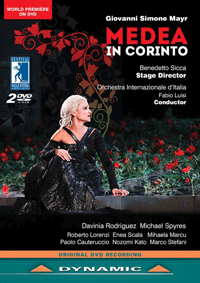September 30, 2017
Aida opens the season at ENO
Of McDermott’s Satyagraha in 2010, one of my colleagues wrote, ‘There are so many amazing images in this production that it’s hard to take them all in at once’. Here, it’s more a case of there are so many diverse visual images that it’s hard to make them come together in any coherent way.
The sets do establish an ‘epic’ mood: coarse-grained rock textures suggest monumental edifices and set off Pollard’s striking fabrics, face-paint and fabulous headdresses (topped with antlers in Act 2!). Bruno Poet’s lighting design is one of the best things about the production. On the poster advertising this opening production of ENO’s 2017/18 season, a blade of light slices through darkness, bouncing off granite to bathe a standing woman, who gazes aloft as if in supplication, in a cone of light. A similar triangle of red dissects the black drop which confronts us at the start, gradually widening and opening up a small geometric space on the wide Coliseum stage. Throughout, Poet sculpts his light like sliding walls, to create mystery. Sometimes diagonal rays sear across the stage; at other times subtle mists shimmer.
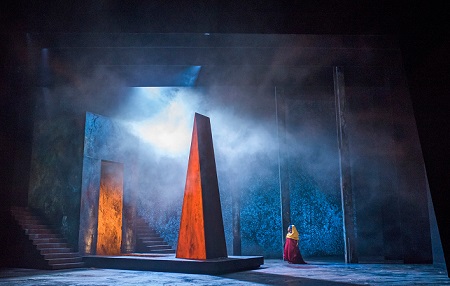 Latonia Moore (Aida). Photo credit: Tristram Kenton.
Latonia Moore (Aida). Photo credit: Tristram Kenton.
A prevailing hieroglyph - the ‘breadcone’, designating a ‘gift’ or ‘offering’ - evokes a pyramid. But, that’s just about the only hint of Egypt we get. For, while the visuals are spectacular, they don’t help to ‘tell the story’, and there is no coherent sense of context. A programme article explains McDermott’s thoughts about the period setting, which he describes as ‘a slight mash up’: ‘It’s not ancient and it’s not modern. I’m not dissing the past, but we’ve got modern battle gear and yet priests and temple dancers too. It’s its own world, like a dream which is not real but has its own logic and you can do anything with that as long as you stay within the logic.’
The allusions are indeed eclectic, but I’m not sure I could recognise their ‘logic’. Radamès first appears wearing a gilt braided blue tunic, topped with fur pelisse, worthy of a Napoleonic Hussar, but in the fateful tomb he has ditched his uniform for a grubby grey shirt. The participants in the sacred ritual which prepares the Egyptian general for battle against the Ethiopians seem to have been modelled on the semi-clad women who sit behind the windows of Amsterdam’s red-light district, while the celebrants at the victory procession sport an array of outlandish 30s-style outfits. The priestesses of Isis who await the wedding of Amneris and Radamès look like they have borrowed their red robes from Margaret Atwood’s Handmaids. Amneris herself seems to have got trapped in an outsize origami confection.
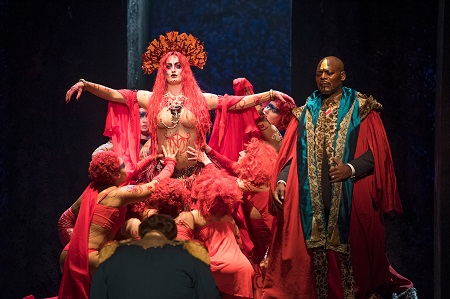 Eleanor Dennis (High Priestess), Robert Winslade Anderson (Ramfis) and members of Mimbre. Photo credit: Tristram Kenton.
Eleanor Dennis (High Priestess), Robert Winslade Anderson (Ramfis) and members of Mimbre. Photo credit: Tristram Kenton.
Within this smorgasbord of references there is little sense of who the protagonists are, of the love triangle between them, or of the context which pits their love against their loyalty. Static visual images have taken priority over the development of character and relationship. There is scarcely any convincing interaction. The programme offers an account of McDermott’s rehearsal methods: he has encouraged his cast to ‘explore three options: stand still, move forward, or move backwards’.
Most seem to have plumped for the first option. Singers barely look at each other or engage physically; instead, on the whole they stand stock still, facing the audience. Basil Twist’s beautiful silks flutter and billow but the only other movement on stage comes from the dancers and acrobats of Mimbre, who entertain Amneris when she prepares to welcome home Radamès by tumbling light-footedly or forming geometric human sculptures. In the triumphal scene, some of the latter look so complex and potentially precarious that perhaps they should come with a warning, ‘don’t try this at home’.
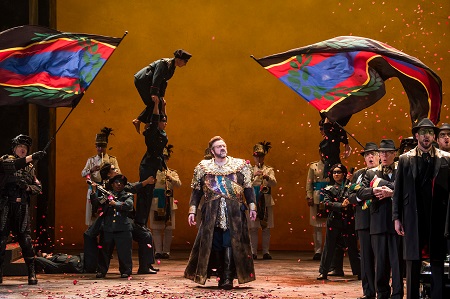 Gwyn Hughes Jones (Radamès), members of Mimbre and ENO Chorus. Photo credit: Tristram Kenton.
Gwyn Hughes Jones (Radamès), members of Mimbre and ENO Chorus. Photo credit: Tristram Kenton.
We have no elephants, but there is some flag-waving and coffin-carrying - and, some terrific trumpet playing from the six onstage players whose gorgeously warm tone glows with an energy that is missing among the artfully positioned but static throng. Indeed, the ENO orchestra play consistently well for Canadian conductor Keri-Lynn Wilson who balances vigour and refinement, injects tension effectively and conjures exoticism and magic at the start of Act 3. The enlarged ENO Chorus produced some beautiful hushed, reverential singing in Act 1.
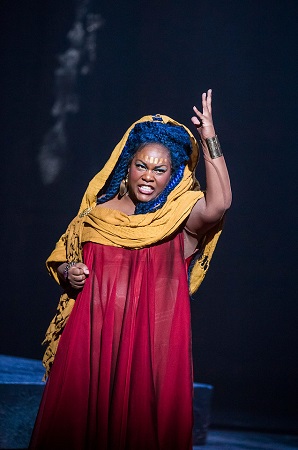 Latonia Moore (Aida). Photo credit: Tristram Kenton.
Latonia Moore (Aida). Photo credit: Tristram Kenton.
ENO is fortunate in that they have an eponymous Ethiopian princess whose glorious soprano gleams with an intensity to match Poet’s beams of light. American Latonia Moore is simply fabulous: she soars above the rest of the cast - literally and figuratively. When she commenced ‘Ritorna vincitor’, she made one immediately sit up and listen: for the first time we had persuasive, genuine human emotion, and as the performance developed she showed that from the gentlest pianissimo to the plushest fortissimo she could make us believe unwaveringly in Aida’s devotion, defiance, despair and dignity. ‘O patria mia’ was infused with strength and sincerity, and if she seemed a little nervous about the top C that could be forgiven. In Aida’s duet with Amneris, Moore’s soprano blazed radiantly and effortlessly.
Gwyn Hughes Jones’s tenor has plenty of ringing vibrancy. His Radamès is a plausible soldier and makes a confident entrance, sustaining the final Bb well in ‘Celeste Aida’. Even more shine at the top might help to convince us of his passion for Aida and give fervour to his confrontation with Amneris, but Jones has the stamina for the role and the Tomb Scene intimacy is moving, the poignancy of the lovers’ short-lived reunion deepened by the presence of Amneris, watching from above.
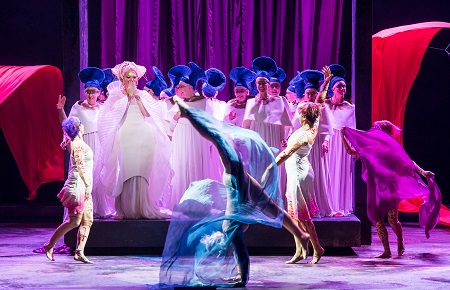 Mimbre and Michelle DeYoung (Amneris). Photo credit: Tristram Kenton.
Mimbre and Michelle DeYoung (Amneris). Photo credit: Tristram Kenton.
As Amneris, mezzo Michelle DeYoung seemed to be struggling. Certainly, her Act 1 costume was ‘larger-than-life’ but vocally DeYoung was too ragged and unfocused to convey the tragic princess’s conflicted emotions. It didn’t help that some distorted vowels made the clunky English translation even more cumbersome. De Young’s characterisation was unmodulated and somewhat superficial, though her voice did relax and begin to bloom in the Judgement Scene.
Eleanor Dennis was poised and imperious as the High Priestess, and Robert Winslade Anderson (deputising for the indisposed Brindley Sherratt) and Matthew Best were more than competent as Ramfis and the (white-suited?) Egyptian King respectively. Musa Ngqungwana’s Amonasro wasn’t quite imposing enough; a bit more patriarchal authority was needed.
Whatever misgivings there may be about McDermott’s ‘logic’, if there’s one reason to see this show, it’s the opportunity to hear Moore in a role she has sung to great acclaim many times, including at the Met and the ROH, for her performance confirms her as a lirico spinto of great distinction.
Claire Seymour
Verdi: Aida
Aida - Latonia Moore, Amneris - Michelle DeYoung, Radamès - Gwyn Hughes Jones, Ramfis - Robert Winslade Anderson, Amonasro - Musa Ngqungwana, King - Matthew Best, High Priestess - Eleanor Dennis, Messenger - David Webb; Director - Phelim McDermott, Conductor - Keri-Lynn Wilson, Designer - Tom Pye, Lighting designer - Bruno Poet, Costume designer - Kevin Pollard, Silk effects choreographer - Basil Twist, Movement director - Lina Johansson, Chorus movement - Elaine Tyler-Hall, ENO Orchestra and Chorus, Mimbre Skills Ensemble.
English National Opera, Coliseum, London; Thursday 28th September 2017.
image=http://www.operatoday.com/ENO%20Aida%20Cast%20and%20Chorus%20%28c%29%20Tristram%20Kenton.jpg image_description=Aida: English National Opera product=yes product_title=Aida: English National Opera product_by=A review by Claire Seymour product_id=Above: ENO Cast and ChorusPhoto credit: Tristram Kenton
September 28, 2017
La Traviata in San Francisco
Romanian soprano Aurelia Florian sings Violetta in all ten performances (through October 17). She is young and pretty, her voice is strong and rich throughout all registers, and her high notes are splendid (she does not take the optional high E flat in the “Sempre libera”). Verdi famously wanted a real woman for this role, a woman who could actually suffer. Mme. Florian does indeed suffer, if as a heroine of opera’s coming verismo. In Verdian terms la Florian’s Violetta is far from the proto-verismo of his delicate Desdemona, hers is more his decisive Lady Macbeth.
Most of all Mme. Florian greatly pleases us as an excellent singer. That she is also a suffering mid 19th century courtesan is less compelling.
Alfredo, the Brazilian tenor Atalla Ayan, is an excellent singer as well. His voice is wonderfully even throughout its registers, its tone more decisive than rich. He offers his arias with a vocal enthusiasm that is infectious, easily projecting his vibrant emotions.
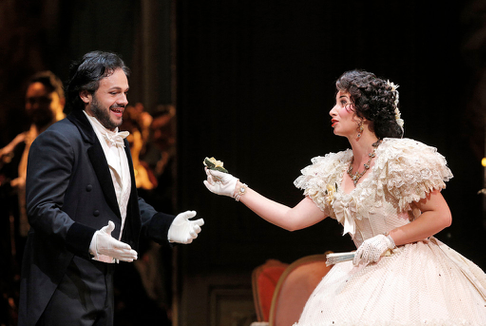 Atalla Ayan as Alfredo, Aurelia Floria as Violetta
Atalla Ayan as Alfredo, Aurelia Floria as Violetta
In the first act both singers easily found their characters, Violetta seated alone in her grand salon to contemplate her “Ah fors’è lui,” then to burst onto her balcony to deliver its antithesis, Alfredo, behind the scene, grandly intoning his ardor.
The second act became difficult, the complex turns of the plot demand subtle development of character and emotion, here the actors were exploiting the fine movement of their voices, leaving the unfolding tragedy to find its own way. The loss of dramatic focus was most evident in the Germont of young Polish baritone Artur Ruciński. Mr. Ruciński is an extraordinary singer, able to gloriously project text in musical line, providing enormous satisfaction to his listeners. But he did not achieve the warmth and maturity and the deep humanity of this sympathetic, honest man trapped in provincial morality.
The Copley production in this fifth edition staged by Shawna Lucey became clumsy in the gambling scene, the chorus and ballet cumbersome, and the showdown (Alfredo humiliating Violetta) pallid. Without having deepened and exploited the opera’s personalities the death scene read as incidental.
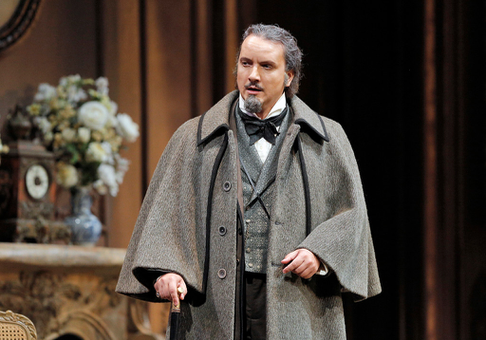 Artur Ruciński as Germont
Artur Ruciński as Germont
Meanwhile conductor Nicola Luisotti was finding every palpitation of emotion in the score, the strings of the San Francisco Opera orchestra choking with emotion in the overture, the clarinet solo unabashedly sobbing while Violetta writes her note to Alfredo, the enormity of the tragedy welling up in the death scene, the finality of death hammered in the final, magnificent roll of the tympani.
In concert with the truly excellent singing the magnificence of the Luisotti orchestra trapped this evening into inexplicable musical and dramatic frigidity.
As Verdi wished (and was initially denied) the Copley production sets the action in 1852 or so. Verdi wanted the contemporary moment. Of course it is now 2017. Our contemporary moment is of great complexity, and of a breadth far beyond the concerns of Verdi. It is a fascinating question how to stage a timeless work of art in a production that recognizes, respects and exploits the artistic and moral accomplishment of the intervening 150 or so years.
This production marked the first time supertitles were used for La traviata at San Francisco Opera. The supertitles were created by Jerry Sherk (SFO’s then production manager, now legendary). They tell the story simply and easily in the abstract manner of supertitles of that era. It is time to create new supertitles for future productions that echo the rhythms of the phrases as they are sung.
It should be mentioned that sloppy masking in the first act allowed an annoying, blinding light from a stage manager’s desk to escape into the house.
Michael Milenski
Cast and production information:
Violetta Valery: Aurelia Floria; Alfredo Germont: Atalla Ayan; Giorgio Germont: Arthur Rucinski; Flor Bervoix: Renee Rapier; Gastone: Amitai Pati; Baron Douphon: Philip Skinner; Doctor Grenvil: Anthony Reed; Marquis d’Obigny: Andrew G. Manea; Annina: Amina Edris. Chorus and Orchestra of the San Francisco Opera. Conductor: Nicola Luisotti; Production: John Copley; Stage Director: Shawna Lucey; Set Designer: John Conklin; Lighting Designer: Gary Marder; Choreogorapher: Carola Zertuche; Costume Designer: David Walke. War Memorial Opera House, San Francisco, September 26, 2017.
image=http://www.operatoday.com/Traviata17_SFO1.png
product=yes
product_title=La Traviata in San Francisco
product_by=A review by Michael Milenski
product_id=Above: Aurelia Florian as Violetta [All photos copyright Cory Weaver, courtesy of San Francisco Opera]
September 26, 2017
The Judas Passion: Sally Beamish and David Harsent offer new perspectives
Librettist David Harsent notes that there is no doubt that Judas’s betrayal led to Christ’s death, but begs us to ask, what did Judas believe was his ‘purpose’? After all, if he had not ‘fulfilled’ this role, chosen or predetermined, mankind would not have been saved. David Harsent professes that his own aim was to ‘write Judas out of hell’, ‘to set him before an audience and bring him to a new judgment’.
Beamish and Harsent purport to present the Passion story from the perspective of Judas Iscariot, but this is not really what they do. Or rather, at times do they seem to offer Judas’s understanding of his role, but this is set against a single question which is reiterated and rephrased throughout - ‘Does Judas choose, or is he chosen to betray Christ?’ Moreover, ‘Do we following the callings of our own heart - or the callings of whatever voice we choose to name, God’s voice, or the Devil’s’?
In accordance with this ambiguity, the Devil and God sing in rhythmic unison: countertenor Christopher Field and bass William Gaunt were designated both roles. As Mary Magdalene relates, ‘And the Devil went into Judas, the Devil or God’.
Indeed, ambiguity prevails. There is little to distinguish between any of the protagonists, other than Christ, Judas and Mary Magdalene, and in fact towards the close the former two men are intimated to be kindred. The entire cast are dressed in black and individuals such as Peter (bass Dingle Yandell) and the two Thieves (tenor Hugo Hymas and bass Jonathan Brown) emerge from and are reintegrated into the Chorus (which is at times split in two). I guess the idea is that the players in the drama could be anyone, historic or present, involved by chance in momentous events, powerless to change the course of mankind’s predetermined narrative.
There are no philosophical musings which might essay an answer at the posed questions; as I’ve suggested above, at times the libretto seems to suggest that there is no question to answer. In the opening scene, Judas is a reluctant participant when asked to name his price for betraying Jesus: ‘I do it because I must […] I do it because it fell to me. His hand on mine’; words that are repeated time and again, through to the final scene. And, unlike the other disciples who probe, ‘Is it me?’, he stays silent at the Last Supper. God and the Devil declare in rhythmic unison, ‘He is chosen … the man is already chosen’. In his programme article, Harsent refers to an extant Gospel of Judas, dated at 3 or 4 CE, ‘a Gnostic text found in Middle Egypt around 1978’ which was published in 2006 and from which he takes a single line: when Jesus calls the disciples to him none save Jesus can hold his gaze, ‘whereupon Jesus tells Judas: “You are the best of them, for you will free me of the man who clothes me.”’ From this, Harsent suggest we may infer that ‘Judas was born to the task’.
Perhaps the potential philosophical complexities cannot be satisfactorily pursued within a simple dramatic form? Beamish’s Passion is not really an opera, despite the involvement of a ‘stage director’, Peter Thomson, or an oratorio; nor is it a ‘Passion’ in the mould of Bach, despite the baroque instrumentation (strings, lute, flutes plus a very twentieth-century percussion collection), the use of polyphonic forms (canons, fugues) and recitative- and aria-like episodes, and the incorporation of fragments of the St Matthew Passion.
I was at first put in mind of Britten’s Church Parables: indebted to Japanese noh plays, they present drama and stage movement with a similar slow-motion solemnity to that adopted by Thomson. Progressively, though, Britten’s Rape of Lucretia seemed a closer model: it also has a framing Male and Female Chorus - the latter role here is represented by Mary Magdalene - who sometimes intervene in the action and present abstract ethical and philosophical sentiments. So, Harsent’s opening male Chorus denounce Judas, ‘Better that man had not been born who sold his soul, who gave himself up to Satan, who bartered the Son of Man, who made a deal with darkness’, while Britten’s Male and Female Chorus tell us that ‘We’ll view these human passions and these years/ Through eyes which once have wept with Christ’s own tears.’
The problem with Harsant’s libretto is that it becomes predictable, and often seems to follow its biblical model. More imaginative engagement with the Passion stories can be found in John Adams’ and Peter Sellars’ The Gospel According to Mary which presents the story of the Passion through the eyes of those whose tales are usually unheard: Mary Magadalen, her sister Martha and their brother Lazarus. And, there are several recent literary explorations, notably Colm Tóibín’s The Testament of Mary.
Moreover, though it is evocative at times, I found Beamish’s score pretty predictable too. The writing for the chorus is largely declamatory, and incorporates some Chassidic chanting, but there is little variety of timbre or manner. There is effective writing for the strings - alternating glacial ethereality with pungent chordal and pizzicato stabs - and the flutes and lute offer delicacy and grace. But, the strident natural horns and trumpets, as the cock crows, were all too foreseeable. Similarly, the percussive effects, such as real hammers, whips and nails alongside slapsticks to provide an aural complement for the text’s uncomfortable imagery - ‘on his head a cap of thorns driven hard into the skin’; ‘with ropes and winches and hammer and nails and flesh, They nailed him, then hauled him up’ - and the centre-piece ‘Judas Chime’ constructed from 30 ‘pieces of silver’ are pictorial but unsubtle.
The inclusion of the figure of Mary Magdalene - sung with radiance and fierce focus by Mary Bevan - is one of the strengths of the libretto and score. Magdalene is the only figure on stage at the close, and her final question, ‘If he can’t be saved, who can be saved? If he can’t be forgiven, who can be forgiven?’, is provocative and penetrating. Not only does this inclusion of a female role provide timbral and registral contrast, but the role of Mary Magdalene also offers a more objective, calmer perspective on the events that we witness unfold. She comments in the past tense, as the participants enact their roles in the present (though this effective distinction is blurred at times, as when Mary interacts with Peter in the denial scene).
Mary’s vocal line also incorporates expressive melisma in contradistinction to the prevailing syllabic motion of the other parts, most effectively in ‘Who Do You Say I Am?’, when she reminds us that though the Chorus tell of Jesus’s reputation as a ‘prophet’ and ‘man of miracles’, there were those who called him blasphemer, fool, lawbreaker. When the Chorus accuse Christ of ‘Blasphemy!’ and throw their shrill demands, ‘Crucify him!’, Mary reminds us of the miracles performed.
Brendan Gunnell’s Judas pins us with a penetrating upper register that is as captivating as his stern stare. There is a moving moment when the angularity of the melodic intervals - ‘My face on these coins, my name on them. For all time: my face, my name’ - gives way to the stillness of repeated pitch, ‘his blood’. I was confused, though, as to why Judas, in Harsent’s words, ‘in effect - stands in for Pilate’ in the scene when Christ is brought before the Roman prefect of Judaea: Judas is, as the syllabic chanting of his name in the opening scene reinforces, a Jew; Pilate is not. And, why does Judas/Pilate sometimes speak his own words, while at other times they are reported by Mary, as if retrospectively?
Roderick Williams struck the right balance between serenity and suffering, as Jesus. It must have been quite an emotional shift taking on this role in between his embodiment of Mozart’s bird-catcher at the Royal Opera House , though both dramas involve much magic and miracle. Williams’ delivery suggested both gravitas and humanity. In the second scene, ‘The Last Supper’, he stood at the rear, forcing the Chorus to turn towards him and subtly implicating us as members of his audience; in ‘The Agony in the Garden’ he stood at the front, fixing us with an intent gaze.
There are some moments of affecting dramatic intensity. Towards the close, Jesus and Judas stand at the rear of the stage, backs turned (to indicate their dying and death), and sing together, ‘My God, why are you lost to me?’. But, the incisiveness of the moment is lost as Judas slips back into what might be seen as self-justifying repetition (though, as I’ve suggested, the ethical questions are not truly explored): ‘What I did I was chosen to do. What I have I was asked to give. What I lost I was told to lose. My only purpose, his death and mine.’
I felt that there was a dissipation of intellectual intensity towards the close, as the text slipped towards sentimental abstractions. When Mary and the Chorus sing, ‘His death … our salvation … this and only this.’, I felt we were back in Lucretia territory - specifically Ronald Duncan’s dreadfully woolly epilogue: ‘Is it all? Is all this suffering and pain,/ Is it in vain? … Is this all loss? Are we lost? … Is it all? Is this it all?’
The noble Classical columns of St John’s Smith Square should have provided the perfect setting for The Judas Passion (the work had been premiered the previous evening in Saffron Walden), and it was pleasing to see the church nave full for this performance of a challenging new work. However, SJSS’s sightlines are poor and seated to the rear I struggled to sustain my view of and engagement with Thomson’s stage action. Fortunately, the cast’s diction was uniformly good for it was not possible to read the libretto, usefully provided, in the dimmed lighting, and the two surtitle screens were obscured by the imposing pillars.
At the close, the Devil and God pronounce, ‘Chosen for this: born to this: his only purpose …’ A troubling statement, and one which Beamish and Harsent reiterate but do not really interrogate.
Claire Seymour
Sally Beamish: The Judas Passion
Mary Magdalene - Mary Bevan, Brendan Gunnell - Judas, Roderick Williams - Christ; Orchestra and Choir of the Age of Enlightenment: Nicholas McGegan (conductor), Peter Thomson (stage director).
St John’s Smith Square, London; Monday 25th September 2017.
image=http://www.operatoday.com/3251-sallybeamish___credit__ashley_coombes.jpg image_description=The Judas Passion: St John’s Smith Square product=yes product_title=The Judas Passion: St John’s Smith Square product_by=A review by Claire Seymour product_id=Above: Sally BeamishPhoto credit: Ashley Coombes
September 25, 2017
Choral at Cadogan: The Tallis Scholars open a new season
This, and the striking opening of the first piece, Palestrina’s motet Laudate pueri, set me ruminating about nature of an ‘ensemble sound’, and although the following tangential digression might be a little indulgent, it is not irrelevant to my experience and review of the music performed.
The Tallis Scholars’ website lists the following six personnel as ‘The Singers’: soprano Amy Haworth (who first sang with the group in 2005), soprano Emma Walshe (2010), alto Caroline Trevor (1982), tenor Steven Harrold (1993) and basses Robert Macdonald (1994) and Tim Scott Whiteley (2007), only four of whom were performing on this occasion. Any long-standing ensemble, instrumental or vocal, will inevitably have a flexible constitution over time: indeed, Harrold’s first sustained spell was from 1996 to 2001 (in 1998 he replaced John Potter in the Hilliard Ensemble, the members of which remained unchanged from then until the group disbanded in 2014) and has recently re-joined the Tallis Scholars. And, the distinctive and defining ‘sound’ of a group will principally be shaped by the predilections and practices of its director or conductor. Peter Philips founded The Tallis Scholars in 1973 and has now appeared in almost 2000 concerts with the ensemble.
However, on this occasion I found that some individual voices were more conspicuously discernible than I had expected and that, particularly in the first half of the concert, The Tallis Scholars did not always coalesce the imitative polyphony into a homogenous sonority, or capture the ‘impersonal’, transcendent beauty of music which is designed to sound, literally, as if it comes from another ‘world’, the heavens.
Perhaps, it was simply that these are early days in the new season; I wondered how much time the group had had to rehearse (some eyes were at times quite wedded to the score) and the works performed did represent some of the rarer reaches of this repertory. But, at the risk of being accused of ‘nit-picking’, I felt that even visually the ensemble did not consistently present a ‘united front’. In other contexts, I have admired bass Greg Skidmore’s relaxed engagement with the music sung (indeed, I drew attention to this quality during a recent performance by Ex Cathedra here at the Cadogan Hall) but on this occasion his tendency to use only one hand to hold the score suggested a casual insouciance which sometimes jarred with the more formal comportment of most of the other singers.
Digression over. But, such thoughts were in my mind during what was a festive but not particularly reverential performance of Palestrina’s Laudate pueri, in which the tuning took a while to settle and the high soprano and tenor lines were often very prominent (admittedly the textures of this motet are constantly changing), but which also shone warmly when the text praised the Lord ‘high above all nations … his glory above the heavens’, reflecting Palestrina’s magnificent ‘architecture’.
The singers’ rearranged their semi-circle in descending pitch order after the ‘double choir’ position adopted for the opening motet, and the gentle soprano and alto entries at the start of the first part of Palestrina’s Virgo prudentissima did create an air of wonder and veneration. As the other voices joined the seven-part polyphony, there was a calm fluency and ease. Philips’ gestures were small but guided the ensemble skilfully towards the culminating cadences, although there was a sense of ‘searching’ for the intonation of the final cadence.
The more decorative melodic style and exploratory dissonances of Monteverdi’s Messa a quattro voci da cappella of 1650 seemed to suit The Tallis Scholars better. The text repetitions of the Kyrie had a stirring cumulative energy, though I’d have liked a few more consonants, especially from the sopranos. In the Gloria there was a vivacious sense of release as the homophonic ‘Gratias agimus tibi’ blossomed into vibrant polyphony, ‘propter magnam gloriam tuam’ (We give thanks to thee for thy great glory), and the declaration ‘Quoniam tu solus Sanctus’ (For thou only art Holy) inspired a fresh impetus, before coming to rest with an ‘Amen’ of assured contentment.
The Credo’s opening address to the almighty Father, ‘Maker of heaven and earth, and of all things visible and invisible’, was wonderfully lucid, leading to a cadential statement, ‘by whom all things were made’, which was reverently hushed. Reflection on Christ’s suffering and death at the hands of Pontius Pilate prompted some striking dissonances in the inner voices, but the ensuing major key and melismatic ascents brightly conveyed joy at the resurrection. After the Credo’s extended and florid ‘Amen’, the basses’ slow stepwise descent established a soothing serenity at the start of the Sanctus but the ‘Hosanna’ had a vigour and warmth that overflowed into the following Benedictus. At the close of the Agnus Dei, though, stillness and peace were restored.
Despite Cadogan Hall’s ecclesiastical origins (it opened in 1907 as a New Christian Science Church designed by Robert Fellowes Chisholm) its acoustic is rather drier than that of the Venetian churches where Monteverdi’s masses would have first been heard, but The Tallis Scholars were successful in bringing their ten voices together to evoke a spatial magnificence and magnitude. It was a pity, therefore, that some felt it necessary or appropriate to applaud between the movements of the Mass.
After the interval, there was a crowd-pleaser, Allegri’s Miserere (in its ‘top C’ version) for which tenor Simon Wall climbed to the gallery above the stage to deliver the cantor’s phrases, while four singers placed in a balcony at the rear provided antiphonal interaction with the SSATB group on the platform. The timbre was quite light of weight, and the pristine tone of the soprano’s top Cs - perfectly tuned - rang beautifully, although some of the decorative flourishes felt a little rushed in descent (and some unfortunate coughing in the Hall disturbed the tranquillity so deftly sculpted by Philips).
Gesualdo’s O vos omnes and Aestimatus sum (Tenebrae Responsories for Holy Saturday) offered the composer’s customary harmonic twists and turns, and the semitone movement in the inner parts at the chordal start of O vos omnes did unsettle the intonation, but there was a wealth of colour and varied dynamic contrasts in this sombre performance, and a moving progression from darkness to light with the request ‘et videte dolorum meum’ (look upon my sorrow). The text of Aestimatus sum speaks of descending into the darkest pit and Philips gave us real drama: the running bass provided strong direction at the start, and pictorial flourishes in the final section, while a torturously curling dissonance resolved securely to suggest release, ‘inter mortuos liber’ (free among the dead).
Four of Monteverdi’s motets closed the programme. The word-painting was rendered clearly: the chromatic descent at the start of the five-part Crucifixus was sharply defined and darkly lamenting to convey Christ’s suffering and burial, while the long-held notes which open Adoramus te suggested awestruck devotion before flowering into a spirited blessing, ‘benedicimus tibi’. Monteverdi was no less ‘experimental’ than Gesualdo in his harmonic journeyings, and the major/minor sleights of hand in the latter motet were expressive and well-controlled; the final plea, ‘Miserere nobis’, had a focused sincerity. Domine, ne in furore had terrific rhetorical energy but closed with a poignant softness, ‘led tu, Domine, usquequo?’ (but, Lord, how long?).
These Monteverdi motets had been preceded by the well-known eight-part Crucifixus by Antonio Lotti (1667-1740). The rich, pungent blend of the opening seemed almost to mimic the organ which would have originally accompanied the singers, as the suspensions piled up and the inner voices wound through the dissonances.
Like Allegri, Lotti is known principally for one work, this Crucifixus (which actually forms part of a longer work, the Credo in F for choir and orchestra from the Missa Sancti Christophori). Ever keen to explore musical by-ways Philips selected another of the composer’s Crucifixuses, this time in ten parts, for his encore. I’m not a great fan of encores, especially when a programme has been thoughtfully designed, as this one clearly had: I’d have preferred to go out with the joyful repetitions of Cantate Domine ringing in my ears. ‘Cantate et exultate et psallite/ in cithara et voce psalmi’ (Sing and exult and rejoice with the lyre and the voice of psalmody) seemed to sum things up nicely.
Claire Seymour
The Tallis Scholars - Peter Phillips (director), Amy Haworth, Emma Walshe, Emily Atkinson and Charlotte Ashley (sopranos), Caroline Trevor and Helen Charlston (altos), Steven Harrold and Simon Wall (tenors), Simon Whitely and Greg Skidmore (bass).
Palestrina - Laudate pueri, Virgo prudentissima; Monteverdi - Messa a quattro voci da cappella; Allegri - Miserere; Gesualdo - O vos omnes, Aestimatus sum ; Lotti - Crucifixus (à 8); Monteverdi - Crucifixus, Adoramus te, Domine ne in furore, Cantate Domine.
Cadogan Hall, London; Friday 22nd September 2017.
image=http://www.operatoday.com/Tallis%20Scholars%20Nick%20Rutter.jpg image_description=Choral at Cadogan: The Tallis Scholars directed by Peter Philips product=yes product_title=Choral at Cadogan: The Tallis Scholars directed by Peter Philips product_by=A review by Claire Seymour product_id=Above: The Tallis Scholars with Peter Philips (centre)Photo credit: Nick Rutter
September 24, 2017
Stars of Lyric Opera 2017, Millennium Park, Chicago
The Lyric Opera Orchestra and the Lyric Opera Chorus, under the direction of Sir Andrew Davis and Michael Black respectively, provided excellent accompaniment. Indeed, several of the selections showcased the talents of both groups as a significant part of this preview.
Individual segments of the evening’s program were introduced with prefatory comment by Anthony Freud, General Director of Lyric Opera. After a brisk performance of the overture to Mozart’s Le nozze di Figaro, Lauren Snouffer sang Susanna’s recitative and aria, “Giunse alfin il momento … Deh, vieni, non tardar” [“At last the moment approaches … O, come, do not delay”] from Act IV of the opera. Ms. Snouffer’s approach to both introductory lines and the aria shows her command of a wide vocal range. Her voice descends to well-enunciated low notes and rises naturally to a top piano emphasis on “e il mondo tace” [“and the world is still”], both extremes joined with comfortable legato phrasing. Snouffer’s final repeat of “Vieni” toward the close is held with endless urgency as an expression of Susanna’s emotional yearning.
Starting with the second selection individual arias and ensembles focused, in large part, on operas that will be produced in the coming season. From Verdi’s Rigoletto Matthew Polenzabi sang the Duke’s aria, “La donna è mobile” [“Women are fickle”]; he also participated in the Act III quartet, “Un dì, se ben rammentomi … Bella figlia dell’amore” [“One day, if I remember rightly … Fairest daughter of love”], along with J’nai Bridges, Andriana Chuchman, and Anthony Clark Evans. In the first selection Polenzani displayed a practiced diminuendo where appropriate as well as lush variation on the word “pensier.” At times, his notes produced forte were unnecessarily magnified by the system of amplification, an aspect not quite as noticeable in the following quartet. Here the rising and falling lyrical lines sung by Mmes. Bridges and Chuchman were interwoven to suggest the contradictory personalities caught up in a web of love, intrigue, and betrayal.
The brief, touching aria for Liù, “Tu, che di gel sei cinta” [“You who are enclosed in ice“] from Puccini’s Turandot introduced Lyric Opera of Chicago audiences to the voice of Janai Brugger, who will sing this role in January performances of the opera. Brugger’s sense of the role’s pathos was communicated deeply just as top pitches before the final “più” in “Per non vederlo più” [“And I’ll never see him more!”] hung in near magical suspension. Two solo pieces from Charles Gounod’s Faust were presented by Evans and Brugger. The siblings Marguerite and Valentin play vital parts in Gounod’s Faustian adaptation with each character expressing personality or narrative function through an aria. Mr. Evans struck an immediate, heroic pose in his performance of “Avant de quitter ces lieux” [“Before taking leave of these lands”], in which he prays for Marguerite’s protection during his absence in battle. Evans’s performance of the rising line to imitate the spirit of his prayer shows a natural vocal bloom and consistent legato in approach. His repeat of the thematic opening was varied nicely and ended with an authoritative forte pitch. Brugger’s “Jewel Song” from Faust captured the fascination of the innocent maiden, an approach using sensitive modulations in expression and volume, an effective trill, and a dramatically rising close.
The Lyric Opera Chorus sang two excerpts, one from last season’s Eugene Onegin and one from I Puritani in its forthcoming roster. The precise articulation and adaptability of the Chorus under Mr. Black’s direction were evident in these two pieces. In both selections, the Chorus’s responses to public scenes were projected as further comment on orchestral accompaniment.
The final two numbers in the first part of this concert were drawn from Act III of Christoph Willibald Gluck’s Orphée et Eurydice, with which Lyric Opera will open its 2017-18 season in a new production and collaboration with the Joffrey Ballet. Since the French version of Gluck’s opera will be performed this season, the role of Orphée is here sung by a tenor. Dmitry Korchak performed the noted aria, “J’ai perdu mon Eurydice” [“I have lost my Eurydice”] in spirited voice, at times singing flat to underscore the lament. The line “Quels tourments déchirent mon Coeur!” [“What torments tear apart my heart!”] showed admirable decoration, yet his consistent volume could be modified to suggest greater subtlety in emotional reaction. In the trio, “L’Amour triomphe” [“Amor triumphs”], Korchak was joined by Chuchman and Snouffer who will also perform in the new production. The joy of the resuscitated heroine and the god of Love were proclaimed by the women with appropriate lyrical beauty as the Chorus rounded out the final words.
The second part of the evening’s program included several excerpts to be featured soon as well as some from Lyric Opera’s recent repertoire. Ms. Chuchman sang a striking performance of Norina’s “So anch’io la virtù magica” [“I also know the magic virtue”], indeed this showpiece was one of several highlights of the evening. Chuchman’s instinctive use of rubato at select moments and words chosen for melismatic embellishment were not only authentic bel canto singing but also an etching of the character’s persona whom she portrayed. The selections from Massenet’s Werther included the tenor aria, “Pourquoi me réveiller” and Charlotte’s “Laisse couler mes larmes” [“Allow my tears to flow”], the second piece sung by J’nai Bridges. Ms. Bridges is especially adept at introducing emotional urgency into her portrayals by varying a note’s intensity and pure sound. Here she projected the complexity of Charlotte’s soul-searching by means of such effective sonic extension on several pitches.
The crowd-pleasing duet from Bizet’s Les Pêcheurs de perles was certainly well liked on this occasion as Polenzani and Evans sang at their best, even introducing head tones as a means to vary the higher pitches. The final two selections previewed the new production of Wagner’s Die Walküre which will open later this fall. First Davis conducted the orchestral version of the “Ride of the Valkyries” which, as shown in this exciting performance, functions vividly on a concert’s program. Eric Owens sang Wotan’s solo “Leb’wohl” [“Farewell”] from the conclusion of the opera. Extended notes were held impressively, as the orchestra played more and more softly to suggest the Walküre’s gradual slumber. As a foretaste of much more to come, the final two excerpts augur well for Lyric Opera’s new production of Die Walküre and for the balance of the coming season.
Salvatore Calomino
image=http://www.operatoday.com/Stars-of-lyric-opera-millennium-park-2017.png
image_description=Stars of Lyric Opera 2017, Millennium Park, Chicago
product=yes
product_title=Stars of Lyric Opera 2017, Millennium Park, Chicago
product_by=A review by Salvatore Calomino
product_id=
A Verlaine Songbook
Today, singers and their pianists are often more willing also to explore repertory by composers who are much less well known. Furthermore, a CD can carry much more music than the typical LP. Carolyn Sampson—an established light soprano—here offers an entire, well-stocked disc of Verlaine settings by no fewer than ten composers: the inevitable (but always welcome!) Debussy and Fauré, but also Saint-Saëns, Chausson, Ravel, Reynaldo Hahn, Charles Bordes, Déodat de Séverac, Joseph Szulc, and Régine Wieniawski Poldowski (daughter of the famous violinist).
This does not produce a scattershot effect because several cycles or sets are recorded entire (Debussy’s Fêtes galantes, series 1, and Ariettes oubliées; and Fauré’s La bonne chanson). Also, the songs of Poldowski are grouped together, as are those of Hahn. The single songs by Ravel, Szulc, et al., thus come as refreshment after a group of tracks by one composer.
Another element of coherence: a number of the songs use the same text as some other song on the disc. There is much fascination in observing how Saint-Saëns, for example, fills “C’est l’extase langoureuse” with a lively accompaniment emphasizing ecstasy whereas Debussy’s setting emphasizes languor. And, for extra fun, certain images recur from poem to poem, in different contexts: moonlight, nightingale, musical note-names (“do-mi-sol”), and so on.
Roger Nichols’s booklet-essay gives much insight into the different composers’ approaches to each poem. The translations, by William Jewson, of the often-laconic song texts are as clear as can be without adding many words of explanation.
People who already know the Debussy and Fauré songs recorded here may well be delighted, as I was, to discover how responsive the other composers were to this poet’s evocative verses. Hahn, Poldowski, Séverac, and Szulc produce what are, in many ways, quite conservative settings. (Szulc would go on to write musical comedies.) But conservative need not mean routine. Szulc’s setting of “Clair de lune” captures the dreamy mood of the text beautifully, as does Poldowski’s somewhat Schumannesque “En sourdine” (“Calmes dans le demi-jour”). Poldowski’s “Mandoline” (“Les donneurs de sérénades”) evokes the atmosphere of commedia dell’arte no less effectively than do the famous settings by Fauré and Debussy. And there are poetically apt echoes of church style in a song by Bordes and the closing number of the disc, by Séverac. As for the master composers, I will confine myself here to mentioning the sole Ravel song: “Sur l’herbe,” which I had never encountered before, is a wonderful “slice of life” song in his magical pseudo-Spanish style.
This was my first time hearing Sampson. She is a light, flexible soprano, a bit like Sylvia McNair or Kathleen Battle. She commands a wide range of techniques, from straight tone to rich vibrato, and from super-legato singing and controlled portamento to a semi-spoken lightness. She can file her voice down to a slender but well-supported thread. Some of the singing is among the most beautiful that my ears have ever been privileged to receive: for example, in Chausson’s “Apaisement” (“La lune blanche”)—which is one of several tracks from the CD that can be heard on YouTube —and Hahn’s “L’heure exquise” (“Votre âme est un paysage choisi”).
Sampson receives superb support from Joseph Middleton, who is director of the Leeds Lieder Festival and a professor at the Royal Academy of Music. I was often enchanted by the ways in which the pianist responds to the changing imagery in the texts and to shifts in harmony and figuration.
The same performers’ previous CD for BIS, Fleurs (likewise including some songs by “lesser” composers), was rapturously received by record critics (including Erin Heisel, in American Record Guide, September/October 2015). I foresee a similarly positive response to this marvelously well thought-out CD, which nicely reminds us that many lesser-known composers from the past have written at least a few pieces that can gratify performers and listeners alike today.
Warning: at first I listened to some tracks from this Verlaine disc on the CD player in my car. Sampson's loud high notes often came across as harsh; the echo, annoying. I wonder if this was a side-product of it being a compatible SACD disc. (This is the first SACD disc I have tried listening to.) At home, on good equipment, the whole disc is as exquisite as (Verlaine might say) the glow of moonlight on russet grass.
Ralph P. Locke
The above review is a lightly revised version of one that first appeared in American Record Guide and appears here by kind permission.
Ralph P. Locke is emeritus professor of musicology at the University of Rochester’s Eastman School of Music. Six of his articles have won the ASCAP-Deems Taylor Award for excellence in writing about music. His most recent two books are Musical Exoticism: Images and Reflections and Music and the Exotic from the Renaissance to Mozart (both Cambridge University Press). The first is now available in paperback, and the second soon will be (and is also available as an e-book).
image=http://www.operatoday.com/Verlaine_Songbook.png image_description=A Verlaine Songbook product=yes product_title=A Verlaine Songbook product_by=Carolyn Sampson, soprano; Joseph Middleton, piano. product_id=BIS-2233 [SACD] price=$14.99 product_url=http://www.arkivmusic.com/classical/album.jsp?album_id=2225586
Die Zauberflöte at the ROH: radiant and eternal
As we journey from the dungeon-esque darkness of the Queen’s nocturnal demesne towards the gleaming sun-disc which bathes the final chorus in the luminosity of enlightenment, a Dantesque night is truly turned into day.
However, in 2013 , I found the performance, while elegant and slickly choreographed, ‘disappointingly lacklustre’ and missing the sparkle of ‘simple youthful vitality and dreamy enchantment’. Reflecting again, perhaps some of my disenchantment derived from a perceived imbalance, on that occasion, between allegory and artifice.
For, while some lines of the opera’s libretto are based on sources used by the Freemasons, whose symbolism scholars have sometimes purloined in order to argue that a hidden masonic allegory underpins the opera’s quests and initiation rituals, in fact many of the magical and ‘marvellous’ episodes derive from earlier operas, pantomimes and comic plays that would have been well known to the audiences at Schikaneder’s the Theater auf der Wieden, and I am of the view that any elements of ‘freemasonry’ that are present are far less important than those of fairy-tale.
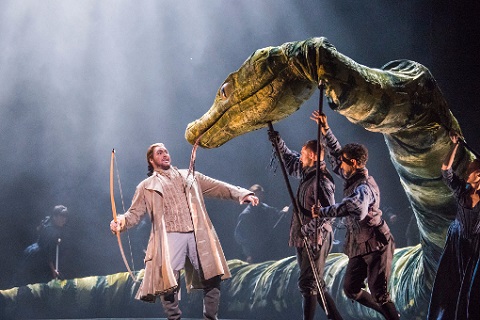 Mauro Peter (Tamino). Photo credit: ROH/Tristram Kenton.
Mauro Peter (Tamino). Photo credit: ROH/Tristram Kenton.
During this performance, however, as the giant segments of the serpent wiggled and waggled, expertly manipulated by the puppeteers, and the marble columns of hallowed halls slid imperiously into dignified place as the orrery spun in heliocentric harmony, it was the opera’s human concerns that seemed more compelling than any abstruse philosophising.
And, for this more harmonious union of folky comedy and high seriousness, we have Roderick Williams’ effortlessly warm-voiced Papageno to thank. Williams is a seasoned bird-catcher having taken the role in several productions, including Nicholas Hytner’s ENO long-lived production and Tim Supple’s ‘grungy’ Flute at Opera North. But, even so, this Papageno has some way to go before his earns his stripes as master of the aviary. Outwitted by a puppet goose - I remember, too, an ‘incident’ with some recalcitrant real-life doves at ENO! - he eventually learns his own tricks, making the Priest’s feet (Harry Nicolls) dance to Papageno’s tune in ‘Ein Mädchen oder Weibchen’. Williams evinces an easy physicality which never drifts into farce and heaps of appealing guilelessness: who would not be touched by fellow-feeling when this Papageno humbly voices his simple desire for love and happiness? His cheek and charm certainly earn the bird-catcher his perky Papagena-in-pink, though one suspects that he will have trouble preventing Christina Gansch’s sassy slapper from fluttering her feathers from time to time.
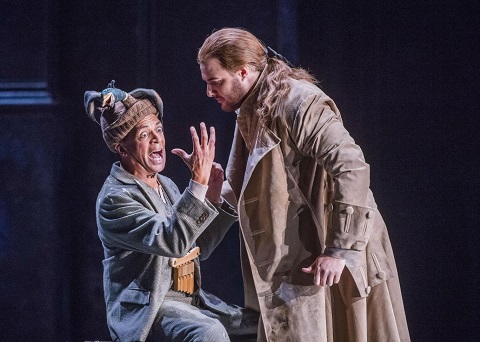 Roderick Williams (Papageno) and Mauro Peter (Tamino). Photo credit: ROH/Tristram Kenton.
Roderick Williams (Papageno) and Mauro Peter (Tamino). Photo credit: ROH/Tristram Kenton.
Williams’ expert comic timing was matched by that of Peter Bronder’s Monostatos. There was a ‘nasty’ edgy to this villain’s lasciviousness which, together with the masked beasts and vultures, suggested a darker vein in the pantomime.
Several of the cast are making their Covent Garden debuts and this was a significant incentive to see this revival. In particular, I was very keen to hear French soprano Sabine Devieilhe scale the Queen of the Night’s stratospheric peaks, having greatly admired her performance as Bellezza in Handel’s Il trionfo del Tempo e del Disinganno at Aix-en-Provence in 2016. And, she didn’t disappoint: ‘O zittre nicht, mein lieber Sohn’ was absolutely secure and clean-toned, but ‘Der Hölle Rache kocht in meinem Herzen’ simply took my breath away. I’m not sure how such a glacial tone can intimate ‘warmth’ or fullness, but somehow Devieilhe managed not just to hit the top Fs but to shape and soften them.
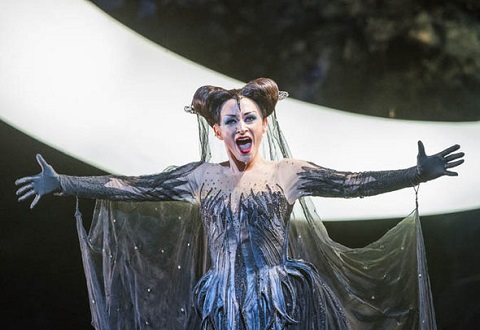 Sabine Devieilhe (Queen of the Night). Photo credit: ROH/Tristram Kenton.
Sabine Devieilhe (Queen of the Night). Photo credit: ROH/Tristram Kenton.
I’d previously been impressed too when I heard Australian soprano Siobhan Stagg sing in Keith Warner’s ROH production of Luigi Rossi's Orpheus at the Sam Wanamaker Theatre at Shakespeare’s Globe in 2015, noting that she combined ‘a ravishing tone with pinpoint accuracy.’ The purity and richness of Stagg’s tone were put to good effect in her interpretation of Pamina’s gentle innocence, for she infused the lovely sound with a firm glint which suggested that beneath Pamina’s naivety lie integrity and resilience. ‘Ach, ich fühl’s’ was unsentimental but deeply communicative, though I wondered whether Stagg would have liked conductor Julia Jones to have taken her foot of the pedal slightly - the aria followed rather precipitously from the preceding aria although Stagg’s poise steadied the ship.
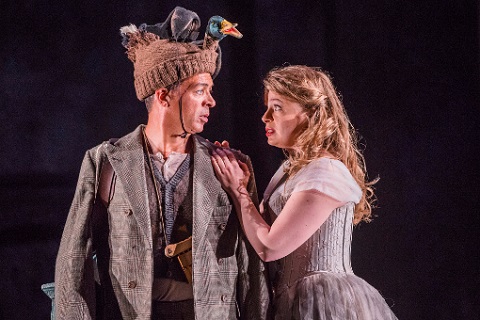 Roderick Williams (Papageno) with Siobhan Stagg (Pamina). Photo credit: ROH/Tristram Kenton.
Roderick Williams (Papageno) with Siobhan Stagg (Pamina). Photo credit: ROH/Tristram Kenton.
Mauro Peter’s Tamino might have had a little more ruggedness, but the Swiss singer has a lyric tenor of great beauty and the polished artistry of his phrasing and his careful diction certainly made his ‘princely’ mien convincing: ‘Dies Bildnis ist bezaubernd schön’ was tenderly love-struck. I found that Finnish bass Mika Kares lacked the sonorous weight needed to convey Sarastro’s authoritative sobriety - though I note that those who saw earlier performances in the run disagreed.
The three boys - James Fernandes, Oliver Simpson and Jayden Tejuoso - struck just the right balance between real boyish charm and pure otherworldliness. Their three voices blended beautifully to form a single gleaming thread of innocence and light; if one shut one’s eyes, one really could believe that they had descended from celestial realms. But, their interventions, preventing tragedy, were genuinely human. The three Ladies were less consistent, Rebecca Evans, Angela Simkin (a Jette Parker Young Artist) and Susan Platts coming adrift at times in terms of timbre and temperament, and, occasionally, tuning.
Jones’ tempos were swift. As in 2013, I wished for a more spacious composure at times for the opera presents both fury and sobriety, but I enjoyed the ROH Orchestra’s sure sense of period style.
Revival directors Thomas Guthrie and Angelo Smimmo (movement) have made a good job of polishing the ROH’s silverware and McVicar’s production continues to shine. At the closing curtain, Macpherson’s sun-disc seemed a perfect metaphor for Mozart’s opera: radiant and eternal.
The Magic Flute runs in repertory at the Royal Opera House until 14 October.
Claire Seymour
Mozart: Die Zauberflöte
Tamino - Mauro Peter; First Lady - Rebecca Evans; Second Lady - Angela Simkin; Third Lady - Susan Platts; Papageno - Roderick Williams; Queen of the Night - Sabine Devieilhe; Pamina - Siobhan Stagg; Monostatos - Peter Bronder; First Boy - James Fernandes; Second Boy - Oliver Simpson; Third Boy - Jayden Tejuoso; Speaker of the Temple - Darren Jeffery; Sarastro - Mika Kares; First Priest - Harry Nicoll; Second Priest - Donald Maxwell; Pagagena - Christina Gansch; First Man in Armour - Thomas Atkins; Second Man in Armour - Sion Shibambu; Director - David McVicar, Conductor - Julia Jones; Revival Director - Thomas Guthrie, Designer - John Macfarlane; Lighting Designer - Paule Constable, Movement Director - Leah Hausman, Revival Movement Director - Angelo Smimmo, Royal Opera Chorus (Chorus Director, William Spaulding), Orchestra of the Royal Opera House.
Royal Opera House, Covent Garden, London; Wednesday 20th September 2017.
image= http://www.operatoday.com/Flute%20production%20image.jpg image_description=Die Zauberflöte at the Royal Opera House, Covent Garden product=yes product_title=Die Zauberflöte at the Royal Opera House, Covent Garden product_by=A review by Claire Seymour product_id=Above: The closing scene.Photo credit: ROH/Tristram Kenton
September 23, 2017
Fantasy in Philadelphia: The Wake World
This world premiere of a spellbinding new one-act opera was inspired by Aleister Crowley's fairy tale of the same name. Crowley was a larger-than-life British persona, a prolific poet, recreational drug user, magician, bisexual, and founder of his own cultist religion. The company chose to present the work in the long Annenberg Hall of the Barnes Foundation, a massively important collection of Impressionist, Post-Impressionist, and early Modern masterpieces.
Dr. Albert C. Barnes was an American chemist, art collector, educator, and writer.
After growing up in a rough and tumble Philly neighborhood, Barnes earned a medical degree from the University of Pennsylvania, amassing his fortune by co-developing Argyrol, a silver nitrate antiseptic. Along the way, he managed to procure one of the world's finest collections of late 19th- and early 20th-century art and create the Barnes Foundation, an educational institution dedicated to promoting the appreciation of fine art and horticulture.
While a student at Curtis, composerHertzberg spent a good deal of time at the Institute, and sensed a link between Barnes’ logic of eccentric groupings and mystical symbols on display in his “palace of art,” and Crowley’s elusive visionary tale of Lola and her chaotic, surreal quest to meet and wed her Fairy Prince on the way to a transcendent awakening.
The audience was allowed ample time before the show to experience the stunning collection and begin to absorb a mystique that characterizes the puzzling arrangement of the sequence of images. About 30 minutes prior to the performance, your peripheral vision catches a creature passing through the gallery. Then another. Some are in colorful unitards with skullcaps and faces painted to match. Others might be a fairy princess, a prince, two cranky old clowns. All of them float silently among us, gazing at and being inspired by the art. They become part of the exhibition itself and equally worthy of scrutiny and admiration, thanks to the fanciful costumes designed by the Terese Wadden.
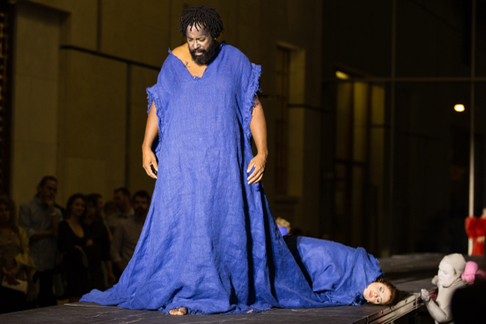 Man of the Blue House (bass-baritone James Osby Gwathney, Jr.)
Man of the Blue House (bass-baritone James Osby Gwathney, Jr.)
Eventually the creatures lead us to the great room where we assemble, mostly standing all around a very long runway of elevated platforms. This is the stage proper but much more is in store. The creatures are silently walking, no, gliding among us. And then. . .WHAM! A crashing whack of the bass drum ricochets through the room like a gunshot. And if that didn’t make us perk up. . .WHAM! Another. And another. And then with a wordless layering of vocal sounds, chants, organ like intonements, the cast among us began a musical journey that was an unparalleled delight.
Director R.B. Schlather has realized this otherworldly rite of passage as miraculously executed immersive theatre. In the ritual opening as the voices threaten to reach Nirvana, we “get” that we are encouraged to move around the room as the opera unfolds and a parade begins around the runway like pilgrims at Mecca. When the action begins at one end of the platform and surges to the center, viewers surge with it, not only changing the dynamic of the relationship between “audience” and “actor,” but also the spatial relationship of the audience itself.
I have never seen this sort of interplay work so well, engaging without being demanding, spontaneous yet rehearsed within an inch of its life. Since there is no scenery other than the assembled cast and audience, Jax Messenger’s minimal lighting design contributed some beautiful effects, not least of which was the surprising, almost blinding back light effect that comes from an unexpected place at a crucial dramatic moment. David Zimmerman’s spot on make-up and wig design beautifully complemented Ms. Wadden’s costumes.
The central role of Lola is a big, complicated sing and soprano Maeve Höglund was triumphant. Ms. Höglund has a solid technique wedded to a rich, alluring soprano that can climb the heights with an easy sheen. She is called upon to execute extreme emotional states, and whether hurling out angular accusations, or musing introspectively, her responsive instrument was a joy to hear. It does not hurt that she is also pretty as a princess and utterly at ease in her stage demeanor.
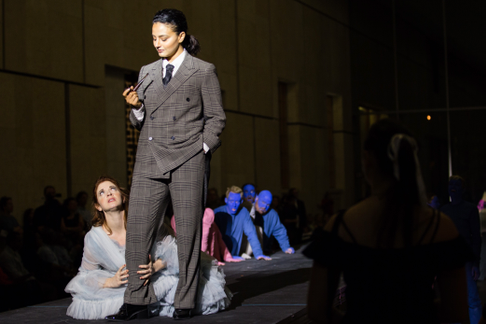 The Fairy Prince (mezzo-soprano Rihab Chaieb), Lola (soprano Maeve Höglund)
The Fairy Prince (mezzo-soprano Rihab Chaieb), Lola (soprano Maeve Höglund)
In the trouser role of the Fairy Prince, Rihab Chaieb matched her co-star strength for strength. Her smoky, beguiling mezzo was poised and pliant, and she cut an exotic, authoritative figure as the swaggering royal. Ms. Chaieb is a first rate musician who ably met the considerable musical demands set out for her, including an easy sensuality in her caressing manner with any number of loving, arched phrases.
Soprano Jessica Beebe made the most of her solo time as Luna/Hecate, regaling us with ample tonal beauty and shimmering delivery. George Rose Somerville was totally invested into his garrulous portrayal of Morbus, and John David Miles hectored with conviction as Pestilitas. The sirens Parthenope (soprano Rebecca Myers), Ligeia (soprano Veronica Chapman-Smith), and Leucosia (mezzo-soprano Joanna Gates) intertwined their polished voices with radiant beauty. James Osby Gwathney, Jr.’s well-modulated bass-baritone made a substantial impression as Man of the Blue House. As the collective ensemble, Palace of Names, the Opera Philadelphia Chorus was superb, offering dramatic commitment as well as ravishing vocalizing.
Holding all of this together was the masterful conductor Elizabeth Braden. The musical execution was faultless, no mean feat with her forces spread across a sixty foot runway and throughout the audience. Maestra Braden found just the right balance between her exceptional instrumentalists and the vocal forces, and made a compelling case for Mr. Hertzberg’s evocative score. There are hints of Debussy, echoes of Strauss, reminiscences of Penderecki, but at the end of the day his is a unique style, and he writes gratefully and inventively for the voice.
But The Wake World not only sings, it soars. Mysterious. Challenging. Moody. Risky. Enriching. What an inspiring night in the theatre.
James Sohre
Cast and production information:
The Wake World
Music and Libretto by David Hertzberg
Lola: Maeve Höglund; Fairy Prince: Rihab Chaieb; Parthenope: Rebecca Myers; Ligeia: Veronica Chapman-Smith; Leucosia: Joanna Gates; Luna/Hecate: Jessica Beebe; Morbus: George Rose Somerville; Pestilitas: John David Miles; Giant/BoneMan/Man in the Azure Coat/Man of the Blue House: James Osby Gwathney, Jr.; Palace of Names: Opera Philadeplhia Chorus; Conductor: Elizabeth Braden; Director: R.B. Schlather; Costume Design: Terese Wadden; Lighting Design: Jax Messenger; Wig and Make-up Design: David Zimmerman
image=http://www.operatoday.com/WakeWorld_OT1.png
product=yes
product_title=The Wake World at Opera Philadelphia
product_by=A review by James Sohre
product_id=Above: Maeve Höglund as Lola [All photos copyright Dominic M. Mercier, courtesy of Opera Philadelphia]
September 22, 2017
A Mysterious Lucia at Forest Lawn
Conductor Isaac Selya and his orchestra of twenty-seven played the overture with its emotion-inducing harp music as the red sun slipped behind the mountains, leaving orange clouds and purple shadows to introduce the mysteries of night. Director and Designer Josh Shaw used three levels backed by rough walls that resembled ancient ruins as the basis for each scene. Maggie Green’s costumes involved a variety of tartans that evoked the mystique of historical Scotland.
The opera opened with a fight between Lucia Ashton’s relatives and their Ravenswood opponents. Enrico Ashton, Lucia’s brother, sung by Daniel Scofield, won this skirmish, but the war was nowhere near over. Enrico vented his fury in magnificent song at the idea of his sister falling in love with the family’s sworn enemy, Edgardo of Ravenswood. Scofield was only one of the stars of this show who had large, resonant Italianate voices. Tenor Nathan Granner as Edgardo matched him note for note.
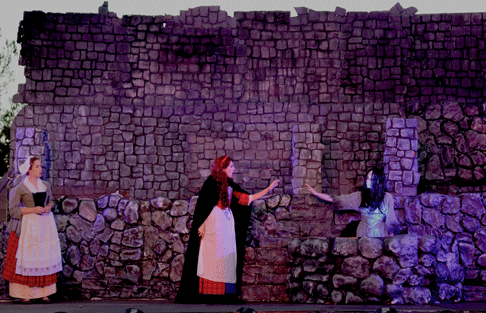
Jacqueline Marshall’s beautiful harp music announced Lucia’s arrival at the fountain where she waited for Edgardo. Bevin Hill was a full service Lucia who hit all the notes at the right times and was able to deal with all the technical aspects of the role. Not every tone was beautiful, however. Following Lucia’s description of the spectre in the fountain, it emerged in the form of a wraith-like dancer who followed the soprano throughout the opera as a prime indicator of her mental state.
When Edgardo, who does not know that his messages to Lucia have been intercepted or that she has been told he loves another, arrived and found her marrying Arturo, he and the guests sang a magnificent sextet. Enrico and Edgardo sang of their fears for Lucia, and she took over the melody. Lyric bass-baritone Nicholas Boragno as Raimondo, the man of God, wondered about an evil end to the situation. Bridegroom Arturo, sung by lyric tenor William Grundler, and Lucia’s companion, Alisa, sung by mezzo-soprano Danielle Bond, sang of their fear for the future. Each character sang about this fatal day in the exquisitely blended sonorities that form the opera’s dramatic lynchpin.
Because Forest Lawn closes its gates on both spectres and living beings alike at ten o’clock, this performance had to skip the Wolf’s Crag Scene in which Enrico challenges Edgardo to a duel. Act III opened on Lammermoor Castle with the guests enjoying copious food and drink. All are shocked when Raimondo tells them that Lucia has murdered Arturo.
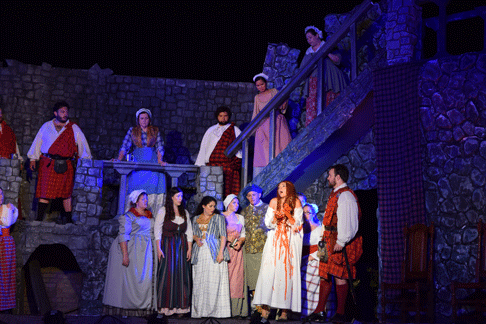
Appearing dazed, Lucia wore a blood-stained gown and held a dagger in one hand as she sang her Mad Scene accompanied by the flutes of Eve Bañuelos and Michelle Huang. Hill sang with great control but her character was mentally in another world. At the end of this pièce de resistance Lucia fell to the floor, lifeless. Later, in the Ravenswood graveyard, Edgardo hears the bell tolling her death. Stabbed through the heart, he leaves this unhappy world singing of the future he and Lucia will have together in Heaven. Although the story was sad, the performance was enthralling with audience members humming Donizetti’s tunes as they wound their way down the mountain that is Forest Lawn.
Maria Nockin
Cast and production information:
Director and Designer, Josh Shaw; Conductor, Isaac Selya; Company Manager, Mari Sullivan; Stage Manager, Carson Gilmore; Costumes, Maggie Green; Fight Director and Choreographer, Aubrey Trujillo-Scarr; Fight Captain and Choreographer, Elias Scarr; Lucia, Bevin Hill; Edgardo, Nathan Granner; Enrico, Daniel Scofield; Raymond, Nicholas Boragno; Arturo, William Grundler; Alisa, Danielle Bond; Norman, Robert Norman.
image=http://www.operatoday.com/Lucia-Press-4.png
image_description=Bevin Hill as Lucia and Nathan Granner as Edgardo [Photo by Martha Benedict]
product=yes
product_title=A Mysterious Lucia at Forest Lawn
product_by=A review by Maria Nockin
product_id=Above: Bevin Hill as Lucia and Nathan Granner as Edgardo
Photos by Martha Benedict
This is Rattle: Blazing Berlioz at the Barbican Hall
If Simon Rattle can achieve such excellence in the cramped confines of the Barbican Hall, imagine how Britain's cultural life would be transformed if a world class concert hall with state of the art facilities were built. The arts are central to the nation's economy and prestige. Britain cannot afford to slip.
As Rattle has said, the London Symphony Orchestra have the potential to do a lot more repertoire, given the chance. Berlioz The Damnation of Faust is an extravagant work. The stage was crowded with performers, and the volume projected into the shoebox that is the Barbican Hall threatened at times to overwhelm. On the BBC Radio 3 re broadcast and on medici.tv the sound balance might be better, but the live experience was intoxicating, despite the acoustic. Wisely, Rattle held his forces back, emphasizing instead the intricate orchestration and textures that make this piece so exciting. It is a sprawling drama, whose theatrical effects are embedded in the music. In Berlioz's time audiences didn't need literal realism. They paid attention to the music. This performance was so vivid that the Barbican Hall seemed transformed as if by magic, as Berlioz's music came alive.
Faust, the old scholar, watches peasants dancing in the countryside. "Tra la la , Haha ha!" sing the chorus. It is Easter. Spring has come. Nature blossoms. Christ has risen. Dare Faust dream of rejuvenation? Bryan Hymel sang Faust, the rich, ringing warmth in his voice bringing colour to the role. Hymel then injected chill fear. "Hélas! doux chants du ciel, pourquoi dans sa poussière Réveiller le maudit? ". Faust is no fool: he already senses the immensity of what is to come.
A Faust as strong as Hymel needs an equally singular Méphistophélès. Christopher Purves provided an authoritative counterbalance. The expressiveness in Hymel's voice contrasted with the authority in Purves's voice and his purposeful enunciation. The way Purves sang "Ô pure émotion!" showed how Méphistophélès had sized Faust up. A strong Brander, too, in Gabor Bretz. Though the part isn't big, it's important, for Brander is to the students what Méphistophélès is to Faust. The chorus sang lines that swayed from side to side, as drinkers do. But an undercurrent of violence runs through the merriment. Purves sings the Song of the Flea but the drunks think it's funny. In the Voici des roses, Purves suggested the thoughtful side of Méphistophélès.'s character: low winds and strings evoking melancholy. The devil is dangerous because he understands human sensitivity, and uses that to manipulate. Perhaps Méphistophélès is a kind of Oberon, for Faust is lulled into a dream by a magical flute melody, later taken up by the strings, and the songs of gnomes and sylphs. A magical scene which owes much to Mendelssohn.
For Faust, a reverie of love. For the students, mindless delusion as they march off to war. Hymel's aria "Merci, doux crépuscule! " was a star turn, beautifully articulated, glowing with feeling. The phrase "Que j’aime ce silence," glowed beautifully, followed by a deeply felt "et comme je respire Un air pur!" The orchestra responded in kind, with transparently delicate textures. When Méphistophélès. butts in, a violin plucks a banal ditty, like a student with a lute. But Faust is made of far finer stff, as is Marguerite. Karen Cargill sang the Song of the King of Thule with sincerity. The song is a paean to fidelity, loyalty so strong it defies death. Garlanded by viola and cellos, it's anothe moment of "silence" where Méphistophélès and the world cannot reach.
Berlioz's The Damnation of Faust owes as much to Shakespeatre as to Goethe. In the magical Evocation, fireflies dance, piccolos playing bright figures augmented by darker hued winds and strings. Textures as transparent as these need this kind of definition There was humour, too, in the trombones and tuba, which not every orchestra can carry off as well as the LSO. Purves curled his tongue around the final words, with the menace of a snake, for now Faust and Marguerite have their encounter. Hymel's " Ange adoré" glowed resplendently, and his cry "Marguerite est à moi!" scaled the heights. But the world intrudes. After fast paced exchanges, the lovers are torn apart. The cross currents between soloists, choirs and orchestra were very well defined.
Then, back to solitude. Cargill's Romance showed her at her finest. matched by evocative oboe accompaniment. Although some incarnations of Faust emphasize the God/Devil angles in the legend, Berlioz was very much a Romantic, for whom Nature was an alternative diety. Thus, the importance of the Invocation. Hymel sang the aria Nature immense, impénétrable et fière, with such fervour it seemed an act of faith. But Fast is doomed. Méphistophélès and Faust set off on horses that fly through the sky, defying the laws of Nature. Wailing woodwinds, and a frenzied pace in the orchestra, tensely plucked pizzicato. The children's voices screamed "Ah!" and the tubas wailed pounding staccato, Now, Méphistophélès has little need for formal language. "Hop! Hop!" screamed Purves. My flesh creeped, thinking of the "Hop Hop" at the end of Wozzeck. The men's chorus walked on stage, among the orchestra, singing their demonic chorus: skat lyrics before the term was invented, interspersed with machine-gun staccato. Are the demons the students and soldiers?
"Hosana!" sang the choirs at the back of the stage. Harps sggested angels, and the palpitating, ascending rhythms, the flapping of wings, or the image of water (as opposed to the fires of hell). And then the children's choirs filed into the auditorium, illuminating the darkness with their high, pure voices. Like a miracle!
Anne Ozorio
Hector Berlioz: The Damnation of Faust
Sir Simon Rattle, London Symphony Orchestra, Bruyan Hymel, Christopher Purves, Karen Cargill, Gabor Bretz, London Symphony Chorus (concertmaster Simon Halsey) Tiffin School Choirs (concert master James Day).
Barbican Hall, London. Sunday 17th September 2017
image=http://www.operatoday.com/Rattle%20photo.jpg image_description=This is Rattle: Sir Simon Rattle and the London Symphony Orchestra perform Hector Berlioz’s The Damnation of Faust at the Barbican Hall product=yes product_title=This is Rattle: Sir Simon Rattle and the London Symphony Orchestra perform Hector Berlioz’s The Damnation of Faust at the Barbican Hall product_by=A review by Anne Ozorio product_id=Above: Sir Simon RattleSeptember 20, 2017
Moved Takes on Philadelphia Headlines
That is marketing shorthand for Philadelphia Opera Festival 2017, and in longhand, this is a nonpareil, landmark event.
Never was this more evident than at the world premiere of We Shall Not Be Moved, a musically compelling and deeply moving new piece of lyric theatre by composer Daniel Bernard Roumain and librettist Marc Bamuthi Joseph.
Five North Philly teens are on the run to avoid arrest after unintended involvement in several tragic incidents. They seek refuge in the abandoned house that served as the headquarters for the MOVE organization, where a 1985 standoff with police infamously ended with citizens dead and a neighborhood destroyed. As this disparate, self-defined family takes refuge, they unexpectedly find inspiration in the ghosts who linger in the historic residence. Their initial fear transforms first into resistance, then destiny.
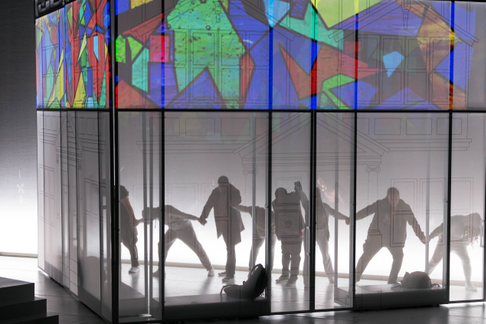 Family Stand and the OGs come to live in an abandoned home on Osage Avenue. Photo by Dominic M. Mercier
Family Stand and the OGs come to live in an abandoned home on Osage Avenue. Photo by Dominic M. Mercier
Mr. Roumain’s genre-defying score is not only often earthy but also just as frequently ethereal, and seems poised to freely move between the two extremes. He is equally at home writing in classical style, injecting jazz riffs, or hunkering down into pulsing R&B, but this score is filtered through a unique lens of self-invention. Mr. Joseph’s edgy libretto blends poetry, prosedy, spoken word, street slang, and rap into a masterful expressive vocabulary that often seems a laser-focused response to current race relation headlines.
A third collaborator is the renowned director, choreographer, dramaturge and dancer Bill T. Jones who completes the triumvirate responsible for this piece he calls “ambitiously interdisciplinary.” Mr. Jones brings together contemporary movement, video projection, staggeringly powerful stage pictures and deeply explored characterization to unite his abundantly talented cast, crew and creative team.
Lauren Whitehead, a noted spoken word performer and writer brings her substantial gifts to the role of Un/Sung, the central teenage figure, narrator, and surrogate mother whose determined journey binds the other family to her. Lauren holds her own with her operatically trained colleagues, singing with secure sincerity. As her counterpart, the policewoman Glenda, luminous mezzo Kirstin Chavez turns in a galvanizing performance. As her assured, tough love authority is reduced to a legal predicament not of her making, Ms. Chavez invests her character with intense, conflicted duality. And, Lisa is possessed of a particularly attractive mezzo, for which the composer provided some of his most urgent and limpid phrases. Hers was a touching and beautifully crafted portrayal.
The gifted counter-tenor John Holiday threatens to walk away with any show he is in. On this occasion, Mr. Holiday deploys his distinctively pointed, high-flying instrument to not only cry out some R&B licks that challenge Mariah Carey, but he also reined in his sassy delivery to create a heartbreaking, internalized impersonation as a bullied trans man. I will not soon forget the tears that fell in the audience as John sang pitiably about his binding himself at peril of bullying to become who is, and not the gender he was born to.
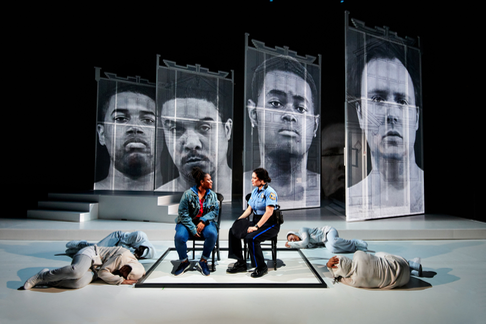
West Philly cop Glenda (mezzo-soprano Kirstin Chávez) asks Un/Sung (spoken word artist Lauren Whitehead) why her and her brothers are not in school. Photo by Dave DiRentis
Powerhouse bass-baritone Aubrey Allicock commanded the stage as John Henry, prowling the perimeter with restless purpose and howling out jazz licks with obvious delight. His middle and upper range have acquired an admirably burnished sheen over time, and his legit operatic phrases were fulsome and fearsome. John Mack was played by Adam Richardson, handsome and sympathetic of presence, who sang with a characterful, grainy, immensely appealing lyric baritone. Daniel Shirley rounded out the family as John Little, able to color his smooth lyric tenor to suggest real danger and aggression.
As soloists, these fine artists were commendable. As an ensemble, they were perfection. Thanks to Mr. Jones, this group of accomplished pros sang together, loved together, danced together and suffered together, forming the beating heart that was key to this production’s total success. They were ably abetted in their excellence by four tireless, omnipresent dancers as the OG’s (ghosts) who inhabit the historic sacrificial grounds. These lithe, expressive, generous artists provided a writhing, body slamming, break dancing commentary on every nuance of the unfolding drama and they are: Michael Bishop, Duane Lee Holland, Jr., Tendayi Kuumba and Caci Cole Pritchett.
Their choreographed contribution to the evening’s triumph included moving around Matt Saunders’ modular set pieces. Mr. Saunders has provided four flexible mobile wall units and a couple of simple stair and platform pieces that are chameleon-like and able to transform into any number of configurations and locales. Since they are white, they are amazingly receptive to Mr. Cousineau’s inspired projection design, which occasionally found dancers behind scrim panels being mirrored by dancer images on the screens in front of them. The sacrificial immolation effect was mesmerizing and shattering in its intensity.
Liz Prince’s costume design kept things simple but her attire really helped define the characters, and her white hoody riff for the ghosts was urban inspired. Robert Wierzel’s lighting successfully complemented the projections, always enhancing the look, never interfering. David Zimmerman’s tasteful sound design was effective without calling attention to itself.
While this was a monumental collaboration of many individual efforts, at the end of the day, Bill T. Jones was probably the overriding component in its success. I believe his assured melding of all the elements in this challenging new piece, and his artistic vision propelled We Shall Not Be Moved from the merely excellent to the profound. We “were” moved. Future audiences “will” be moved. How could anyone “not” be moved by Opera Philadelphia’s towering, musically engaging, emotionally wrenching achievement?
James Sohre
Cast and production information:
We Shall Not Be Moved
Music by Daniel Bernard Roumain
Libretto by Marc Bamuthi Joseph
Un/Sung: Lauren Whitehead; Glenda: Kirstin Chavez; John Blue: John Holiday; John Little: Daniel Shirley; John Mack: Adam Richardson; John Henry: Aubrey Allicock; OG: Michael Bishop; OG: Duane Lee Holland, Jr.; OG: Tendayi Kuumba; OG: Caci Cole Pritchett; Voice of the Reporter: Pat Ciarocchi; Caller: Mike J. Dees; Conductor: Viswa Subbaraman; Director/Choreographer/Dramaturge: Bill T. Jones; Set Design: Matt Saunders; Costume Design: Liz Prince: Lighting Design: Robert Wierzel; Projection Design: Jorge Cousineau; Sound Design: David Zimmerman
image=http://www.operatoday.com/Moved_OT1.png
product=yes
product_title=We Shall Not Be Moved at Opera Philadelphia
product_by=A review by James Sohre
product_id=Above: Countertenor John Holiday as John Blue [Photo by Dominic M. Mercier, courtesy of Opera Philadelphia]
Philly Flute’s Fast and Furious Frills
The O17 festival has appropriated Barry Koskie’s acclaimed eye-popping production and cast it from strength with some of the finest young singers to be found on today’s opera stages. Mr. Koskie has co-directed with Suzanne Andrade and the pair has collaborated closely with the prodigiously gifted animator Paul Barritt to create a non-stop display of morphing projections that are both the production’s unique achievement and ultimately, its weakness.
Ben Bliss was a sweet-voiced Tamino, his pliant lyric tenor a perfect match for the Prince’s vocal demands. Mr. Bliss soared above the staff with an ingratiating ease of expression. Rachel Sterrenberg had a slower start as Pamina, her substantial soprano feeling its way through Bei Männern. As the show went on, Ms. Sterrenberg warmed to her task and settled in to provide a limpid, affecting Ach, ich fühl’s. In the final quartet Ben and Rachel’s intertwined lofty phrases fell quite wondrously on the ear.
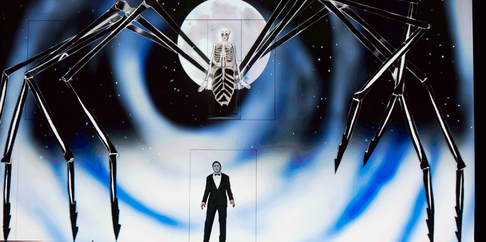 Queen of the Night and Tamino
Queen of the Night and Tamino
Jarrett Ott had all the wit and presence one could want in a Papageno, and you won’t often hear the role this well sung. Mr. Ott’s shining baritone has real star power and beauty. Olga Pudova was an audience favorite as a highly musical and secure Queen of the Night. Her pleasing tone and technical accomplishment made for two memorably accurate arias. Bass Peixin Chen did double duty as the Speaker (sung offstage) and Sarastro (sung mostly onstage). His weighty, orotund bass was darkly imposing, although it had a tendency to lumber a bit from note to note. Brenton Ryan’s well-projected, sizable tenor served Monostatos well, and his insinuating coloration of key phrases made for some inspired villainy.
The Three Ladies were a pleasantly compatible trio, with soprano Ashley Milanese a sprightly First Lady, mezzo Siena Miller holding her own in a solid turn as Second Lady, and mezzo Anastasiia Sidorova grounding the group with a firmly intoned Third Lady. The Three Spirits were a delight in their every appearance: AJ Owens, Damian Ferraro, and Patrick Corcoran were well schooled, pure-toned and cherubic. Ashley Robillard was such an appealingly pert soprano that she managed to score big as Papagena even though her role in this cutting was nearly non-existent.
The Armored Men are often cast with more mature singers so it was a pleasure to hear two fresh young vocalists bring brightness and poise to their ‘choral prelude’ and, especially, the quartet. Roy Hage (First Armored Man) sports an engaging, ringing tenor, and Marcus Deloach (Second Armored Man), serves up a vibrant baritone. Elizabeth Braden’s chorus was stirring in their brief, but important appearances.
In the pit, conductor David Charles Abell led an assured overture, in what would be the only visually unanimated music of the performance. Once the “fun” began, Maestro Abell did his considerable best to keep reminding us that the opera is really about sublime music and immortal characters, not just shock and awe video effects. He was sometimes stymied by the distraction. Perhaps owing to placement of singers, the ensembles (only) occasionally got ahead of the beat, with the Three Ladies being the most challenged in their tricky banter.
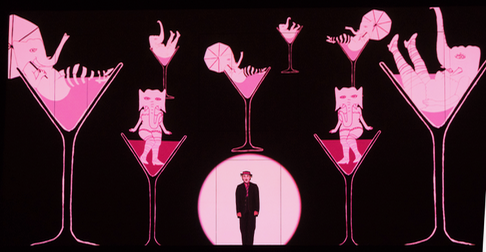 Jarrett Ott as Papageno
Jarrett Ott as Papageno
This animated, manic concept seems to have given a good deal of pleasure to the vast number of audience members. It is certainly unlike any other. There is no doubt that the non-stop coordination of effects was a challenge, one that was always meticulously achieved. Papageno must siphon a pink lady out of a cocktail glass by “sucking on a straw” as it empties. Pamina must act threatened by a pack of snarling dogs that Monostatos has tethered, straining on a leash. Tamino must “pop” heart balloons floating above his head with his pointed index finger just at the right time. All tricky stuff, admirable to behold. But here’s the thing:
The characters were never allowed to interact with each other or, more critically, with the audience. They were mostly required to stand stock still in a prescribed spot, and everything happened to them or around them, but not with them. Do we really want the Queen of the Night vocalist to be reduced to a disembodied head while the animation attached to that head bombards us with an overused image of an attacking spider? There was so much cute commotion of appearing children during Papageno and Papagena’s duet that Mr. Ott and Ms. Robillard could have had a sparkler in their teeth and we would have been hard pressed to notice them.
Consequently, these appealing characters were never allowed to bond with each other or the audience. This was not like the integrated animation of say, Mary Poppins, where the imagery was a clever party trick that enhanced the live characters. In this Flute (which, by the way had no flute at all!), I had the feeling the whole shebang could have been animated with these wonderful singers in the pit without much change in the experience. For the record, Esther Bialas’ stage and costume design were manic and colorful; Christopher J. Hetherington’s lighting design complemented (read: stayed out of the way of) the projections; and David Zimmerman’s wig and make-up design provided fanciful whimsy.
With the dialogue completely eliminated and the plot advanced by projected blunt silent movie exclamations, the humanity of Mozart’s masterpiece seemed limited to the level of a complicated video game, albeit with superlative background music. Remember the music? Remember when The Magic Flute had, well, a magic flute? Me, too. . .
James Sohre
Cast and production information:
The Magic Flute
Music by Wolfgang Amadeus Mozart
Libretto by Emanuel Shikaneder
Tamino: Ben Bliss; Pamina: Rachel Sterrenberg; Queen of the Night: Olga Pudova; Sarastro/Speaker: Peixin Chen; Papageno: Jarrett Ott; Papagena: Ashley Robillard; Monostatos: Brenton Ryan; First Lady: Ashley Milanese; Second Lady: Siena Miller; Third Lady: Anastasiia Sidorova; First Armored Man: Roy Hage; Second Armored Man: Marcus Deloach; First Spirit: AJ Owens; Second Spirit: Damian Ferraro; Third Spirit: Patrick Corcoran; Conductor: David Charles Abell; Co-Directors: Suzanne Andrade and Barrie Kosky; Production: Suzanne Andrade and Barry Kosky; Animation: Paul Barritt; Stage and Costume Design: Esther Bialas; Lighting Design: Christopher J. Hetherington; Wig and Make-up Design: David Zimmerman; Stage Director: Tobias Ribitzki
image=http://www.operatoday.com/Flute_OT1.png
product=yes
product_title=The Magic Flute at Opera Philadelphia
product_by=A review by James Sohre
product_id=Above: Jarrett Ott as Papageno [All photos courtesy of Opera Philadelphia]
September 19, 2017
At War With Philadelphia
At the renowned Philadelphia Museum of Art they presented War Stories, a double bill of Monteverdi’s brief madrigal Il combattimento di Tancredi e Clorinda paired with the contemporary I Have No Stories To Tell You by composer Lembit Beecher and librettist Hannah Moscovitch.
Through no fault of the musical or production quality, which was unfailingly high, it was somewhat dispiriting to observe a pairing about the devastating consequences of war written in the 17th century with one written in the 21st century, realizing they bookend four centuries of nearly constant war in between.
The Monteverdi is staged arena style in the cloisters exhibit, the audience seated around the perimeter of the columned edifice with the fountain in the middle of the playing space. En route to the show, we passed through hallways dotted with mid-20th century army cots, dressed with props from barracks life: playing cards, magazines, cigarettes, etc.
Owing to the subdued lighting, we don’t much notice at first that there are two cots in the inner cloister, on which people are asleep. They turn out to be Tancredi and Clorinda. Craig Verm has a potent presence as Tancredi, his virile baritone burning up the confines of the small room. Cecelia Hall’s meaty mezzo matches him in fierce intensity as Clorinda, and both of them summon heart-rending color in their phrases of anguish and defeat. The single narrator role is here split between Samuel Levine and Abigail Levis. Both are remarkably fine, Mr. Levine’s pointed tenor often lashing the air excitedly with aggressive pronouncements, and Ms. Levis notably investing her plangent mezzo with considerable emotional subtext.
The compact composition packs a lot of confrontation and reaction into 20 minutes and the vocal effort was heightened and well partnered by a tight ensemble of period instrumentalists under the smooth direction of Gary Thor Wedow. The design elements were limited to some shadowy, threatening lighting effects devised by Mary Ellen Stebbins, including hand held mini-spots ferried around the action by nimble, squatting extras. I didn’t fully understand Kaye Voyce’s futuristic black one piece uniforms, with hoods and veiled mouths, meant to be armor, but they were definitely a “statement,” and the deliberately delayed reveal of the face and heads of the title characters was fulfilling. As Tancredi carried the lifeless body of Clorinda out of the room, the audience seemed not to want to break the silence with applause. Moving.
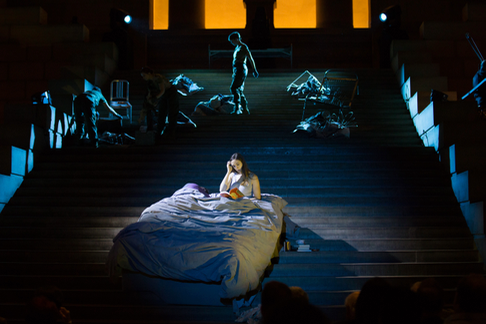
Cecelia Hall as Sorrel
Beecher and Moscovitch’s I Have No Stories To Tell You was staged on the museum’s imposing grand staircase, and proved to be disturbingly contemporary. It continues the theme of a tragic rift between lovers, but here it involves PTSD and its devastating consequences on a young married couple. Just as armor had obscured Tancredi and Clorinda from each other, here the “armor” of painful memories keeps the lovers from knowing each other fully.
As the service member Sorrel, Ms. Hall turned in a searing vocal performance as a broken woman ravaged by her war experience, her portentous mezzo imparting tremulous weariness and dread as she tries to hang onto her sanity with fingertips of steel. Mr. Verm is achingly vulnerable as her loyal husband, the care and anguish and frustration palpable in his honeyed baritone. Samuel Levine weighted his focused and secure tenor to underscore nagging questions surrounding Sorrel’s enigmatic fellow soldier Noah. A mini Greek chorus that is an unwelcome guest in Sorrel’s mind provides atmosphere, musical texture and commentary. The trio is exceedingly well-matched and wonderfully sung by Sarah Tucker (Memory 1), Rachel Calloway (Memory 2), and Abigail Levis (Memory 3).
Director Guarino took advantage of the different levels to suggest who is influencing the most power over Sorrel at any given point. The couple’s marriage bed is furthest down the staircase and closet to the audience. The husband rarely gets above this level, so diminished is he in the equation. The Memories haunt Sorrel by scurrying about, disrupting the peace, scattering household and battlefield detritus over the stairs. The flashback friend (or is he?) Noah moves deliberately, a gnawing presence hovering over the solvency of the marriage, and a key part of the shocking revelation. The director has elicited emotionally fearless performances from her principles. Ms. Voyce’s apt costumes and Ms. Stebbins’ moody lighting both achieved much with economy of means. Daniel Perelstein’s well-considered sound design added restlessness and danger to the mix.
Ms. Moscovitch’s lean, mean script hits all the right points, and composer Beecher has crafted a unique and stirring sound world for this fluid character study that spans time and place. His writing for the vocalists was very grateful, and scoring it for nearly the same Baroque instrumentation as the Monteverdi was inspired. Maestro Wedow once again provided a luminous reading, ripe with heart and hurt. The subtle lengthening of the flashback episodes in turn as they recurred was a masterful idea and the cumulative revelation of back story was rewarding.
The only thing I might urge the producers to do is tighten up the sequence of events. The group had to split in two for the first piece, but 30 minutes was too long to just chill in the armor exhibit, waiting our turn for the cloisters show. Too, the intermission after the first show was far longer then necessary for the actors to do modest costume changes, and valuable momentum was lost.
Musically, this was a first rate event. Dramatically, I felt it ultimately lacked a fulfilling point of view. War is bad. Of course. War spurs personal tragedy and spares few. At the end of the event, a “button” was needed. I “think” the company wanted us to contemplate how - given the violent history of the world - how we might change course and eliminate war. The second piece, written to complement the Monteverdi “might” have had the opportunity to steer that thought, but chose not to do it, remaining rooted in the parallel tragedy.
Alternatively, perhaps a chaired talk back or discussion could have been offered about enabling peace to break out, or inspiring something, anything positive that could be taken home, prompted by what we had collectively experienced. As it was, I left a dramatically disturbing, musically refined event that took a little too long to unfold, musing I had perhaps just been at the “feel bad” event of O17.
James Sohre
Cast and production information:
War Stories:
Il combattimento di Tancredi e Clorinda
Music by Claudio Moneverdi and
I Have No Stories To Tell You
Music by Lembit Beecher
Libretto by Hannah Moscovitch
Clorinda/Sorrel: Cecelia Hall; Tancredi/Daniel: Craig Verm; Testo/Noah: Samuel Levine; Memory 1: Sarah Tucker; Memory 2: Rachel Calloway; Testo/Memory 3: Abigail Levis; Conductor: Gary Thor Wedow; Director: Robin Guarino; Design Consultant: Adromache Chalfant; Costume Design: Kaye Voyce; Lighting Design: Mary Ellen Stebbins; Sound Design: Daniel Perelstein; Wig and Make-up Design: Dasvid Zimmerman
image=http://www.operatoday.com/WarStories_OT4.png
product=yes
product_title=War Stories at Opera Philadelphia
product_by=A review by James Sohre
product_id=Above: Craig Verm as Tancredi and Cecelia Hall as Clorinda in Monteverdi’s Il Combattimento di Tancredi e Clorinda [All photos courtesy of Opera Philadelphia]
The Mozartists at the Wigmore Hall
For their opening concert, at the Wigmore Hall, they were joined by one of Classical Opera’s Associate Artists, soprano Louise Alder. Six months ago, one might have described Alder as a ‘rising star’ but recent accolades - including ‘Young Singer of the Year’ at the 2017 International Opera and the Dame Joan Sutherland Audience Prize at the BBC Cardiff Singer of the World - have seen her ascend securely to the firmament.
I last saw and heard Alder performing the music of Richard Strauss, as Sophie in WNO's Der Rosenkavalier and on her debut recording, Through Life and Love ; here, she tackled two show-case arias: a Gluck rarity and the opening aria from Mozart’s opera seria, Idomeneo. Alder has a lovely stage presence. Relaxed and generous, she seemed delighted to be at the Wigmore Hall, to be sharing music with the instrumentalists of Classical Opera and to be communicating with the eager, sell-out audience.
My pre-concert research threw little light on Gluck’s festal opera Il prologo which was commissioned in 1767 as part of a three-day celebration marking the birth of the first child of Peter Leopold I (younger brother of Emperor Joseph II) and his wife Maria Luisa (daughter of King Charles III of Spain). But, an informative programme note explained that, setting of a dedicatory text by the poet Lorenzo Ottavio del Rosso, Gluck’s work was to be presented in the Teatro di Via della Pergola in Florence as a prologue to the centrepiece of the festivities - Tommaso Traetta’s opera Ifigenia in Tauride. In the event, lack of time to compose and rehearse a new work led Gluck to borrow the overture and opening chorus from his 1756 opera Il re pastore; but when Il prologo was first heard, on 22 February, it did include three accompanied recitatives, a concluding chorus and an extended aria in which Jove hails and blesses the new-born child.
Alder’s relaxed but direct soprano swept cleanly through the recitative, which was punctuated by increasingly extended string gestures building to a galloping imitation of the messenger - a figure of glory, in triumphal robes - who carries the new of the happy birth. Having intensified the tone to match the deepening reverence of the text, Alder softened her soprano to bestow ‘a thousand unaccustomed feelings of joy’ upon the ‘sovereign breasts’, with beautiful, fading tenderness.
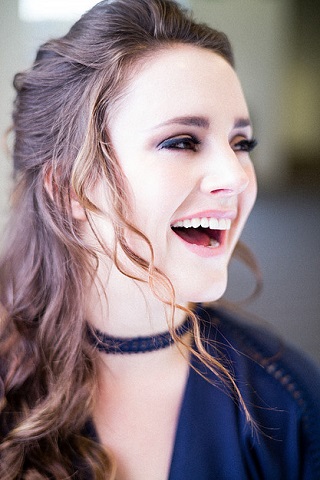 Louise Alder. Photo credit: Gerard Collett.
Louise Alder. Photo credit: Gerard Collett.
The strings pulsed gently at the start of ‘De’ sublimi augusti eroi’ (O sublime, happy event), as Alder traversed the wide range of Jove’s opening phrases with impressive evenness, suggesting the all-encompassing embrace of peaceful contentment which will overflow from the souls of ‘lofty and majestic heroes’. This concertante aria has significant instrumental solos - the accompaniment is almost a double concerto: James Eastaway’s oboe entwined sinuously with the vocal line, Joseph Crouch’s cello commented eloquently on the phrase endings, while conductor Ian Page brought the middle voice undulations to the fore in the minor-key central episode.
Alder’s coloratura was lithe and luminous, flashing with gold and diamond; solo ascents were impressively relaxed, swooning gracefully at the top, and neat cadential trills were beguilingly echoed and enhanced by the two solo instrumentalists. In Patricia Howard’s 2015 Routledge edition Gluck (The Late Eighteenth-Century Composers), Max Loppert describes Il prologo as an example of ‘bizarre, reprehensible Gluckian backsliding’. After this performance, I have to disagree. The aria may ignore the reforms which Calzabigi and the composer had introduced in Orfeo ed Euridice and Alceste but Alder and the players of Classical Opera wonderfully confirmed Gluck’s ability to find freshness and beauty in the conventional da capo form.
Alder had originally planned to open the second half of the concert with Mozart’s concert aria ‘Vorrei spiergavi, oh Dio!’ K418, which was written in 1783 as an insertion aria for a performance of Pasquale Anfossi’s 1777 opera Il curioso indiscreto at the Burgtheater in Vienna. Instead, we were treated to Ilia’s Act 1 aria from Idomeneo in which, alone on stage having been rescued from the stormy seas by Idamante, the imprisoned Trojan princess reflects on the conflict between her familial loyalties and her burgeoning love for her Greek saviour.
The extended recitative, which largely sets the scene and introduces the drama’s protagonists, was skilfully structured, revealing a story-teller’s nous. The rhetorical tone grew in force towards Ilia’s fearful outburst at what fate may await her father and brothers, then abated in reflection: ‘Are the wrongs and the shame of Priam and Troy avenged?’ As in the earlier Gluck recitative, Alder’s Italian was idiomatic and the rhythm of the text convincingly natural. Page coaxed expressive accompaniment from his players and pushed forward with Ilia’s desperate question, ‘But does Idamante love me?’, accelerating still more as the despairing captive calls on the ‘ruthless butchers’ to destroy her ‘unhappy heart’, and surging into the ensuing aria.
The consistency of Alder’s soprano was of great advantage in the taxing lament, ‘Padre, germani, addio’ (Father, brothers, farewell!); she created a sense of breathless urgency and intensity at the start, but the fairly short phrases formed flowing units. The softness of line in the second part of the aria evoked a moving sadness as Ilia’s reflects on the betrayal of her ‘own blood’ which her irrepressible desire dictates. She balanced passion with pliancy: falling with slippery ease through the sinuous semiquaver motifs, rising with impressively precise intonation, ornament and rhythm through the final chromatic cry, and diminishing with heart-breaking regret and shame at the close when confessing that Ilia cannot bring herself to hate Idamante. Mozart was to express grief, in the same G minor tonality, ten years later, in Pamina’s ‘Ach ich fühl’s’, and it certainly whets the appetite to learn that Alder will essay her first Pamina in May 2018 in Garsington Opera’s new production of Die Zauberflöte, directed by Netia Jones and conducted by Christian Curnyn.
Reflecting the Mozartists’ raison d’être, the concert was framed by symphonic works. Mozart’s Sinfonia concertante opened proceedings, Page drawing a fairly full-bodied, warm, relaxed sound from his players at the start of the Allegro maestoso. There was nothing that was not disciplined, elegant and charming about this performance but, equally, there was nothing really very fresh or captivating either.
Violinist Matthew Truscott is an ubiquitous and reassuring presence in the leader’s chair of many a period ensemble - in addition to Classical Opera, he also leads The King’s Consort, Florilegium, St James’s Baroque and is one of the leaders of the Orchestra of the Age of Enlightenment - but he and CO’s lead viola player, Alfonso Leal del Ojo, played the concerto as if it was chamber music rather than a soloist’s show-piece. Nothing wrong with that, of course, but why, then, did the orchestra not dispense with a conductor and place the soloists either side of centre (especially as this would have reflected the orchestral placement of the other two viola players)? I appreciate that these period players were performing in an intimate venue, but I found myself longing for just a little of the excitement and flair that Vilda Frang and Lawrence Power brought to the work at the Proms last month. Instead, Leal del Ojo seemed to look to Truscott to lead during the solo ‘duets’ and the first movement cadenza was disappointingly ‘straight’.
The Andante was taken fairly swiftly by Page - flowing a little too fast for Truscott perhaps, who seemed to try to apply the brakes at times - but, despite the fast tempo, the extended phrases did not seem to reach forwards, perhaps because there was insufficient time and space for flexibility of phrasing. The strings’ articulation in the Presto was delightfully feathery, the light texture allowing the oboes to shine through.
Mozart’s joyful Symphony No.29 rounded things off and I admired the dynamism and drama that was conjured, the violins now seated antiphonally: the sound was bright, the ornaments compactly sculpted, the bowing superbly disciplined - one could hear the bite at the start of every single rapidly repeated semiquaver played by every single violinist. The horns took a few risks and not all of them came off, but their rich, vibrant tone and exuberance brought humanity and spontaneity to the performance. The Andante was urbane, the ultra-pianissimo Menuetto rhythmically tight but never at the expense of the melodic line. The Allegro finale certainly observed Mozart’s spirito instruction!
The players’ communal enjoyment was evident and infectious. Did they need a conductor? Perhaps my question was answered by the encore, which saw Page relinquish the stage and Alder return, to be partnered by the leaders of the lower string sections.
Classical Opera will celebrate their 20th anniversary with a ‘Birthday Concert’ at the Barbican Hall on 9 October.
The Mozartists’ first recording is Perfido! , Associate Artist Sophie Bevan’s début solo disc with orchestra, which features concert arias by Mozart, Haydn and Beethoven.
Claire Seymour
Classical Opera/The Mozartists: Ian Page (director), Louise Alder (soprano), Matthew Truscott (violin), Alfonso Leal del Ojo (viola)
Mozart - Sinfonia concertante in E flat major K364; Gluck - Il prologo: ‘De’ sublimi augusti eroi’; Mozart - Idomeneo K366: ‘Quando avran fine omai/Padre germani addio’, Symphony No. 29 in A major K201.
Wigmore Hall, London; Monday 18th September 2017.
image=http://www.operatoday.com/Louise%20Alder%20joins%20The%20Mozartists%20and%20Ian%20Page%20at%20Wigmore%20Hall%20c.%20Fane%20Henderson.png image_description=Louise Alder joins The Mozartists and Ian Page at Wigmore Hall product=yes product_title=Louise Alder joins The Mozartists and Ian Page at Wigmore Hall product_by=A review by Claire Seymour product_id=Above: Louise Alder and Classical OperaPhoto credit: Fane Henderson
September 18, 2017
Philadelphia: Putting On Great Opera Can Be Murder
The duo’s first hit, Silent Night, was so highly acclaimed that it could have proven a hard act to follow. So, the pair decided not to try for another large piece of sweeping scope and profound emotional calculation, and opted instead to create a 90-minute chamber piece in which wickedly complex characters and lurid plot twists threaten to out-Sweeney Sweeney Todd.
No spoiler alert needed, the opus starts with the hanging of Elizabeth as punishment for the murder of her husband John. Set in London, 1887-1881, the tale subsequently unfolds in twenty-nine cogent scenes that go back and forth in time, narrating the murder mystery in mosaic fashion, interweaving titillating red herrings, finally revealing the truth in a shocking confession. Even better than Mr. Campbell’s often witty, always riveting text, Mr. Puts’ eclectic score falls tunefully on the ear one moment, and is eerily stomach-churning the next. Borrowing from several styles and influences, the talented composer re-invents them with excellent effect to present his own unique voice.
If one is going to make an effective case for a new opera, it does not hurt to have at your disposal the best cast imaginable. Daniela Mack is at the peak of her considerable powers in the title role, her rich, gleaming mezzo soaring into the house with lustrous beauty. The creators (including novelist Peter Ackroyd’s source material), have imbued this character with detailed layers that surpass even Lulu as opera’s most complex character. Is Cree merely a determined young woman pulling herself up into society from an impoverished beginning? Or are there more dynamics to consider?
Ms. Mack communicates many, if perhaps not all, of Elizabeth’s dimensions. The role is too complicated to unearth every nuance in the course of one production period. But Daniela has certainly conquered every subtlety and shading in the wide variety of styles she has been given to vocalize, from melting lyricism to music hall sass, to urgent dramatic declamations, to ecstatic arching phrases. Hers is an uncommonly fine instrument, and this definitive role creation has set the gold standard for all future productions.
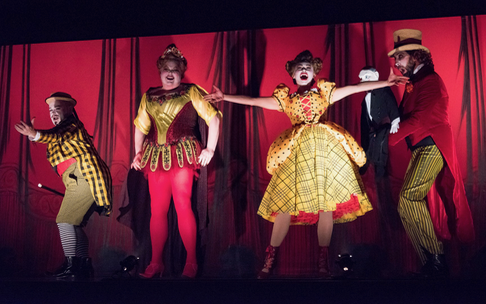 Little Victor Farrell (tenor Jason Ferrante), Doris the Wire Walker (mezzo-soprano Melissa Parks), Aveline Mortimer the Wide-Eyed Warbler (soprano Deanna Breiwick), and Uncle (bass Matt Boehler) entertain the crowd with a variety show.
Little Victor Farrell (tenor Jason Ferrante), Doris the Wire Walker (mezzo-soprano Melissa Parks), Aveline Mortimer the Wide-Eyed Warbler (soprano Deanna Breiwick), and Uncle (bass Matt Boehler) entertain the crowd with a variety show.
Threatening to run away with the show, tenor Joseph Gaines is a tour de force as the wiry, wily Dan Leno. Mr. Gaines is arguably one of the finest, most complete singing actors in opera today, and he commanded attention whenever he was on stage. Assuming any number of guises (including uninhibited drag) as a headliner in the music hall segments, he is agile, fleet-footed, energetic and wickedly entertaining. When he drops his performer persona and becomes Leno the man, he is equally capable of engaging our attention with warmly communicated humanity. Moreover, Joe has a wonderfully schooled, innately appealing tenor that is capable of lyricism of considerable beauty.
Troy Cook was a powerhouse vocal presence as the duplicitous (or is he?) John Cree, who woos and weds Elizabeth. Mr. Cook lets loose with such a darkly powerful baritone that his singing is literally spine tingling in several rather malevolent moments, memorable for their uncompromising, laser like intensity. But is he indeed the victimizer, or might he be a victim? His well-modulated, charming vocalization in more lyrical passages not only provides a good measure of vocal allure, but also raises the stakes in a deadly and unpredictable game.
It is always a pleasure to encounter the gifted young baritone Daniel Belcher, and he predictably delivers all the goods as Inspector Kildare. Mr. Belcher finds an assertive smugness to color his ringing baritone, and his self-assured, poised singing was even and focused throughout the range. Moreover, he conveyed a seductive wit in his impersonation of the self-promoting detective. Deanna Breiwick deployed her alluring, silvery soprano to good effect as the ingénue, Aveline Mortimer, singing with utmost assurance, especially in several sublime stratospheric flights of fancy. Ms. Breiwick also injected some real grit and passion into the mix with her determined, vengeful testimony at Elizabeth’s trial.
Elizabeth begins her escape from poverty by getting a job as a prompter at the music hall, where other on- and backstage denizens include Uncle (firmly intoned by bass Matt Boehler), Doris (Melissa Parks, showing off an earthy and rock solid mezzo), and Little Victor Farrell (Jason Ferrante, with a sympathetic tenor of good presence). A prodigiously talented roster of soloists rounded out the cast, successfully doubling all of the other parts. Jonathan McCullough (Mr. Greatorex/George Gissing/Etcher) offered a baritone of solid accomplishment; Thomas Shivone (Mr. Lister/Karl Marx/Solomon) scored with his substantial bass-baritone; Daniel Taylor (Priest/Librarian/Mr. Gerard) proved a mellifluous bass talent you should watch for; and Maren Montalbano (Jane Quig/Annie the Serving Girl) completed the impressive cast with her pleasant, pliant mezzo.
Conductor Corrado Rovaris clearly relished his assignment and led the new composition with sweeping passion, dramatic investment, abundant lyricism, and great attention to detail. Mr. Puts’ lean orchestration utilizes an intriguing array of colors and inventive combinations of sound palettes and effects. Maestro Rovaris has wrung every last bit of variety out of the score, seguing effortlessly from neo-Romanticism to Grand Guignol to popular novelty numbers to wrenching scenas and back again. His total command of the musical effects yielded an eminently satisfying piece of lyric theatre.
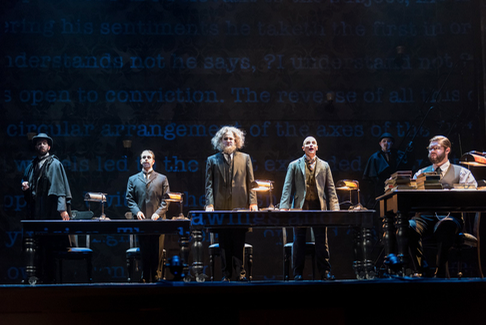 The inhabitants of the Reading Room continue their studies.
The inhabitants of the Reading Room continue their studies.
Mr. Campbell’s episodic hopscotch of a book jumped back and forth in time from courtroom to street, music hall (on stage and backstage), prison, home, police headquarters, well, you get the idea. Director David Schweitzer paced the show immaculately, investing it with fluidity and variety. For the music hall numbers,
Jesse Robb contributed simple, effective choreography. Mr. Schweitzer and his design team made some excellent choices in the simple floor plan, and bold choices in the omnipresent, often disturbing projections and stunningly wide-ranging lighting design by Alexander V. Nichols.
Designer David Zinn’s atmospheric sets were beautifully evocative, with a superbly textured arrangement of walls. A semi-circle of dipping streetlights is affixed to the one furthest upstage. This playing space was complemented by carefully chosen set pieces (desk, chairs, make-up tables, etc.). A platform with a rolling ladder has a perch atop that is at once imposing and frightening in its great height. A show curtain flew in and out to create the onstage world of the music hall. In the last third of the show, a wall surprisingly opened stage right to reveal the Cree’s rich, red Victorian parlor, while three tables were placed left to create the reading room of the British Library.
Director Schweitzer moved his actors meaningfully through their paces not only emoting and relating in these various short scenes but also carefully staged to seamlessly change the settings. Mr. Zinn also contributed sumptuous costumes running the gamut from ravishing upper crust eveningwear to garish parodies of variety show costumes. David Zimmerman did yeoman’s duty designing the varied hair and make-up looks required.
Opera Philadelphia’s Elizabeth Cree represented a thrilling collaborative effort from a dream team of some of the world’s most accomplished music and theatre practitioners. Their concerted efforts have made a compelling case for this highly anticipated piece, which assuredly deserves a bright future of subsequent productions.
James Sohre
Cast and production information:
Elizabeth Cree
Music by Kevin Puts
Libretto by Mark Campbell
Elizabeth Cree: Daniela Mack; John Cree: Troy Cook; Dan Leno: Joseph Gaines; Inspector Kildare: Daniel Belcher; Aveline Mortimer: Deanna Breiwick; Uncle: Matt Boehler; Doris: Melissa Parks; Little Victor Farrell: Jason Ferrante; Mr. Greatorex/George Gissing/Etcher: Jonathan McCullough; Mr. Lister/Karl Marx/Solomon Weil: Thomas Shivone; Jane Quig/Annie the Serving Girl: Maren Montalbano; Priest/Librarian/Mr. Gerard: Daniel Taylor; Conductor: Corrado Rovaris; Director: David Schweitzer; Set and Costume Design: David Zinn; Lighting and Projection Design: Alexander V. Nichols; Wig and Make-up Design: David Zimmerman; Choreographer: Jesse Robb.
image=http://www.operatoday.com/Philly_OT4.png
product=yes
product_title=Elizabeth Cree at Opera Philadelphia
product_by=A review by James Sohre
product_id=Above: Daniela Mack as Elizabeth Cree, Troy Cook as John Cree [All photos courtesy of Opera Philadelphia]
Mansfield Park at The Grange
I’m not sure how many of the audience at The Grange for the first of two performances of Jonathan Dove’s opera were Austen aficionados but the foot-stamping reception that the full house gave the composer’s newly orchestrated opera suggested that they thought he’d told a good tale. Indeed, Dove and his librettist Alasdair Middleton, did provide us with a charming entertainment which was stylishly and slickly staged by director Martin Lloyd-Evans and designer Dick Bird, and I was undoubtedly in a minority, though not wholly alone, in finding the opera more divertissement than drama.
Alasdair Middleton has drawn his libretto, largely, from Austen’s text but the necessary omission of characters and incidents transforms what is often seen by literary critics as a ‘problem novel’ into a comedy of manners whose satire has been diluted. Little of the ‘darkness’ of the novel is retained in the opera, and even when the protagonists undergo trials and tribulations in the second act, the superficial characterisation of the opening act prevents them acquiring a convincing tragic dimension.
There is little sense, for example, of the fear or passivity that Sir Thomas Bertram’s autocracy inspires, and while Lady Bertram is appropriately obsessed with her pug, unlike Austen’s original she is not sluggish and distracted, rather as garrulous and assertive as Emma’s Miss Bates, and she joins in the family theatricals and dancing with sprightly spryness.
We have none of the preparative ‘back story’, which explains how Fanny Price came to live in her uncle’s house, along with Aunt Norris, and other than a brief allusion to Edward Bertram’s kindness to his young cousin, there is little to establish the nature of Fanny’s ‘role’ in the household - that is, to elevate her cousins by mere fact of her own lowly presence as an ‘interesting object’. Thus, the aristocrats’ ‘benevolent plan’ is deprived of its underlying self-serving motivations and Austen’s jibe that aristocratic compassion is designed to benefit the benefactors is weakened.
In particular, there is none of Austen’s bittersweet irony; and, none of what one critic describes as the novel’s ‘defiant potential’, reflecting the debate between those who see Austen as a defender of the moral status quo and those who see her as a satirical critic of the hypocritical social mores of her day.
In the opera, Maria’s delight at the prospect of wedlock - “I’m going to marry a country seat” - is not dented, nor the audience’s laughter diminished, by her brother Edmund’s observation that, “If this man had not twelve thousand a year, he would be a very stupid fellow”. And, when - declining the opportunity offered by her father to extricate herself from a lamented engagement - she admits that she has traded personal desire and fulfilment for a Wimpole Street abode and £20,000 a year because marriage to the weak-willed Rushworth will afford her “independence”, Austen’s irony, even anger, at the insincerity of the notion that such social contracts are ‘democratic’ is wholly absent.
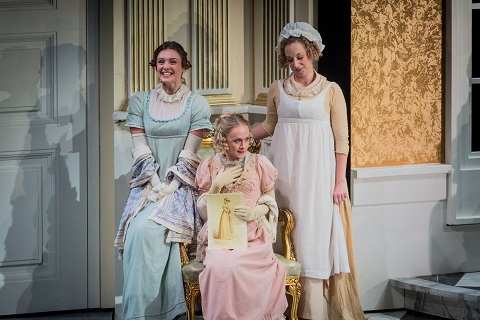 Angharad Lyddon (Julia Bertram), Emily Vine (Maria Bertram), Martha Jones (Fanny Price). Photo credit: Robert Workman.
Angharad Lyddon (Julia Bertram), Emily Vine (Maria Bertram), Martha Jones (Fanny Price). Photo credit: Robert Workman.
The omission of the Portsmouth episode deprives us of the symbolic opposition of town and country, of artifice and nature. Moreover, Fanny’s passivity, physical frailty and moral stasis - Kingsley Amis condemned her as a ‘monster of complacency and pride’ - are not subject to scrutiny; as a result, her unwillingness to cross the ha-ha at Sotherton lacks figurative weight. Edmund’s explanation to the rebellious Mary Crawford that, “Every sort of exercise fatigues [Fanny] so soon, except riding” is retained but, deprived of context, we do not infer Austen’s criticism of Fanny’s unwillingness to act or change. Given the largest vocal role, Fanny assumes a centrality and ‘moral rightness’ which she does not possess in the novel, and this is exacerbated when Henry Crawford reprises her words at the end of the opera: “We have all a better guide in ourselves, if we would attend to it, than any other person can be.”
There are some effective comic gestures and witty ensembles - the dining room scene, ‘Landscape Gardening’, in which the Bertrams evince an unnaturally vigorous enthusiasm to visit Sotherton to help the hapless Mr Rushworth get his natural vegetation under control was deftly done, for example. The amateur dramatics are made foolishly melodramatic by the emotive rendition of the vivid ensemble, ‘Lovers’ Vows’. But, I found many of the episodes more twee than Albert Herring - which, ironically, was the opera which Britten composed when he’d abandoned his own plan to compose an opera on Mansfield Park, and which does subsume some of the probing satire of Maupassant’s original short story from which it is derived.
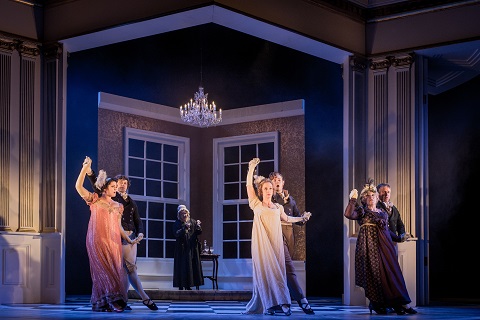 Shelley Jackson (Mary Crawford), Henry Neill (Edmund Bertram), Jeni Bern (Aunt Norris), Martha Jones (Fanny Price), Nick Pritchard (Henry Crawford), Sarah Pring (Lady Bertram), Grant Doyle (Sir Thomas Bertram). Photo credit: Robert Workman.
Shelley Jackson (Mary Crawford), Henry Neill (Edmund Bertram), Jeni Bern (Aunt Norris), Martha Jones (Fanny Price), Nick Pritchard (Henry Crawford), Sarah Pring (Lady Bertram), Grant Doyle (Sir Thomas Bertram). Photo credit: Robert Workman.
Perhaps I would have been less troubled by such matters had Dove’s score held my attention more persuasively. Mansfield Park was commissioned by Heritage Opera in 2011 and was originally scored for piano four-hands (this version was reviewed by Opera Today when it was revived by Hampstead Garden Opera in 2013). At The Grange, it was performed in a newly orchestrated version for a chamber ensemble of 13 players (commissioned by The Grange Festival).
There is no doubting the composer’s ability to set text in naturalistic vocal rhythms, and to create the sort of spare orchestral textures - often just a single bassoon or piano line - which allow the words to be readily discerned. The result is fluent theatre but also a certain predictability: the vocal melodies run a predictable course; the instrumental patterns and ostinatos recur and persist. Growing tension is sign-posted by increasingly deafening timpani pounding accompanied by large vocal leaps. There are passages that sound like Britten, others that resemble Sondheim.
I heard ‘Andrew Lloyd Webber’ on the lips of more than one audience member, and while there may be nothing wrong with being mentioned alongside the master of music theatre, I sensed that the comments reflected a perceived lack of harmonic and structural sophistication, with which I would concur. The waltzes of the ballroom scene spun over a descending ground bass which put me in mind of Pachelbel’s Canon. Perhaps the neoclassicism was an apt idiom for both the narrative and our performance venue, but the endless arpeggiations and dance forms became tiresome.
As we swept through the narrative - each ‘chapter’ introduced by a choric, or occasionally solo, summary pronouncement - I longed for some spaciousness in which character and emotion could develop: the equivalent of Austen’s penetrating focalisation. The characters exchanged bon mots with rapidity and the first act contained scarcely a single ‘aria moment’, although Fanny, disappointingly deprived of the opportunity to express her inner life more fully in the ‘Wilderness’ scene, was given a moment of exposition in Act Two. A ‘letter scene’ briskly dashes through the latter events of the novel, effectively suggesting simultaneity of action but glossing over the sort of discerning character motivation which might make the happy ending more probable and persuasive. In the final scene, the characters collectively declaim the opening of Austen’s final chapter: “Let other pens dwell on guilt and misery. I quit such odious subjects as soon as I can, impatient to restore everybody, not greatly in fault themselves, to tolerable comfort, and to have done with all the rest.” The dismissal of ‘disorder’ did indeed feel rather hasty.
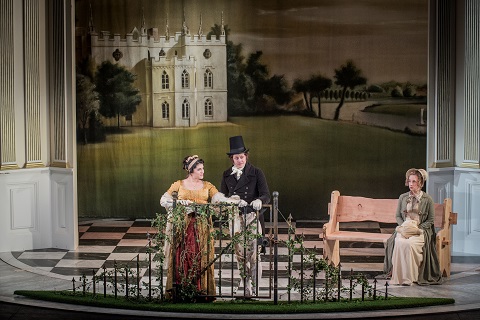 'The Wilderness'. Photo credit: Robert Workman.
'The Wilderness'. Photo credit: Robert Workman.
However, as I said at the start of this review, my misgivings about the opera itself were apparently not shared by the majority of the audience, and their pleasure was in no small part occasioned by Lloyd-Evans’ astute, efficient direction and Bird’s charming design. Two imposing Classical pillars (a nod to The Grange’s imitation Greek Temple façade) positioned at the edge of a revolving set, contained their own revolving exterior/interior, allowing for fluent, often beguiling, transitions from lounge to lawn, and from sunshine to starlight. Sotherton’s ‘wilderness’, with its back-cloth vista à la Gainsborough, was especially elegant.
The cast, too, acquitted themselves very well. Emily Vine sparkled as the ever more impetuous Maria; as her sister, Julia, Angharad Lyddon’s lyrical mezzo almost burst with excitement at the pleasure inspired by the thought of owning a barouche. Shelley Jackson’s big, forceful soprano was the perfect conduit for Mary Crawford’s self-confidence and thrill-seeking, while Martha Jones effectively projected Fanny Price’s combination of righteousness and reluctance.
Henry Neill acted superbly as the caring but unknowing Edmund Bertram; his strong baritone imbued the ‘younger son’ with moral maturity. Nick Pritchard, too, made as much as he could of the caddish Henry Crawford, while Oliver Johnston convinced in his sometimes poignant portrayal of the ineffectual and foolish Mr Rushworth who nevertheless does all he can to please his ungrateful, and unaffectionate, wife.
Grant Doyle exuded imperious authority as Sir Thomas Bertram - who, Austen tells us, ‘had never seemed the friend of [his children’s] pleasures - thundering one-word commands and declarations: “Antigua. Sugar. Bristol. Plantation. Profit. Freight. Profit. Pride. Position. Posterity. Estate.” I did not care for Sarah Pring’s interpretation of Lady Bertram, but she relished her one-liners - “pug is getting peaky” - and her full mezzo assisted her ‘larger than life’ portrayal. Jeni Bern didn’t seem anywhere near snide enough as Mrs Norris, but she slipped neatly into the ensembles.
Claire Seymour
Jonathan Dove: Mansfield Park
Fanny Price - Martha Jones, Mary Crawford - Shelley Jackson, Henry Crawford - Nick Pritchard, Edmund Bertram - Henry Neill, Maria Bertram - Emily Vine, Mr Rushworth - Oliver Johnston, Julia Bertram - Angharad Lyddon, Sir Thomas Bertram - Grant Doyle, Lady Bertram - Sarah Pring, Aunt Norris - Jeni Bern; Director - Martin Lloyd-Evans, Conductor - David Parry, Set Designer - Dick Bird, Lighting Designer - Howard Hudson, Choreography - Mandy Demetriou, Orchestra (members of the Bournemouth Symphony Orchestra and students of Trinity Laban).
Grange Festival Opera at The Grange, Hampshire; Saturday 16th September 2017.
image=http://www.operatoday.com/Mansfield%20Park%20Robert%20Workman.jpg image_description=Mansfield Park at The Grange product=yes product_title=Mansfield Park at The Grange product_by=A review by Claire Seymour product_id=Above: The cast of Mansfield ParkPhoto credit: Robert Workman
September 15, 2017
Elektra in San Francisco
Among the accomplishments of the Gockley era was music director Nicola Luisotti's refinement of the San Francisco Opera Orchestra. And perhaps in no other opera can the glories of this superb orchestra shine forth more brilliantly than in Elektra, the Strauss score demanding myriads of colors and masses of volumes to tell its very ugly story.
It is very beautiful music, but unlike bel canto that can tell ugly stories too, Strauss modernism finds its beauty in sonically colorful hues that intensify the human spirit in its most dreadful conflicts (bel canto revels in the voices it uses to overpower conflict). All this Strauss orchestral magnificence was indeed present for this Elektra!
On stage was British stage director Keith Warner’s staging, a co-production with Prague’s National Theatre where the production debuted last year, and with the Karlsruhe (Germany) opera. It is a rarity these days to find a high concept European-style production on the War Memorial stage.
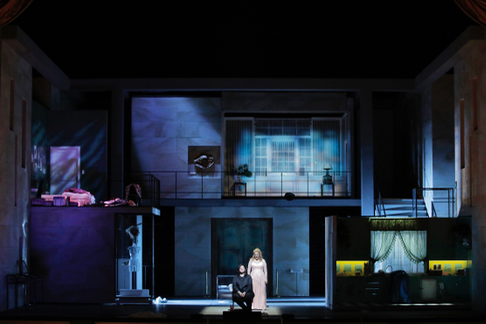 Museum with interpolated bedroom, living room and kitchen of surrogate family
Museum with interpolated bedroom, living room and kitchen of surrogate family
Director Warner set up his concept in the a vista (open-to-view) stage while the audience was finding its way to its seats and reading the program booklet. Those of us who didn’t pay much attention to the open stage and to what we assumed was an over-used Brechtian convention (meaninglessly used in the 2009 Salome as example) had some catching up to do once the opera started. We had no idea that the evening had begun before it began.
But we correctly assumed that the girl dressed all in black was Elektra. Little by little it became clear that the setting was not just a museum but actually an antiquities museum, and the girl dressed in black was going to relive a domestic drama (mother kills the girl’s father), its actors confused between ghosts of antiquity and the actual members of a modern family.
Thus it became a sort of soap-opera docudrama of the Strauss opera that we either enjoyed sorting out, most evidently did, or we did not (I didn’t). Director Warner was so involved creating his concept in a myriad of detail that the idées fixes — the obsessions — of Elektra, Klytemnestra, and Orest simply evaporated into his orgy of storytelling.
In fact Mr. Warner’s Elektra re-creation was so vividly explained that for me it overpowered the splendors emanating from the pit and eviscerated the opera’s usual punch.
The Elektra bar has been set really high in recent productions around the world. San Francisco Opera’s Elektra, American soprano Christine Goerke, kept pace. She is in prime form vocally, and showed herself well capable of withstanding Elektra’s extended vocal tortures with appealing musicianship. If from time to time you wished for a bigger sound you got it when Strauss demanded it. On stage she gamely and convincingly fulfilled director Warner’s idea of a family’s black sheep child in dramatic soprano wolf’s clothing.
Canadian soprano Adrianne Pieczonka is the world’s reigning Chrysothemis. Her voice was of innocent sweetness until she became overwhelmed with Elektra’s demands and then it soared proudly over the hugest orchestral climaxes. She too convincingly and unflinchingly embodied director Warner’s character, complete with little girl mannerisms while hugging her teddy bear.
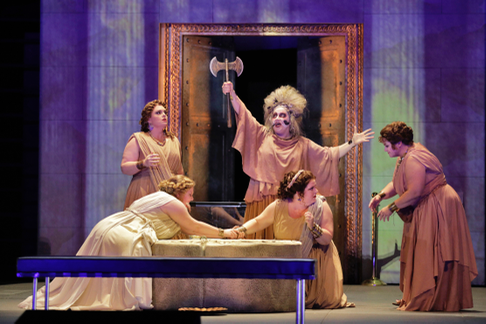 The five Maidservants
The five Maidservants
The five maidservants of the opera’s beginning were splendidly sung once they were allowed on stage (initially they were off-stage, their sound uncomfortably muffled, so that director Warner could make his point that the ghosts of the museum were to come alive).
The balance of the cast was a mixed bag. Stephanie Blithe was to have been the Klytemnestra but she cancelled. Her replacement, Michaela Martens was over-parted in the company of Mmes. Goerke and Pieczonka, as were the Orest of Alfred Walker and the Aegisth of Robert Brubaker.
Young Hungarian conductor Henrik Nánási gave convincing body to the Strauss orchestral score. Note that Mr. Warner’s staging was effected in San Francisco by Anja Kühnhold of the Badisches Staatstheater Karlsruhe.
Michael Milenski
Cast and production information:
Elektra: Christine Goerke; Klytemnestra: Michaela Martens; Chrysothemis: Adrianne Pieczonka; Orest: Alfred Walker; Aegisth: Robert Brubaker; Tutor of Orest: Anthony Reed; Fifth Maidservant: Rhoslyn Jones; The Overseer: Alexandra Loutsion; Maidservant 1: Jill Grove; Maidservant 2: Laura Krumm; Maidservant 3: Nicole Birkland; Maidservant 4: Sarah Cambidge; Klytemnestra’s Trainbearer: Amina Edris; An Old Servant: Bojan Kneževiċ; A Young Servant: Kyle van Schoonhoven; Klytemnestra's Confidante: Erin Neff. San Francisco Opera Orchestra. Conductor: Henrik Nánási; Original Director: Keith Warner; Revival Director: Anja Kühnhold; Set Designer: Boris Kudlička; Costume Designer: Kaspar Glarner; Lighting Designer: John Bishop; Video Designer: Bartek Macias. War Memorial Opera House, San Francisco, September 13, 2017
image=http://www.operatoday.com/Elektra_SFO1.png
product=yes
product_title=Elektra at the San Francisco Opera
product_by=A review by Michael Milenski
product_id=Above: Christine Goerke as Elektra, Adrianne Pieczonka as Chrysothemis [All photos copyright Cory Weaver courtesy of San Franciscod Opera]
September 14, 2017
Mark Padmore on festivals, lieder and musical conversations
Regional music and arts festivals continue to proliferate, so I ask Padmore what it is that makes the four-day festival at Tetbury distinctive, and rewarding for a performer. He explains that he welcomes the opportunity to perform in a beautiful venue, the Georgian Gothic Paris Church of St Mary the Virgin whose magnificent spire dominates the town’s skyline: a venue which, being outside the mainstream of music-making, does not bring with it any particular expectations or conventions, and which will be filled with those who are perhaps not regular concert-goers but are eager for new musical experiences.
Alongside the festival’s four concerts, audiences can enjoy pre-concert interviews and lectures, and prior to Padmore’s recital Dr Natasha Loges, Assistant Head of Programmes at the Royal College of Music, will present a lecture entitled ‘The Hidden Magic of Lieder’. I wonder whether the magic of lieder is really ‘hidden’, and whether it’s especially important to communicate this ‘magic’ to new audiences. Padmore considers that lieder can sometimes be problematic for English audiences, partly because of the language, and recognises the importance of performing in a venue where it’s possible to reach the audience and communicate the meaning of what is often complex poetry - performing Winterreise in the Barbican Hall would be an odd experience, far removed from the context in which Schubert’s cycle was first experienced. He notes that even at the Wigmore Hall, which presents more lieder recitals than any other venue in the world, there seems to be little overlap between those attending chamber music - string quartet concerts, say - and those attending recitals of song; mixed programmes comprising both chamber music and lieder have not always proved popular with audiences.
Perhaps, he reflects, one of the challenges is that with lieder it’s not the voice, or the singer, that is paramount, but the text; and it is not just the voice that communicates that text but the piano also. Padmore feels that this is particularly true in the case of Schumann, whoseDichterliebe he will sing at Tetbury. In Dichterliebe, it is often not the voice that is carrying the melody line - conveying the composer’s messages to his beloved Clara - but the piano, which often rises above the singer (who is essentially supplying the text) and articulates its own arguments. Padmore suggests that there are places where it would be possible, or inviting, to add text to the piano part: that lieder is a ‘speaking art form’.
It is the tenor’s respect for and sensitivity to the text which make him such a superb interpreter of the music of J.S. Bach, and his performances as the Evangelist in Bach’s Passions so compelling - not least in Peter Sellars’s staging, or ‘ritualisation’, of the St Matthew Passion with the Berlin Philharmonic and Sir Simon Rattle which was first seen in 2010 in Salzburg and Berlin and has acquired ‘legendary’ status. Padmore will perform the St Matthew Passion at the Royal Festival Hall in March next year, when he reunites with the Orchestra of the Age of Enlightenment. I note that he is listed as both Evangelist and ‘director’, but he explains that this denotes ‘musical’ director: he will lead rehearsals, encouraging the performers to explore the work, to really listen to each other, so that they can present the Passion without a conductor. This is fundamental to Padmore’s understanding and experience of the Passions. They are chamber music and it is essential that performances are a three-way conversation - between the text, the performers and the audience - in which all three participants are equally engaged. It is not necessary - in fact it can be obstructive - to have a conductor, serving as a source of ‘interpretation’; instead, the empty space which a conductor would usually fill opens up a conduit of communication so that the singers can convey the emotions of the text, and the emotions they feel, directly to the listeners.
Padmore reflects that because the Passions are so well known we have become somewhat inured to listening to Bach. We forget that it is religious music: a recent encounter with a Bach chorus being pumped out as a sort of ecclesiastical muzak in a parish church is one example he cites of its ‘misuse’. We consume the music passively and Padmore wants to break through this passivity: to make the music dynamic and urgent, to make it mean something to the audience, to make them experience the choral cry, ‘Barrabam!’, as a response to Peter’s denial. The word he returns to is ‘attentiveness’: performers and audiences should be attentive, at all times. He comments that Sellars demanded attentiveness to the text at all moments, even visiting the tenor in his dressing room before a performance to talk through the text.
There will be more ‘story-telling’ when Padmore returns to Berlin this season, as Artist in Residence with the Berlin Philharmonic. He will perform Haydn’s Creation in the opening concert of the season and, subsequently, Robert Schumann’s secular oratorio Das Paradies und die Peri, as well as chamber music concerts with members of the Berlin Philharmonic and students of the Karajan Academy. This follows Padmore’s residency with the Bavarian Radio Symphony Orchestra last season and the tenor clearly relishes the opportunity to form a ‘proper relationship’ with an orchestra. He knows the Berliners well and is looking forward to meeting, working and building relationships with the players, developing a communal expression and aiming for performances that are rooted in how we communicate. He will feel ‘at home’; something that, he reflects ruefully, the international system - and perhaps celebrity and success - doesn’t really allow.
Padmore’s season will also include some new compositions. Marking the London Sinfonietta’s 50th anniversary, in June next year the tenor will perform a new chamber piece by Tansy Davies, Cave, written in collaboration with librettist Nick Drake following their 2015 opera Between Worlds. Then, he will take part in a new opera by Thomas Larcher, whose A Padmore Cycle - settings of poems by Hans Aschenwald and Alois Hotschnig - was written for the tenor in 2011.
His performances in Glyndebourne’s 2013 Billy Budd and in George Benjamin’s Written on Skin at the ROH earlier this year were highly acclaimed, and I ask Padmore, such a powerful ‘story-teller’, why he hasn’t been a more frequent visitor to the operatic stage. He explains that, while he loves theatre, he does not feel that there are a lot of roles which are ideal for his voice - before pre-empting my next question by commenting that Aschenbach, in Britten’s Death in Venice is on the horizon! Janáček’s operas are also appealing …
But, before that there is Schubert and Schumann. Audiences in Tetbury, Norwich, Oxford, and overseas can anticipate some compelling musical conversations.
The Tetbury Music Festival runs from 28th September to 1st October.
Claire Seymour
image=http://www.operatoday.com/Mark%20Padmore.jpg image_description=Mark Padmore in conversation product=yes product_title=Mark Padmore in conversation product_by=An interview with Claire Seymour product_id=Above: Mark PadmorePhoto credit: Marco Borggreve
September 13, 2017
Turandot in San Francisco
The hype surrounding the Hockney retrospective just now in Paris, last year in London and soon to arrive at New York’s Met (November 27), and certainly the 2013 Hockney exhibition at SF’s De Young have kept this now 80 year-old icon of canvas painting at the center of the art world’s attention.
Thus there has been excited anticipation of this operatic addition to a Hockney retrospective. His 1992 Turandot burst just now onto the War Memorial stage like it had never before been there. And there are reasons for this perception.
There was a more intense sense of color indeed as the scenic drops had been repainted, plus (and I am surmising) there were (perhaps) more sophisticated lighting instruments in use that brought greater luminosity to color and clarity of shape. [For the record: current SFO lighting designer Gary Marder used the original 1993 lighting plot to light the scenery. Intensities were brightened from those found on a poor quality video of the 1993 production. Newer high-intensity lamps were used to light the actors.]
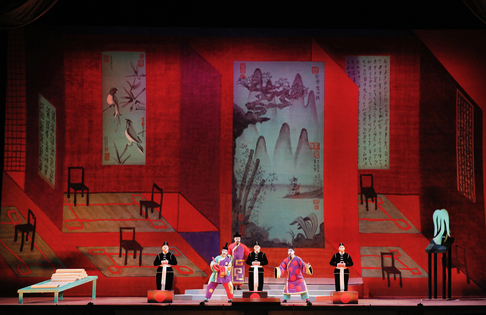 Act II, scene 1. Ping, Pang, Pong, in front of Hockney drop in reverse perspective
Act II, scene 1. Ping, Pang, Pong, in front of Hockney drop in reverse perspective
A more compelling contribution for this new discovery of the Hockney production was conductor Nicola Luisotti who triggered timeless lyricism into the Puccini’s sonically massive score. As David Hockney defies space with his plays of and on perspective, conductor Luisotti made time stand still with tempos and tonalities that dwelt on fixing the specific place and amplifying the immediate emotion — in fact eternalizing the moment. It was an amazing musical feat that intensified the Hockney discovery of the huge spaces and boundless desire.
The opera Turandot is much like what Hockney discovers in his L.A. swimming pools — a magical world of vivid color and commanding shape in which not-so-covert desires dance in motionless forms. That Puccini’s Turandot is dramatically stagnant intrigued Hockney and Luisotti to create Puccini’s opera as a parable of desire extended onto a timeless flat canvas.
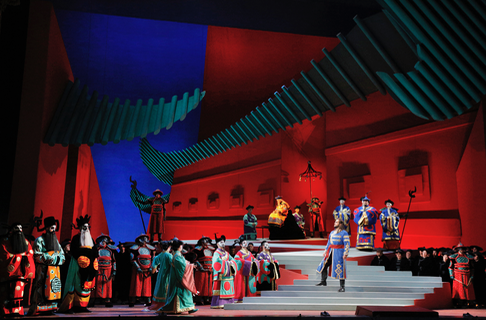 Act II, scene 2. Calaf answering riddles
Act II, scene 2. Calaf answering riddles
As conducted by Luisotti last night the Hockney production proved itself a masterpiece.
Of the cast only Austrian soprano Martina Serafin rose to the level of the production. The 47 year-old diva rang the icy tones of a Turandot isolated in blind revenge until her emotions finally roared forth in unleashed verismo. She and conductor Luisotti musically and dramatically validated Franco Alfano’s controversial conclusion.
American tenor Brian Jagde has finally found his niche as the stentorian Calaf with such tones unrelentingly imposed on Turandot and the Chinese crowds and us. If initially thrilling in effect his clean tone wore as it remained unvaried. This fine, young tenor showed his stylistic limitations in the first act where middle voice strength and emotional mannering make Calaf one of the repertoire’s more challenging roles. Adler Fellow (SFO’s finishing school) Toni Marie Palmertree sang Liu quite beautifully but Liu’s innocence was replaced with the bravura of inexperience.
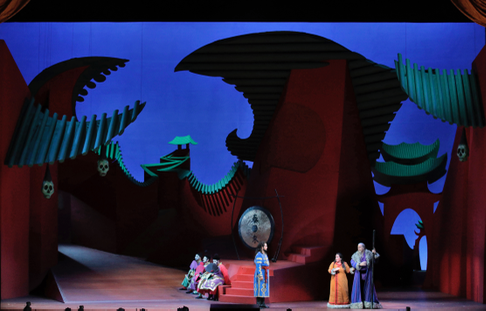 Act 1. Ping, Pang, Pong, Calaf, Liù and Timur
Act 1. Ping, Pang, Pong, Calaf, Liù and Timur
The pathos of Calaf’s father Timur, sung by bass Raymond Aceto, somehow got lost in the melée. Korean baritone Joo Won Kang was a lovely sounding if small voiced Ping, Korean tenor Julius Ahn as Pang added energy to the trio of counselors, and tenor Joel Sorensen as Pong capped the group with infectious gusto. Baritone Robert Brubaker delivered, gratefully, the Emperor Altoum as a dignified, fine voiced father of Turandot.
The huge chorus and the principals were expertly and very beautifully posed and moved about by American regional stage director Garnett Bruce who always respected the flat surface of the stage canvas. He amusingly employed six, mostly-naked senior citizen eunuchs to execute the Prince of Persia and later to remove the dead Liu.
Michael Milenski
Cast and production information:
Turandot: Martina Serafin; Calaf: Brian Jagde; Liù: Toni Marie Palmertree; Timur: Raymond Aceto; Ping: Joo Won Kang; Pang: Julius Ahn; Pong: Joel Sorensen; A Mandarin: Brad Walker; Emperor Altoum: Robert Brubaker. San Francisco Opera Chorus and Orchestra. Conductor: Nicola Luisotti; Production and Design: David Hockney; Director: Garnett Bruce; Costume Designer: Ian Falconer; Original Lighting Designer: Thomas J. Munn; Lighting Designer: Gary Marder; Choreographer: Lawrence Pech. War Memorial Opera House, San Francisco, California, September 12, 2017.
image=http://www.operatoday.com/Turandot17_SF1.png
product=yes
product_title=Turandot at San Francisco Opera
product_by=A review by Michael Milenski
product_id=Above: Martina Serafin as Turandot [All photos copyright Cory Weaver courtesy of San Francisco Operar]
The School of Jealousy: Bampton Classical Opera bring Salieri to London
Second, summer downpours having necessitated removal into the Church of St Mary’s, the nave of which was too small to accommodate BCO’s set, this performance at SJSS provided an opportunity to see the opera as envisaged by director/designer Jeremy Gray, in a simple staging the design of which evoked the requisite air of intrigue and affectation. Certainly, the performance which unfolded fulfilled both my cravings; and Gray’s set - exterior stone becoming luxurious damask wallpaper at the twist of a hinge or two - was beautifully composed and stylishly complemented Vikki Medhurst’s Regency-style costumes. Yet, I came away contemplating the difficulties of giving performances of a work over a time-span of a couple of months in several venues (the opera was performed at Westonbirt School in Gloucestershire in late August) that are so different in dimension, acoustic and practicability.
That’s not to suggest that Bampton’s performance offered anything less than their customary integrity, charm and slickness; just that, I was surprised just how hard it was for the company to reproduce the intimacy and immediacy that was generated inside the beautiful but fairly cramped church at Bampton - through whose roof the deluge dripped courtesy of some lead pilfering shortly before - on a wet July evening when compromise and contingency seemed to inspire a spontaneity and piquancy which was sometimes missing at SJSS.
Bampton Classical Opera have found Salieri’s operatic legacy to be a fruitful source during their forays through the lesser-known repertory of the eighteenth century. The company gave the UK premières of Falstaff in 2003 and two years ago their production of La grotta di Trofonio was richly praised. This year they’ve resurrected an opera, written in 1778, which must have been on Lorenzo da Ponte’s radar when he penned Così fan tutte (or, La scola degli amanti, the librettist’s preferred title), with its jealous rants and rages, amorous criss-crossing, and awkward reconciliations. La scuola de’ gelosi, with several new arias, was the work which inaugurated Emperor Joseph’s new Viennese buffo troupe in 1783. And, the casts of La scuola and Così overlapped: Francesco Benucci was Blasio in Salieri’s opera, and sang Guglielmo inCosì; Francesco Bussani followed his turn as the Count in La Scuola with Don Alfonso in Così. Nancy Storace, a Mozart favourite who created Susanna in Figaro was Salieri’s Countess. [1]
Caterino Mazzolà’s libretto tells of marital discord and dissatisfaction, supplemented with a heavy dose of class snobbery. The grain-dealer Blasio, prone to prowling about in the dark intent on catching his wife Ernestina with a lover, is overcome with paranoid jealousy and purchases a padlock to lock her indoors. Meanwhile, Countess Bandiera pines, jilted by her philandering husband whose chief amusement is wooing the wives of jealous husbands - her indignation deepened by the fact that her husband is wooing a pleb! She disguises herself as a gypsy fortune-teller, reads her husband’s palm and, her identity disclosed, delights in his discomfort. Bourgeoisie and aristocrats mingle and madness ensues - quite literally when Blasio finds in an asylum, witnessing the fate of those whose marriages have been poisoned by mistrust. The Lieutenant advises Blasio and the Countess to get revenge by inciting their spouses’ jealousy. Accusations rile, appearances prove deceptive, apologies follow; eventually, an uneasy social and marital equilibrium is restored.
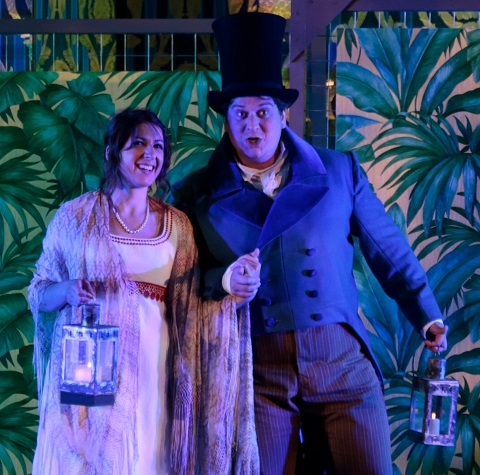 Nathalie Chalkley (Ernestina) and Alessandro Fisher (Count). Photo credit: Anthony Hall/Bampton Classical Opera.
Nathalie Chalkley (Ernestina) and Alessandro Fisher (Count). Photo credit: Anthony Hall/Bampton Classical Opera.
The splendid young cast revelled in the opera’s wiliness and wisdom, although the SJSS acoustic diminished the clarity of the diction, meaning that the wry rhymes of Jeremy Gray’s and Gilly French’s dry, crisp translation raised fewer laughs than they had done at Bampton. But, the obligatory topical references hit the target, as this opera about false affairs inserted some ‘fake news’. When Blasio snatched what he thought was a letter from an admirer from Ernestina’s hands, he found himself reading a newspaper report: ‘Mexico may be blockaded with a wall to stop migration … This may cause some agitation’, and he pondered ‘Is it open to discussion, Mister Trump is surely Russian?’
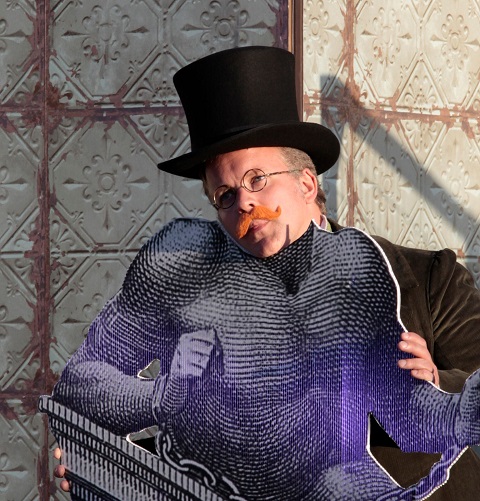 Matthew Sprange (Blasio). Photo credit: Anthony Hall/Bampton Classical Opera.
Matthew Sprange (Blasio). Photo credit: Anthony Hall/Bampton Classical Opera.
At Bampton, Alessandro Fisher’s ‘Casanova’ Count, had made a flamboyant entrance, festooning the ladies of the audience with silver roses as he extolled the gallery of girls whom he likes to goggle: ‘Here you see sophistication; over there is calm and haughty. In another situation, there is one who’s rude and naughty. One is serious, one mysterious; one is slim, another grimmer.’ One cannot but admire Gray and French’s adeptness with telling internal rhyme! SJSS thwarted attempts to make a similarly ingratiating impact here, but Fisher’s performance was confident and consummate: he deserved the applause which his arias kindled.
Matthew Sprange, as Blasio, had the measure of the role’s conversational style and his baritone was focused, the phrases having excellent musical and dramatic direction. Nathalie Chalkley was recovering from flu but this only marginally impinged on her vivacious portrayal of Ernestina’s sassy self-confidence and self-determination. At Bampton, I had found Rhiannon Llewellyn’s intonation occasionally less than centred and I detected a slight breathiness in the ascents; but, here she certainly assailed the top Cs in both her arias with insouciance, though again I felt that she didn’t always nail the true heart of a pitch.
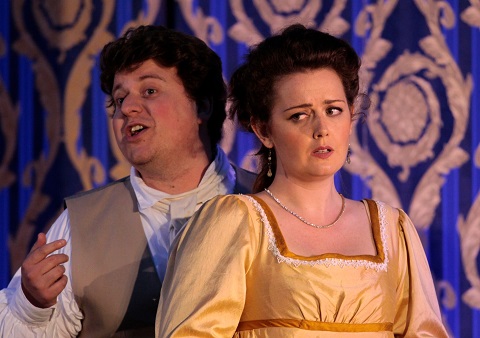 Alessandro Fisher (Count) and Rhiannon Llewellyn (Countess). Photo credit: Anthony Hall/Bampton Classical Opera.
Alessandro Fisher (Count) and Rhiannon Llewellyn (Countess). Photo credit: Anthony Hall/Bampton Classical Opera.
I enjoyed the self-assured eye-brow raising and elegant phrasing of Samuel Pantcheff’s Lumaca (Blasio’s servant) at Bampton and have recently praised Pantcheff’s performances with The Opera Box : here, again, he stood out as a singer-actor who is never switched off, who is constantly seeking to interact with his fellow cast. The intimacy of St Mary’s heightened such interactions with Kate Howden’s Carlotta, the Countess’s maid, yet here the subtleties sometimes didn’t make the same impact; but Howden’s lovely mezzo - full of character, feeling and insight - suggests she is a singer to watch. Thomas Herford pronounced the Lieutenant’s motto of feminine fidelity (anticipating Così’s Don Alfonso?) - ‘Chi vuol nella femmina/ Trovar fedelta,/ La lasci padrona/ Di sua liberta. (He who wishes to find fidelity in a woman should allow her to remain mistress of her liberty) - with elegance, as the libretto’s sole words of dispassionate common sense were contradicted by cynical counter-voice of the ‘cuckolding’ horns.
At Bampton in July, the Orchestra of Bampton Classical Opera were placed in the South Transept and we were able to enjoy the players’ bright sound and Salieri’s noteworthy musical detail. Although in some of the busier ensembles there were a few anxious glances from the cast, seeking confirmation, conductor Anthony Kraus ran a tight ship and the proximity of the orchestral sound added to the zippiness of the performance. At SJSS, with the players of CHROMA seated behind the set and the cast relying on two monitors, the ‘pit’/stage coordination was no less consistent, but there was an understandable sense of ‘playing it safe’: there was less risk-taking in the vibrant act finales, and generally the tempos felt less urgent, the dramatic propulsion less urgent.
The School of Jealousy was the composer’s most oft-performed opera, winning international popularity; when it reached London in 1786, the Musical Post and Daily Advertiser declared it ‘a masterly composition, which does great honour to Salieri’. Thanks are due to Bampton Classical Opera for allowing us to enjoy its charm.
Claire Seymour
Salieri:
The School of Jealousy
Bampton Classical Opera
Blasio - Matthew Sprange, Ernestina - Nathalie Chalkley, Count Bandiera - Alessandro Fisher, Countess Bandiera - Rhiannon Llewellyn, Lumaca - Samuel Pantcheff, Carlotta - Kate Howden, The Lieutenant - Thomas Hereford; director/designer - Jeremy Gray, conductor - Anthony Kraus, costume designer - Vikki Medhurst, CHROMA.
St John’s Smith Square, London; Tuesday 12th September 2017
[1] Bruce Alan Brown and John A. Rice present an informative account of Salieri’s attempts to set da Ponte’s Così libretto, and of the links between theLa scuola de’ gelosi and Mozart’s opera, in ‘Salieri’s Così fan tutte’ in Cambridge Opera Journal Vol.8/1 (March 1996): 17-43.
Photo credit: Anthony Hall/Bampton Classical Opera
Richard Jones' new La bohème opens ROH season
Even before curtain-up, the gently falling snow was sparkling against the black night sky of late-nineteenth century Paris. This is a production which strives to balance ‘realism’ with romance: exquisite design details create verisimilitude, while the visible mechanisms of theatre serve to remind us that we are voyeurs. Occasionally, there are ‘slippages’, as when the candles ‘go out’ in Act 1 but the interior set remains flooded in light as Mimì and Rodolpho scrabble around ‘in the dark’ looking for her keys. But, when the tables of the plush Café Momus push the front-facing diners to the front of the stage, or the duets of Act 3 are repeatedly directed ‘at us’ - through the fourth wall - a distance is established which creates tenderness and poignancy.
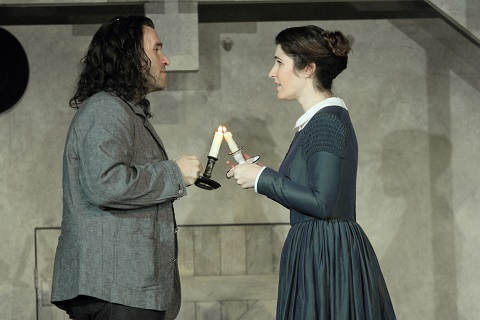 Michael Fabiano (Rodolfo), Nicole Car (Mimì). Photo credit: Catherine Ashmore.
Michael Fabiano (Rodolfo), Nicole Car (Mimì). Photo credit: Catherine Ashmore.
Jones tells the story straight. Act 1 takes us into the eaves of the bohemians’ garret - brutally cross-sectioned in its barren bleakness: a paint-splattered chair and tiny three-legged stool, a cheap violin case, some paint pots and brushes, a brazier which will be fuelled by Rodolfo’s pulped play-script. A ladder protrudes through the skylight which admits the fairy-tale conical moon-beam conjured by lighting designer Mimi Jordan Sherin.
The attic atelier swivels and recedes but remains a shadowy presence in Acts 2 and 3, as Laing whisks us - and the vibrantly attired Christmas Eve revellers - through the glittering arcades of the Quartier Latin to the up-market Café Momus, and finally to the unwelcoming toll gate at the Barrière d’Enfer, through which pedlars enter the city and beside which we witness the contrasting couples’ squabbles and sweet-talk, as winter presages spring.
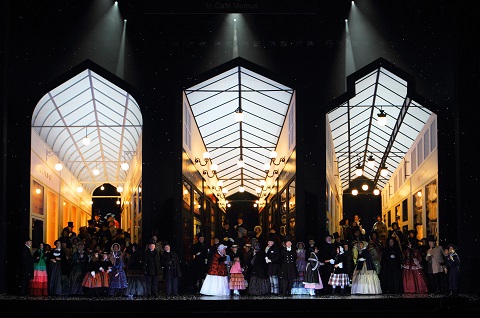 Photo credit: Catherine Ashmore.
Photo credit: Catherine Ashmore.
Some of Jones’ and Laing’s scene shifts have the beguiling enchantment of a Christmas ballet. Money has obviously been lavished on Act 2, and the dazzling lights of the triplet of arcades lure the merrymakers into the parfumerie, cave de vin and Salon de société, before swivelling to make way for the stuccoed-ceiling Café - down-at-heel would-be artists certainly couldn’t afford the cover charge let alone the champagne, so it’s no surprise Alcindoro has to pick up the tab. Later, the Café itself divides and diverges, casting its diners into the night street, where lamplight sentinels illuminate the scarlet splendour of a passing military band.
Act 3’s bare street and isolated tatty tavern emphasises the gaping expanse between love and fulfilment, hope and reality. This is confirmed at the close of the act, when the tavern slides almost imperceptibly across the stage into the blackness, and reinforced by the stab of green light which accompanies the brutal closing chords of Act 3. Act 4 takes us back to the austere attic, where the horse-play has a desperate air as the boys graffiti the beams and bare walls à la Picasso. The light now seems, painfully and ironically, to shine even brighter. But, the shadows cast by the attic beams darken, creating a criss-crossing chiaroscuro which hides the mourners lined against the rear wall, while the dying Mimì is thrust to the fore, into the light.
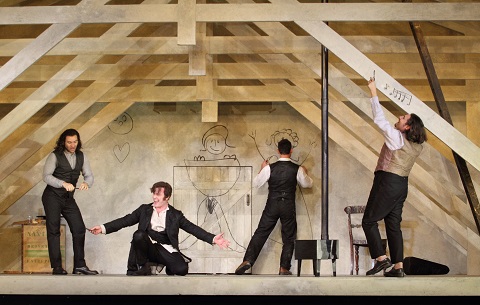 Michael Fabiano (Rodolfo), Luca Tittoto (Colline), Mariusz Kwiecień (Marcello), Florian Sempey (Schaunard). Photo credit: Catherine Ashmore.
Michael Fabiano (Rodolfo), Luca Tittoto (Colline), Mariusz Kwiecień (Marcello), Florian Sempey (Schaunard). Photo credit: Catherine Ashmore.
Though she was dressed like Jane Eyre in an ugly grey frock, and later given a hideous pink bonnet by Rodolfo, Australian soprano Nicole Car was an impetuous Mimì - her bounds of energy matched by bursts of lyricism and vocal bloom. She phrased sensitively and displayed a pure, even tone across the registers. Perhaps a little more variety of vocal colour might have helped to fill out the character, and the same was true for Michael Fabiano’s Rodolfo, who seemed oddly self-absorbed at times - the prone Mimì got a kick rather than a glass of water in Act 1, and this Rodolfo was keener to be consoled by Marcello than to cradle the dying girl in his arms. Fabiano’s tenor was strong and true - ‘Che gelida manina’ won cheers and applause - but needed a little more softness and flexibility to convince that Rodolfo’s heart ruled his head. The ‘supporting’ pair were superb. Mariusz Kwiecień was spared the straggly wigs inflicted on the other men and his characterisation of Marcello also seemed to have more freedom and complexity; his Act 3 duet with Mimì was wonderfully moving. Simona Mihai will take over as Mimì later in the run but here she was a show-stealing Musetta, climbing sassily onto the tables to deliver her risqué waltz - during which she removed her silk knickers to taunt the sulking Marcello - but showing genuine care and compassion in the final act.
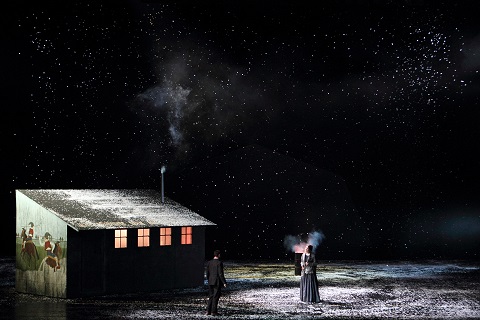 Mariusz Kwiecień (Marcello) and Nicole Car (Mimì). Photo credit: Catherine Ashmore.
Mariusz Kwiecień (Marcello) and Nicole Car (Mimì). Photo credit: Catherine Ashmore.
The rest of the cast sang well but needed more direction from Jones to really make their mark. Florian Sempey’s Schaunard and Luca Tittoto’s Colline sometimes seemed a bit ‘lost’, disappearing into the recesses of the garret, and the boisterous larking about with herring and crayons in Act 4 felt somewhat forced. Wyn Pencarreg’s Alcindoro was a sober figure and Act 2 was thus shorn of some of its fun. And, I must have blinked as I missed the toy-seller Parpignol, though the children of Tiffin School chanted and clamoured brightly.
Antonio Pappano swept things along with characteristic vigour and vitesse but while the bursts of orchestral colour were certainly impassioned and thrilling, after a while it felt a bit too ‘full-on’ and it would have been nice to have time to take in some of the details and subtleties.
However, despite a few small quibbles I enjoyed this performance immensely. John Copley’s La bohème, which has finally been retired, had an astonishingly long life and I wouldn’t be surprised if Jones’ production isn’t similarly enduring.
Claire Seymour
Puccini: La bohème
Mimì - Nicole Car, Rodolfo - Michael Fabiano, Marcello - Mariusz Kwiecień, Musetta - Simona Mihai, Schaunard - Florian Sempey, Colline - Luca Tittoto, Benoît - Jeremy White, Alcindoro - Wyn Pencarreg; Parpignol (A toyseller) - Andrew Macnair, Customs Officer - John Morrissey, Sergeant - Thomas Barnard; Director - Richard Jones, Conductor - Antonio Pappano, Associate director - Elaine Kidd, Designer - Stewart Laing, Lighting designer - Mimi Jordan Sherin, Movement director - Sarah Fahie, Orchestra and Chorus of the Royal Opera House (Chorus director, William Spaulding).
Royal Opera House, Covent Garden, London; Monday 11th September 2017.
image=http://www.operatoday.com/Musetta%20Act%202.jpg image_description=Richard Jones’ La bohème at the Royal Opera House, Covent Garden product=yes product_title=Richard Jones’ La bohème at the Royal Opera House, Covent Garden product_by=A review by Claire Seymour product_id=Above: Simona Mihai (Musetta)Photo credit: Catherine Ashmore
September 12, 2017
Giovanni Simone Mayr: Medea in Corinto
Medea in Corinto (Medea in Corinth, 1813 and much revised over the course of the next ten years) was Mayr’s best-known opera and remained a repertory staple for a time even after his death. It has been revived frequently in our own day, especially in Italy, where audiences can of course follow the plot and shifting emotions without recourse to supertitles.
Mayr’s opera tells basically the same story that opera lovers know from Cherubini’s Médée (a work often performed in a much-altered later version and in Italian, under the title Medea). But the treatment of the Medea legend by Mayr and his librettist, the immensely gifted Felice Romani, is different enough from Cherubini’s that the work has its own identity and appeal.
American Record Guide has reviewed three previous CD releases of Mayr’s Medea in Corinto, the best of which, the reviewers agreed, was the studio recording from Opera Rara, with Jane Eaglen, Yvonne Kenny, Bruce Ford, and Raul Gimenez. (See reviews by, respectively, Desmond Arthur, September/October 1994; Charles H. Parsons, March/April 2000; and Ralph V. Lucano, Nov/Dec 2010.) That recording also included an appendix of additional numbers that were composed by Mayr for the work and that were either omitted before opening night or got used in certain later stagings of the work.
The two other CD recordings that have been reviewed in ARG were made at live performances in Italy. Both of them are apparently disfigured by one or more singers who wobble or sing off-pitch. The Myto set features the vibrant Leyla Gencer in the title role; the Oehms set has Elzbieta Szmytka (overstretched by the part) and can be heard by anybody with online Naxos access (e.g., through one’s public library), as indeed can the recording under review. The pioneering Vanguard recording (1970) stars the magnetic Marisa Galvany. Its CD re-release seems to be out of print at the moment, but excerpts are on YouTube.
In this opera, the princess of Corinth (here called Creusa) was promised to King Aegeus (Egeo) of Athens, before she shifted her affections to the heroic Giasone. Egeo has a big and dramatically varied role. Medea is given a powerful scene with the spirits of hell (reminiscent of a scene in Cavalli’s Giasone, composed a century and a half earlier).
Romani and Mayr give the chorus multiple occasions to rejoice, reassure, worry, and be solemn or horrified. (In this new recording they sound fine, mostly, except for some reason in the scene with Creusa at the beginning of Act 2.) The orchestra frequently offers colorful interjections: we get several arias in which a solo instrument (e.g., violin, English horn, even harp) performs in duet texture with the voice or in alternation with it.
As in many of Rossini’s serious operas, recitatives are accompanied by orchestra rather than keyboard. The Medea/Giasone duet in Act 1 is a large four-movement structure of a type that scholars and critics normally call “Rossinian” and would become normative for Rossini’s successors: Donizetti, Bellini, and the young Verdi. Vocal lines are quite florid (not least for Egeo) but often also tuneful or even dance-like, sometimes reminding me of Donizetti (to come) or of phrases from Mozart’s Così fan tutte and The Magic Flute (some twenty years earlier).
The recording derives from one or more staged performances at the Valle d’Itria festival in July-August 2015. Inevitably, the performances on the Opera Rara studio recording are freer of imperfections. In this festival recording we encounter moments of orchestral unease and some slow wobbling from the Medea and (worse) the Creusa. The sound quality, generally fine, can get congested when Davinia Rodriguez (Medea) and Michael Spyres (Giasone), both intense-voiced, are singing simultaneously. Rodriguez’s lower register is consistently hooded, sometimes sounding very Callas-like, which may displease some listeners but, to my ear, aptly indicates Medea’s grim determination to avenge herself on the lover who abandoned her. Indeed, Rodriguez seems to me a more convincing Medea than Eaglen was on the Opera Rara recording, and the chorus of the spirits of hell register more vividly here in the splendid conjuration scene (“Antica notte”) than on the Opera Rara recording.
Spyres has now performed or recorded numerous French heroic-tenor roles, including Rossini’s Arnold and Berlioz’s Cellini. (He sings splendidly on the new recording of Hérold’s Le pré aux clercs, which I will be reviewing here soon.) As Giasone he is often utterly admirable, showing great stamina and presence. But he sometimes strains, at full voice, for high notes that, in Mayr’s day, would have been sung in falsetto or half-voice. And, quite unnecessarily, he adds several notes that are higher than anything written by the composer, and has to lunge for them, making him sound, at that moment, less than heroic. His coloratura is sometimes firm, other times ungainly. Still, he sings consistently in tune.
Indeed, all the singers sing in tune. Furthermore, they put the words across well, which helps us care about the characters’ shifting emotional states. The renowned Fabio Luisi conducts expertly, blending dramatic impetus with delicacy and precision. By comparison, David Parry’s conducting on the Opera Rara recording sometimes feels sluggish and unvaried.
The booklet essay is enormously detailed about the compositional and performance history of the work but gives no indication what version is being heard here and whether any of the numbers differ from the equivalent ones on previous recordings.
I had no trouble downloading the libretto, but then struggled through some unidiomatic or even outright erroneous translations. For example, talamo—literally: “chamber”—is the standard libretto-word for “marriage bed.” It is here translated as “thalamus,” as if the characters were discussing the function of somebody’s brain. The booklet essay is similarly disfigured. I suggest that Dynamic hire better translators, perhaps ones who are native English-speakers.
A DVD of this same performance is also commercially available and has been uploaded to YouTube. One can also purchase a DVD of a 2010 staged performance from Munich, with what—to judge by excerpts on YouTube—is a splendid cast (Medea: Nadja Michael; Giasone: Ramon Vargas; Egeo: Alek Shrader). Watching either of the videos. or listening to the CD set under review, would be the best way to get to know Mayr’s famous opera. The Opera Rara recording, despite much first-rate singing (e.g., from Bruce Ford as Giasone), now slides down to second-best. Still, it remains indispensable for people who wish to compare Mayr’s various revisions, cuts, and insertions. It is currently available only as a digital MP3 download (in any of three formats), not as a CD set. It has also been uploaded entire (and also as separate tracks) to YouTube.
Ralph P. Locke
The above review is a lightly revised version of one that first appeared in American Record Guide and appears here by kind permission.
Ralph P. Locke is emeritus professor of musicology at the University of Rochester’s Eastman School of Music. Six of his articles have won the ASCAP-Deems Taylor Award for excellence in writing about music. His most recent two books are Musical Exoticism: Images and Reflections and Music and the Exotic from the Renaissance to Mozart (both Cambridge University Press). The first is now available in paperback, and the second soon will be (and is also available as an e-book).
image=http://www.operatoday.com/Mayr_Medea.png image_description=Mayr, Giovanni Simone: Medea in Corinto product=yes product_title=Giovanni Simone Mayr: Medea in Corinto product_by=Davinia Rodriguez (Medea), Mihaela Marcu (Creusa), Michael Spyres (Giasone), Enea Scala (Egeo), Roberto Lorenzi (Creonte), Paolo Cauteruccio (Evandro), Nozomi Kato (Ismene), Marco Stefani (Tideo). Orchestra Internazionale d’Italia and Transylvanian State Philharmonic Chorus (Cluj-Napoca), conducted by Fabio Luisi. product_id=Dynamic CDS7735 [2CDs] | 37735 [2DVDs] price=$28.40 product_url=https://www.amazon.com/Giovanni-Simone-Mayr-Medea-Corinto/dp/B01EBNVJD8/ref=as_sl_pc_tf_til?tag=operatoday-20&linkCode=w00&linkId=b3590a4b485039c9110b50a34a6079be&creativeASIN=B01EBNVJD8
September 10, 2017
Robin Tritschler and Julius Drake open
Wigmore Hall's 2017/18 season
In fact, John Gilhooly, the Director of the Wigmore Hall, looked surprisingly relaxed on Saturday evening at the opening recital of the 2017/18 season - but, then, well he might since he had been fortunate in having Irish tenor Robin Tritschler available and willing to slip into the shoes left vacant by Canadian baritone Gerald Finley, and pianist Julius Drake at hand to emit his customary air of consummate equanimity and banish any hint of urgency or nervousness.
It’s not the first time that Tritschler has come to the Wigmore Hall’s rescue at such short notice: in April 2016 he deputised for the indisposed John Mark Ainsley, stepping in at the last minute to perform a lunchtime recital of twentieth-century British song alongside pianist Gary Matthewman. On this occasion, Tritschler’s programme replicated Finley’s planned trajectory from Schubert to Britten by way of Ravel, with Schumann’s Liederkreis replacing Poulenc’s Le bestiaire and Turnage’s Three Songs for baritone.
Tritschler is an eloquent performer. It’s a somewhat hackneyed adjective, liberally used by reviewers; but, in this case it is an apt word to denote Tritschler’s ‘clean’ fresh tone, direct and unmannered delivery, very clearly enunciated diction, thoughtfully considered and stylish phrasing, and poised stage presence.
These qualities were put to fullest expressive effect in the concluding item of the programme, Britten’s Winter Words of 1953, in which Tritschler’s understated articulateness powerfully evoked the mood of nostalgia, perhaps regret, and quiet reflection, or perhaps a more bitter loss, that is summed up in the opening words - ‘A time there was …’ - of the concluding song of Britten’s cycle, a setting of Thomas Hardy’s poem ‘Before Life and After’. The vocal line is less florid than that in many earlier Britten songs and Tritschler projected the text with particular clarity, aided by Drake’s lean accompanying textures.
The first song in Britten’s sequence, ‘At Day-close in November’, typifies the nostalgia, tinged with a deeper sorrow, with which Hardy reflects on the passing of time. The day is closing, the summer warmth of June has given way to an autumnal November, and the narrator has progressed from childhood to adulthood. The light is ‘abating’ - a verb which suggests a drawing back, slipping away of time, that the poet-narrator is powerless to stop. Although the pine trees were planted by the narrator, he has no sense of ownership or control. Personified, they toss their heads impatiently.
The upward flourishes of Drake’s introduction conveyed the impetuous and passionate drama which is present in the poem, evoking the querulous pitching to and fro of the pine branches which, ‘like waltzers waiting,/ Give their black heads a toss.’ Tritschler’s melodic line undulated gently, suggesting the movement of the ‘late bird’ which drifts across the sky, and the seeping of day into night. There was a real sense of buoyancy and movement in the second stanza, as the beech leaves ‘Float past like specks in the eye’, the dissonances communicating the poet-narrator’s agitation and bitterness, but this quietened as the vocal line descended and the speaker slipped into memories of past days - ‘I set every tree in my June time’. The chordal texture, effective pedalling from Drake and the sweet vocal pianissimo in the final stanza led to a sense of stillness, reflecting the ruminative text which imagines, ‘A time when no tall trees grew here/That none will in time be seen’.
‘Midnight on the Great Western’, which also explores movement - through time and from place to place, as an adult narrator reflects compassionately on a lonely child who is travelling in a third-class railway carriage, to an unknown destination - followed segue. Drake proved a good mimic: the opening chords suggested a locomotive working up steam, before the reverberations gave way to a marked staccato articulation which gathered momentum and motion. Tritschler communicated a strong sense of the distance between the poet and the boy, whose private world he struggles to penetrate, and the penultimate stanza had both an earnestness and an elegiac quality as he pondered the boy’s past and his journey ‘Towards a world unknown’.
The shifting focus of ‘Wagtail and baby’ would have been enhanced by greater variety of vocal colour, but Drake’s accompaniment here and in the ensuing ‘The little old table’ was notable for its clarity despite the constant rapid movement. In ‘The choirmaster’s burial’ Tritschler’s unaccompanied passages were compellingly candid and the voice’s falling melismas beautifully lyrical, while the dense piano textures - weighty chords and arpeggiated figures, cross-rhythms - were never heavy-handed.
Tritschler’s light tenor had no difficulty negotiating the high-lying phrases of ‘Proud songsters’ and ‘At the railway station, Upway’. The latter was recited in unadorned fashion as the texture was pared down, reflecting perhaps the honest innocence of the ‘little boy’s’ words which, as much as his twanging fiddle, reach out and briefly touch, even change, the convict and the constable to whom he plays. Drake’s sustained notes underscored this naivety, contrasting with the vigorous, sardonic rhythms which accompany the convict’s outburst, “This life so free/ Is the thing for me!”
The final song, ‘Before Life and After’, from Hardy’s 1909 collection Time’s Laughing Stocks, makes explicit the central theme of the cycle - namely, the loss of primal innocence - as Hardy yearns back to a time before consciousness, before senses and feelings, a time evoked by Drake’s impassive, repeated, close-positioned root triads at the start. By, the final verse, the dialogue between the voice and piano had escalated in intensity, the voice rising ever higher, until the reiterated question, ‘How long?’ triggered a cascading lament.
Tritschler didn’t quite indulge in a cry of despair. This account of Winter Words had a composed soberness, with no sense of sentimentality, but there was a disturbing sense at the close that darkness might prevail. In the songs which preceded Britten’s settings, however, I’d have liked a greater range of colour and mood - a little more intensity to counter the urbanity, a sense of emotional risk to balance the refinement.
The opening sequence of songs by Schubert began blithely, as if in media res. The vocal line of ‘Die Sterne’ (The stars) was relaxed and flexible, every word made to count. The carefree spirit continued in the piano’s lilting introduction to ‘Alinde’ but Tritschler did not really convey the growing anxiety, even desperation, of the speaker whose beloved fails to arrive and who questions first the reaper, then the fisherman and finally the huntsman: ‘mein Liebchen nicht gesehn?’ (have you not seen my love’, before casting an appeal into the moonlit air, ‘Alinde, Alinde!’ ‘Ständchen’ (Serenade) was fairly brisk, Drake’s accompaniment quite dry - though the pianist’s subtle rubatos were expressive, particularly in the postlude. ‘Die Einsame’ (The recluse) was similarly enriched by Drake’s bass triplets and the piano’s closing descent.
Schumann’s Liederkreis followed and again I found that, while the sequence acquired expressive momentum, it was Drake who was injecting drama into the individual songs, creating trembling tension in ‘Lieb Liebchen, leg’s Händchen aufs Herze mein’ (Lay your hand on my heart, my love) for example, with his pointed staccatos, or building with tender melancholy through ‘Schōne Wiege meiner Leiden’ (Lovely cradle of my sorrow) before an abrupt change of mood when the speaker is assailed by his lover’s bitter words, (With myrtles and roses). ‘Es treibt mich hin’ (I’m driven this way) pushed forward at the close, but the haste was stalled by a lovely stillness at the start of ‘Ich wandelte under den Bäumen’ (I wandered among the trees), the opening verse of which was skilfully shaped by Tritschler. And, if the image of old dreams stealing into the speaker’s heart might have been more laden with haunting emotion then the tenor effected a wonderful diminuendo to capture the birds’ snatching up of the woman’s ‘golden’ words, before withdrawing into introspection at the close. ‘Berg’ und Burgen schau’n herunter’ (Mountains and castles look down) was wistfully dreamy; ‘Anfangs wollt’ ich fast verzagen’ (At first I almost lost heart) characterised by a bewilderment which almost stalled into stasis and silence. Initially, Drake’s accompaniment seemed to burst with exuberance in ‘Mit Myrten und Rosen’ but the tenor line became increasingly reticent when the flowers and the songs they embody ‘lie reticent, as though dead’ and Tritschler’s final words were blanched of warmth and hope, the pale letters in the book whispering ‘with sadness and the breath of love’.
Ravel’s Cinq mélodies populaires grecques opened the second half of the recital in assertive fashion, but were more notable for Tritschler’s lovely floating head voice - in ‘Chanson des cueilleuses de lentisques’ (Song of the lentisk gatherers) especially - than for the sort of colour and drama with which they had been imbued by Christiane Karg at Cadogan Hall two weeks before.
But, it seems mean to quibble. Without Robin Tritschler we might have enjoyed no music at all, and this was an accomplished and self-possessed performance which got the Wigmore Hall’s 2017/18 season off to a lucid and lyrical start.
Claire Seymour
Robin Tritschler (tenor), Julius Drake (piano)
Schubert: ‘Die Sterne’ D939, ‘Alinde’ D904, ‘An die Nachtigall’ D497, Schubert ‘Ständchen’ from Schwanengesang D957, ‘Der Einsame’ D800; Schumann: Liederkreis Op.24; Ravel: Cinq mélodies populaires grecques; Britten: Winter Words Op.52
Wigmore Hall, London; Saturday 9th September 2017
image=http://www.operatoday.com/Tritschler-1-credit-Garreth-Wong-Web-2017-e1490860877261.jpg image_description=Robin Tritschler and Julius Drake open the Wigmore Hall’s 2017/18 season product=yes product_title=Robin Tritschler and Julius Drake open the Wigmore Hall’s 2017/18 season product_by=A review by Claire Seymour product_id=Above: Robin TritschlerPhoto credit: Garreth Wong
The Opera Box at the Brunel Museum
In fact, Brunel’s Grade II* listed Grand Entrance Hall has rung with the sounds of serenades before: as Brunel Museum director Robert Hulse explained during his interval talk, it was the venue for the world’s first underground concert party in 1827. Though its engineering was both remarkable and rock-solid, the Tunnel’s finances were more ropey: the money ran out before the ramps needed for horse-drawn freight had been built and when it finally opened in 1843 it was accessible only to pedestrians.
Ever the showman - and not deterred by the fact that he himself had almost drowned in the shaft when a collapse during construction resulted in a flood that killed six men - Brunel turned the Tunnel into a sort of underground pleasure-garden. Acrobats and singers entertained the millions of Londoners who paid their penny to enter the first ever road tunnel under a river - it became known as the ‘Eighth Wonder of the World’ - and wander through the bazaars, fun fairs and food stalls.
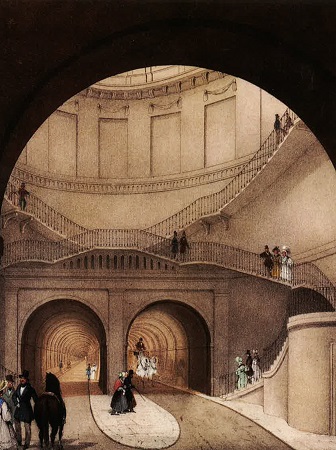 Photo credit: Archive image, Brunel Museum.
Photo credit: Archive image, Brunel Museum.
Then the steam trains came. The Tunnel was purchased in September 1865 by the East London Railway Company and that was the end of the subterranean show business. Until, in 2016, 190 years after construction began, the fitting of a free-standing, cantilevered staircase made the ‘sinking’ shaft accessible to the public once again and London gained a new underground performance space.
On this occasion, The Opera Box had teamed up with The Music Troupe to perform two short operas, as part of the Totally Thames Festival 2017. As music director Edward Lambert seated himself at the piano, I reflected that it must have taken ingenuity of which Brunel himself would have been proud to get the Bechstein down the ‘ship-in-a-bottle’ staircase. But, the new concert space certainly provided Lambert with a fittingly eerie performance space for his new opera, The Oval Portrait, the prose libretto of which is drawn from a short story by Edgar Allan Poe.
‘The Oval Portrait’ is one of Poe’s shortest stories, barely two pages long. A wounded man, the Narrator, seeks shelter in a ruined chateau where he ponders the strange paintings adorning the walls of his room. He is particularly captivated by the astonishing verisimilitude of one portrait, in an oval-shaped frame, depicting a beautiful young girl on the threshold of womanhood. He finds a book under his pillow which tells him that the young bride in the picture was the wife of the painter; she was life-loving, jealous of his art; he was obsessed with capturing her likeness, neglectful of his living wife. Dispirited, she weakened but ‘smiled on and still on’, ever eager to please her husband. When he finally finished the portrait, the painter exclaimed, “This is indeed Life itself!” He turned to his wife, only to find that she had died.
Lambert’s twenty-minute opera has less to say about the tale’s philosophical intimations on the complex relationship between art and life, and is a simpler, cautionary tale. Poe does not give us a ‘moral’ at the close; his story ends abruptly, with the book’s declaration that the painted “turned suddenly to regard his beloved:- She was dead!” Lambert ignores Poe’s essential ambiguity, and gives us an ‘afterword’, the first time the voices of the Narrator and The Book - comprising a chorus of four singers - are overlain:
Narrator: And, as I read how the last brush stroke and the list tint had
taken away the life of the lade of the oval portrait …
The Book: So let it be now that you who have read these words/ And have
gazed on the portrait of the lady shall also die.
So, instead of a reflection on the dangers of aestheticism we have a more straightforward gothic tale. But, the five singers of The Opera Box told this tale effectively. Samuel Pantcheff’s Narrator was intensely, vividly alert. He swept through the lyrical vocal lines with strong characterisation and his diction was impressively clear given the extremely resonant acoustic. In the manner of a Greek chorus, attired in black, ‘The Book’ processed in, smeared their faces with white streaks and then took their places at four music stands to recite the book’s text.
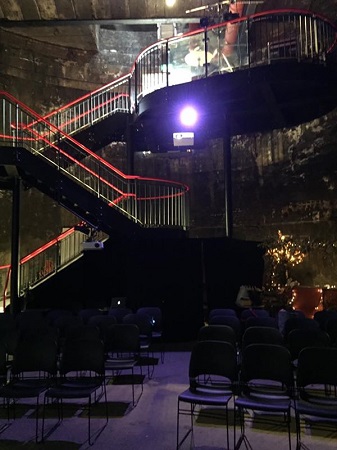 The Grand Entrance Hall, Brunel Museum.
The Grand Entrance Hall, Brunel Museum.
The venue helpfully aided both blend and projection, so it’s difficult to comment on the ‘quality’ of the singing, but the intonation was secure and the delivery compellingly urgent. The Book’s polyphonic opening - rather like a Renaissance motet - was controlled and the entries clear. The homophonic repetitions emphasising the painter’s neglect of his young bride as she sat in the dark turret for many weeks while his gaze was fixed on his easel - he did not see that “the light in that lone turret/ Withered the health and spirits of his bride who pined visibly to all but him.” - became increasingly disturbing, and confirmed Lambert’s effective text-setting.
Lambert’s piano reduction (the work is scored for piano, clarinet, bass clarinet, viola and cello) was evocative, largely comprising extended episodes of contrasting ‘patterns’ - anything from neoclassical Alberti bass-type figuration to Nyman-esque repetitions. At times, the accompaniment seemed rather dense in texture, and the rapid, pounding chords resonated rather too loudly, competing with the rumbles of London Overground trains overhead and leading the singers to push their voices rather too forcefully. I don’t know how much time the company had to rehearsal in the performance space, but a little more consideration might have been given to the effect of the extraordinarily generous acoustic, for the overall sound-mass was occasionally overwhelming.
The same was true for the subsequent performance of Mozart’s Der Schauspieldirektor (The Impresario), in which Lambert’s enthusiastic overture established a dynamic platform from which it was difficult for the singers to retreat, although later arias had greater lucidity. The work was commissioned by Emperor Joseph II to entertain the guests attending a private luncheon in the orangery of Schönbrunn Palace in Vienna, in 1786. A public opera competition was held which both Salieri and Mozart presented one-act operas which took an ironic swipe at the world of opera. Salieri’s opera buffa Prima la musica e poi le parole, which was full of jibes about Mozart’s frequent collaborator Da Ponte, triumphed over Mozart’s Singspiel (the composer called it a ‘comedy with music’).
A parody on the professional and personal vanity of singers and other theatre-folk, Der Schauspieldirektor (given here in a new translation by director Mark Burns, which teases out some topical tropes) presents a theatre director, Mr Frank (Pantcheff), who is having troubled raising funds to engage some new actors. Mr Phil Anthropist (Daniel Joy) promises to help but only if his lover, Madame Heartfelt (Jennifer Witton), can be the prima donna. Along come Miss Silverklang (Elizabeth Karani) and Mr Buff (James Schouten), to vaunt their vocal wares. Exasperated by their egos and eccentricities, Mr Frank is ready to give up but agrees that the audience should decide who should be hired.
Witton coped well with the diva’s challenging runs and hit the stratospheric heights with sparkle, but the acoustic magnified every rough edge on the way up: less really would have been more - the venue would have done all the work. Karani, her fitness-freak challenger, was her match in their vocal duels, displaying lots of vocal colour and evenness across the registers. Exuberantly attired in mis-matched pink, yellow and scarlet Daniel Joy was a self-serving, self-absorbed ‘philanthropist’ whose appealing tenor was complemented by dramatic nous. I’m not sure I’d describe James Schouten as a buffo bass, but his Mr Buff had plenty of puff and bluff. Pantcheff provided strong focus and presence for the rest of the cast, and his extended stretches of dialogue were fluent and engaging.
There were plentiful gags about singers’ status, salaries and self-love, as well as the relevance of opera in the modern world. But, while Burns can turn out a neat triple-rhyme and tap fruitfully into a contemporary lexicon, his direction made less of an impact. Arias tended to be delivered from the centre of the stage-space, with the rest of the cast manically mincing, arm-waving and engaging in histrionics behind, with little meaningful interaction between them. There was potential here for some really sharp satire and tightly focused drama but, in the event, we had horse-play and lightweight cattiness.
Moreover, the company need to give some thought to what might be termed professional procedures. After Mr Hulse’s interesting but extended mid-way presentation, I assumed that we were ready to get on with the show, especially as we were invited at its conclusion to applaud and welcome back The Opera Box. In the event, another 25 minutes passed before things got underway, during which time a stage-hand had wandered about with some chairs and seemed to be preparing a new set, but got distracted by some friends in the audience. It’s all very well to cultivate a ‘friends and family’ ambience but, given that the costume changes must have taken just a few minutes, when barely 60 minutes of music extends to an event lasting nearly two hours you are in danger of stretching the audience’s patience.
That said, the talented young cast sang and hammed valiantly. The Opera Box put on a good show which was welcomed by an appreciative audience.
Claire Seymour
Edward Lambert - The Oval Portrait: Narrator - Samuel Pantcheff, The Book - Jennifer Witton, Elizabeth Karani, Daniel Joy, James Schouten
Mozart - The Impresario: Madame Heartfelt - Jennifer Witton, Miss Silverklang - Elizabeth Karani, Mr Phil Anthropist - Daniel Joy, Mr Frank - Samuel Pantcheff, Mr Buff - James Schouten
Director - Mark Burns, Music Director/Pianist - Edward Lambert, Lighting Designer - Fridthjofur Thorsteinesson, Assistant Director - Morgan Richards
Brunel Museum, Rotherhithe, London; Thursday 7th September 2017
image=http://www.operatoday.com/Sam%20Pantcheff%20image.jpg image_description=The Opera Box at the Brunel Museum: Lambert’s The Oval Portrait & Mozart’s The Impresario product=yes product_title=The Opera Box at the Brunel Museum: Lambert’s The Oval Portrait & Mozart’s The Impresario product_by=A review by Claire Seymour product_id=Above: Samuel PantcheffPhoto credit: Robert Workman
September 4, 2017
Proms at Wiltons: Eight Songs for a Mad King
Full credit, then, to director Olivia Fuchs, conductor Sian Edwards and the Birmingham Contemporary Music Group for this imaginative, thoughtfully programmed and highly engaging contextualisation of the work - one which gave us not only eight songs for a mad King, but also the songs of the deluded monarch: the music that rings and rages through his mind, heart and soul; real or imagined.
Librettist Randolph Stow explains in the score of Eight Songs that the text was inspired by ‘a miniature mechanical organ playing eight tunes, once the property of George III’. A scrap of paper sold with the organ stated: ‘This organ was George the third for Birds to sing.’ Stow describes how disturbing it was to imagine the King ‘in his purple flannel dressing-gown and ermine night-cap, struggling to teach birds to make the music which he could so rarely torture out of his flute and harpsichord. Or trying to sing with them, in that ravaged voice, made almost inhuman by day-long soliloquies’.
Davies’ score incorporates fragments and allusions to early eighteenth-century and mid-twentieth century popular songs, and so the BCMG’s programme comprised music from the same periods, and contrasted the freedom offered to the soul by the sounds of nature with the constriction and suffering resulting from disruptive human relationships and illness.
Throughout the programme, our Mad King - baritone Marcus Farnsworth - was present at the foot of the concert platform of Wilton’s Music Hall. Strait-jacketed, emitting occasional twitches and moans, he was by turns delighted, distracted and distressed by the sounds he heard. Alone, vulnerable and exposed, this lonely figure seemed to charge us with the same voyeuristic pleasure that his contemporaries took in his fall from grace.
The extended narrative was presented as a continuity, although some disruption and interruption resulted from necessary re-arrangements of the stage. These slight hiatuses, though, did not detract from either the persuasive wholeness and striking intensity of the concept, or the skilfulness of its execution.
Book-ending and infiltrating the ‘prelude’ to Eight Songs - which begins with George in his aviary attempting to teach his birds to sing - was Alaskan-based John Luther Adams’ multi-layered soundscape, songbirds. Perched in the gallery, percussionists Julian Warburton and Steve Gibson provided percussive cracks and rumbles to accompany Tony Robb’s piccolo trills and flutters.
Adams’ work was composed in the 1970s, at which time Messiaen had of course been taking inspiration from birdsong for several decades. Adams has noted that with ‘the self-consciousness of the self-styled young iconoclast’ he deliberately set out to eschew Messiaen’s influence, and we were able to judge for ourselves, for an example of the latter’s own orni-morphism followed. Le merle noir (The Blackbird), composed in 1951 for the Paris Conservatory, explores the way the bird’s song can be not simply portrayed or mimicked but actually grounded in the mechanism and implementation of an instrument itself. Pianist Mark Knoop exploited the composer’s divergent registers to establish the tremulous mood at the start, before flautist Marie-Christine Zupancic delicately crafted the diverse detail of the bird’s ‘cadenzas’.
Though our King had seemed entranced by Adams’ ‘Morningfieldsong’, during Le merle noir his head was bowed and clutched; a figure emerged and seated herself at the front of the stage, wrapping herself in Wilton’s generous red velvet curtain - a figure who, judging from her purple lace, frizzed hair and kohled eyes, had wandered straight from Gay’s Beggar’s Opera. Soprano Jennifer France’s subsequent rendition of the anonymous ballad ‘Mad Maudlin’s Search for Her Tom O’Bedlam’ was highly theatrical. Accompanied by Tom McKinney’s paradoxically elegant guitar, France’s soprano rolled richly around the text. In fact, the latter is almost surreal in its imagery and fragmentation: what are we to make of Mad Maudlin’s claim to have ‘cut mince piece from children’s thighs’, ‘boiled ten thousand harlots’ in a cauldron and ‘beaten The Man in the Moon to powder’.
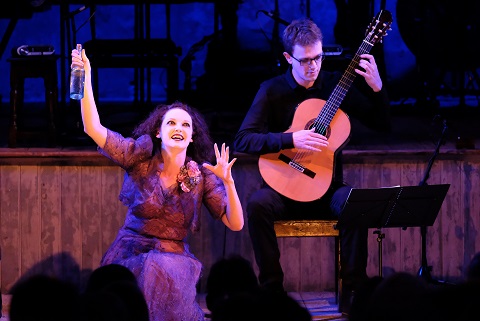 Soprano Jennifer France and guitarist Tom McKinney perform Mad Maudlin's Search for Her Tom O'Bedlam. Photo credit: Mark Allan.
Soprano Jennifer France and guitarist Tom McKinney perform Mad Maudlin's Search for Her Tom O'Bedlam. Photo credit: Mark Allan.
It certainly added to the disorientating strangeness, and the sense of ‘oddness’ continued in Rebecca Saunders’ Molly’s Song 3 - shades of crimson which adds four radio sets to its ensemble of alto flute, viola and steel-stringed acoustic guitar. The music is derived from Molly Bloom’s inner monologue at the close of Joyce’s Ulysses ; in an explanatory note in the score, Saunders explains that Molly’s Song 3 ‘seeks to sustain a musical energy strong enough to with stand the assaults of a succession of destructive events’. It’s certainly fraught and dramatic, the viola player (Christopher Yates) in particular being asked to produce an astonishing array of timbres.
Some soothing balm was administered by France’s charming rendition of Alminera’s aria ‘Augelletti che cantate’ from Handel’s Rinaldo (in 1711 Handel arranged for the release of real birds in the theatre at this point in the opera). She traced a mellifluous line - convincing the King that he had re-gained his Queen - while the flute swept through its virtuosic song.
But, the picture of pastoral peace and emotional reunion was but a cruel illusion. In the closing stanza, France confined the King to his strait-jacket once more. The musicians took their places for Eight Songs, for Davies and Stow intended that the players should be visually present performing music which is both diegetic and non-diegetic, and an exteriorisation of the King’s neuroses.
Much of the work requires the players to improvise from graphic notation and the synchronisation and precision of the BCMG was remarkable, always confident and taut as they moved between pointed unisons and strident dissonances, but bursting with energy too. Even the ‘out-of-phase’ rhythmic disintegrations and fragmentations sound ‘just right’, as the players depicted the dissolution of the King’s mind. In the third song, ‘The Lady -in-Waiting (Miss Musgrave’s Fancy), King and flute duetted in chirrups and tweets with playfulness and freedom. In the climactic ‘Country Dance (Scotch Bonnet)’, after the piano’s opening cocktail bar ‘smooch’, the piano and bass drum hammered terrifyingly as the King grabbed Alexandra Woods’ violin and violently smashed it to smithereens.
The role of the Mad King encompasses more than four octaves and asks the performer to deliver a range of multi-phonics. Farnsworth’s groans, bellows, screams, whispers, gargled phonetic gestures, Sprechstimme and, occasionally, song vividly conveyed the King’s torment. After a brief disappearance, he returned for the ‘Country Dance’, his long-johns and night-shirt now decorated with red feather boa, his lips rouged, for a flamboyant melisma, ‘Comfort Ye’ - a sardonic allusion to Handel’s Messiah, a particular favourite of George III’s - before descending to a disturbing, rasping ‘my people’. Flamboyance was followed by frenzied wrath when the King, unable to join in with the musicians, exploded with frustration; the shattered, forever to be silent violin was a poignant embodiment of his own impotence and irrelevance.
Farnsworth recited the ‘Review’ of his regnum with dignity, but he was a haunting presence, his majesty already obliterated and forgotten. He marched around and out of the Wilton’s auditorium to a merciless, whipped drum-beat - punished, disregarded, elapsed. The empty stage was a reminder of the ‘gap’ between the King’s powerful and pitiful selves, a ‘gap’ into which the King, his two ‘selves’ estranged, plunged into nothingness.
Claire Seymour
Proms at … Wilton’s Music Hall: Jennifer France (soprano), Marcus Farnsworth (baritone), Tom McKinney (guitar), Birmingham Contemporary Music Group, Sian Edwards (conductor), Olivia Fuchs (stage director).
John Luther Adams - songbirdsongs (Morningfieldsong); Olivier Messiaen - Le merle nori; Unknown - Mad Maudlin's Search for Her Tom O'Bedlam; Rebecca Saunders - Molly's Song 3, shades of crimson; Georg Frideric Handel - Rinaldo (‘Augelletti, che cantata’); Adams - songbirdsongs (Meadowdance); Peter Maxwell Davies - Eight Songs for a Mad King
Wilton’s Music Hall, London; Saturday 2nd September 2017 (3pm)
image=http://www.operatoday.com/Baritone%20Marcus%20Farnsworth%20performs%20Peter%20Maxwell%20Davies%27%20Eight%20Songs%20for%20a%20Mad%20King%20at%20Proms%20%20Mark%20Allan.jpg image_description=Proms at Wiltons, Eight Songs for a Mad King product=yes product_title=Proms at Wiltons, Eight Songs for a Mad King product_by=A review by Claire Seymour product_id=Above: Marcus FarnsworthPhoto credit: Mark Allan
Prokofiev: Cantata for the 20th Anniversary of the October Revolution: Gergiev, Mariinsky
Prokofiev's Cantata was dynamite in many ways. It's an explosion of sound so overwhelming that it needs to be detonated in a performance space as vast as the Royal Albert Hall for full effect. It was also dynamite because it was modern in musical terms, while purporting to celebrate increasingly regressive Soviet values. For a while, the Revolution espoused progressive ideas like futurism and modern art, Eisenstein was probably able to get away with radical innovation ten years after 1917. Twenty years later, Prokofiev was not so lucky. His Cantata was suppressed until Prokofiev and his nemesis Josef Stalin had died, ironically within days of one another. Now, a hundred years after the Revolution, we can perhaps assess its impact on Russia and the world. And with Gergiev and the Mariinsky Orchestra and Choir, we probably had the best possible interpreters.
Eisenstein's film, made ten years after the Russian Revolution of 1917, depicted ten critical days in the struggle, starting with the return of Lenin, culminating with the creation of a new Soviet government dedicated to ideals of peace and equality. Prokofiev's Cantata unfolds in ten sections, highlighting themes in the revolution, some with explicit texts, others in more cryptic orchestral form. Prokofiev prefaced the Prelude with a quote from Marx and Engels A Communist Manifesto, "A Spectre is haunting Europe, the Spectre of Communism". Marx and Engels, though, were writing in 1848 when communism was no more than theory. Prokofiev, on the other hand, had personal experience of what a communist revolution could mean. One wonders if he's praising the system or hinting at something darker.
In the second section, the choirs intone "Philosophers have simply explained the world in different ways. The point is to change it". Another equivocal statement that can be read in different ways. Perhaps the setting hides a clue to meaning. Male and female chorus members sing lines that overlap one another, propelled by strict rhythm like the pounding of machinery. Rising anthems in the orchestra suggest patriotic pride, but they're cut apart by an Interlude with jagged angles, and ominous crashing percussion. Perhaps we're in some huge, infernal machine. In the section titled "Marching in Closed Rank", the voices in jerky lockstep, the rhythms are even more pronounced, highlighted with crashing cymbals and brass. The text quotes Lenin "...we are singling ourselves out as a special group who have chosen the path of struggle, not the path of compromise".
Yet Prokofiev follows this with a tiny Interlude of haunting quietness before the voices return, the women apart from the men. The revolution has started but its outcome is by no means certain. Thus rushing, frantic figures, passages where the singing is so fast that, with less articulate voice, the line might collapse. Psychologically true: Trumpets call, metallic bells are beaten. We even hear the hint of ships' bells underlining the reference to "Kronstadt, Vyborg , Revel" (where the Navy mutinied). We even hear the wail of a klaxon - a touch of Edgard Varèse? Though it's probably a natural response to the images of machinery and violence. The suggestion of gunfire hangs heavily over the orchestra.
Victory, at last? The women's voices sing a serene hymn, whose sweeping lines mihght evoke traditional hymns of harvest. The men's voices join in. "The machinery of oppression has been toppled". Yet still Prokofiev paints mechanical processes into his music - the regular tread of machines and processes, the singers clapping their hands in joyless rhythm, the percussion section stamping their feet. A single voice rises from within the closed ranks of the men's choir. "We need the measured tread of the iron battalions of the proletariat". The combined choirs sing a secular hymn of unquestioning obedience to Lenin and his values. The words quote Stalin, whose loyalty to Lenin might not have been as pure as the text suggests.
A section marked "Symphony" follows - flying figures, trumpets and flutes leading forward, the suggestion of pipes and drums, then a semi-pastoral melody, the strings singing as if they were describing fields of corn and a bumper harvest. But grim ostinato intrudes: the timpani growl and the orchestra flies off again in frantic tension. Perhaps in this extended section, with its sophisticated textures and inventive contrasts, Prokofiev is expressing that which cannot be voiced in a totalitarian society. The choirs return, singing in unison, men alternating with women, singing a chorale to words by Stalin, praising the Constitution of the Soviet Union. But in a totalitarian state, constitutional procedures don't guarantee a thing. You could end up in a gulag, as Lina Prokofiev discovered.
So is Prokofiev's Cantata for the Twentieth Anniversary of the October Revolution glorious propaganda? And, if so, for whom and for what purpose? In musical terms it's a lot more sophisticated and subtle than the blatantly crude texts suggest. Was Prokofiev playing a dangerous double game? We may never know, but the Cantata is a lot more than kitsch.
Prokofiev's Cantata received its first public performance in 1966. The following year, the Soviet Republic marked its 50th anniversary with a reissue of Eisenstein's October: Ten Days that Shook The World. A new soundtrack was added, specially written by Dimitri Shostakovich. It's thrilling stuff,. These thoughts absorbed me while listening to Gergiev and the Mariinsky Orchestra perform Dimitri Shostakovich Symphony No.5 in D minor, written at the same time as Prokofiev's Cantata. This was a wildfire hit with the regime, rehabilitating him in their good books. Throughout his career, Shostakovich played cat and mouse with the system, not always in the best interests of his music. This performance was so good that Gergiev rehabilitated it for me: it's not usually my favourite, but this was good. Gergiev's also a champion of the music of Galina Ustvolskaya. Initially, she was in Shostakovich's inner circle but eventually their paths turned apart. Ustvolskaya's music was so uncompromising that it compromised her status in society. Who knows what Prokofiev would have made of her? The Prokofiev that might lurk within this Cantata, that is. Keeping Prokofiev and Shostakovich apart, Tchaikovsky's Piano Concerto No.3 in E flat major with soloist Denis Matsuev.
Anne Ozorio
image=http://www.operatoday.com/Valery%20Gergiev%20conducts%20the%20Mariinsky%20Orchestra%20and%20Mariinsky%20Chorus.jpg
image_description=Prom 68: Sergei Prokofiev, Dmitri Shostakovich, Peter Illych Tchaikowsky, Valery Gergiev, Mariinsky Orchestra and Chorus, Royal Albert Hall, London, 3rd September 2017
product=yes
product_title=Prom 68: Sergei Prokofiev, Dmitri Shostakovich, Peter Illych Tchaikowsky, Valery Gergiev, Mariinsky Orchestra and Chorus, Royal Albert Hall, London, 3rd September 2017
product_by=A review by Anne Ozorio
product_id=Above: Valery Gergiev conducts the Mariinsky Orchestra and Mariinsky Chorus
product=yes
Photo credit: Chris Christodoulou
September 3, 2017
Matthias Goerne: Bach Cantatas for Bass
The highlight of BWV 56 is, for me, the aria ‘Endlich, endlich wird mein Joch’ (At last, at last, my yoke); speaking of the hope found in passing into God’s hands in death, the text describes becoming an “eagle”, finding “strength in the Lord”. Katharina Arfken’s dancing oboe line imbues the aria with an infectious zeal, capturing Bach’s message of hope in the afterlife. The virtuosic melismas of Bach’s solo bass cantatas require an exceptional agility, and Goerne’s hefty and sonorous timbre copes well with the demands of the extensive runs. Goerne and Arfken beautifully accentuate the aria’s sense of dialogue; listen to the powerful projection of the voice followed by the delicate response of the oboe three minutes in. This effectively communicates the image of the burden of life leaving the soul, the pleasing lilt enhanced by the light-footed accompaniment of the Freiburger Barockorchester. The final chorale is equally expressive, communicating the sense of security as the soul reaches its “safe harbour”, although I find the rather forward-placed instrumental accompaniment drowns out the vocal line.
It is one of this cantata’s strengths that Bach sets a text that employs such poetic, even Romantic, imagery. It is not a coincidence that it features an abundance of the pronoun “I”, for Bach’s message is ‘personal’ and Goerne does well to convey the lyrical intensity of the music. Yet the text does not imply lyrical sweetness alone. At the moments when the ambience darkens and the texts speaks of “seas raging and foaming”, I find the resonant, glowing acoustic is to the detriment of the recording, as Goerne’s rich lower registers could perfectly evince the darkness of suffering without the need for such a sepia-toned acoustic. As a result, the occasional harshness that Goerne could have used to convey the pain as well as the hope of the speaker is lost, smudged over by the overly warm acoustic; despite being a cantata about hope in death, I can’t help but feel something is lost when one emphasises the hope alone.
Exploring the similar theme of comfort in death, BWV 82 also features the same exquisite dialogue between oboe and voice that proved a highlight in BWV 56. Here, the ageing Simeon tells of how he recognised Jesus in the Temple, and yearns to die in peace having seen the Messiah; this is a cantata of touching devotion and emotional intensity, which the tonal heft of both Goerne and the oboe communicate well. Indeed, compared to Joshua Rifkin’s release on Decca with The Bach Ensemble, the present recording offers a far richer oboe timbre, whilst the fullness of Goerne’s voice underlines the assuredness that Simeon feels in knowing he can be with God. True, compared to Fischer-Dieskau on Archiv, Goerne is less declamatory in the opening phrases of the aria ‘Ich habe genug’ (I am content); Goerne creates a powerful sense of holding back, evoking Simeon’s sense of acceptance.
As a pupil of Fischer-Dieskau, Goerne has not only adopted his master’s extraordinarily broad repertory (Goerne has already recorded Schubert, Eisler and Mahler-Berio), but he also has his ability to project a powerful narrative. Yet once again, the warm acoustic blurs the expressive nuances of Goerne’s phrasing in the famous aria, ‘Schlummert ein, ihr matten Augen’ (Go to sleep, you weary eyes). Fischer-Dieskau’s Archiv drier acoustic allows for a far greater clarity of text and phrasing; both recordings, however, adopt a faster tempo than Eliot Gardiner’s recording with the Monteverdi Choir, also on Archiv. Gardiner’s slower tempo may better reflect Simeon’s “quiet rest”, but one could argue Goerne’s faster speed better captures his sense of hope.
Although Goerne is central to this disc, the release is not a purely vocal one, making this an enjoyable listen for its generous programming. We are treated to a powerfully expressive Sinfonia. The other instrumental work proved one of the disc’s greatest pleasures: the Concerto for Oboe d’Amore, performed with tremendous skill by Katharina Arfken. Providing a delightful sense of energy that never falls apart into the hectic, these are elegant readings that convey Bach’s own sense of pleasure; one can detect the sense of spontaneity and invention that must surely have created an exciting atmosphere around the master when he was at work. Whether evoking a dance or a lament, this is powerfully emotive and affective music.
Everywhere I read about Goerne, I find his voice likened to “pearls”. His resonant, rich timbre provides a hefty underpinning to the text, but rarely prevents him from singing with graceful lyricism. In the year of the 500th anniversary of the Reformation, this is an enjoyable release that is a further testament to Goerne’s increasingly broad repertoire.
Jack Pepper
image=http://www.operatoday.com/Goerne_Bach.png image_description=Bach: Cantatas for Bass product=yes product_title=Bach: Cantatas for Bass
Cantata BWV21: Ich hatte viel Bekümmernis, Sinfonia; Cantata BWV56: Ich will den Kreuzstab gerne tragen; Oboe d’amore Concerto in A major BWV1055R; Cantata BWV82: Ich habe genug product_by=Matthias Goerne (baritone), Katharina Arfken (baroque oboe), Gottfried von der Goltz (violin & conductor), Freiburger Barockorchester product_id=Harmonia Mundi HMM902323 [CD] price=€15.99 product_url=https://www.jpc.de/jpcng/classic/detail/-/art/bach-j-s-cantatas-for-bass/hnum/7401118
September 1, 2017
Gramophone Award Winner — Matthias Goerne Brahms Vier ernste Gesänge
Matthias Goerne and Christoph Eschenbach , Brahms Vier ernste Gesänge and other Lieder, from Harmonia Mundi, is an extremely welcome release, since Goerne has.been singing these songs in recital for 20 years, so distinctively that they have become his emblem, so to speak. Now, at last a performance has been preserved for posterity. "Brahms free of the thick veneer of varnish", I wrote about Goerne's first Vier ernste Gesänge at the Wigmore Hall nearly two decades ago. This recording is even better, enhanced by vocal maturity and psychological truth.
When he wrote these last songs, Brahms was facing death but looking back on the North German tradition that he had left behind decades before, but also by extension to the defiant spirit of the Reformation. Like Ein deutsches Requiem, that in itself, in pious, obedient Catholic Austria, suggests rugged independence of spirit. There is no heavenly afterlife in Vier ernste Gesänge. These aren't last songs, either, but specifically "serious". Thus the significance of the piano part in Vier ernste Gesänge : two performers alone against the world. Brahms and Clara Schumann, perhaps, both pianists looking back and fearlessly ahead. Christoph Eschenbach and Goerne are an ideal partnership. They've worked together for years and both approach the work with uncompromising emotional directness.
Eschenbach's introduction is firm, and resolute. "Den es gehet dem Menschen wie dem Vieh, wie dies stirbt, so stirbt er auch". Eschenbach shapes the lines around "Es fährt alles am einen Ort", so they fly turbulently upwards, as if propelled by wind: for we are dust, returning to dust. No Biedermeier sentimentality, but quiet dignity. A strident chord cuts the song off abruptly. You don't mess with Death. Then a softer, more reflective mood. "Ich wandte mich und sah an alle", reflecting on suffering and the bitterness of life. Goerne sings with such compassion that his voice conveys both sympathy and protest. For what is the human condition if the dead are better off than those yet to experience the evils of the world? "O Tod, o Tod, wie bitter bitter, wie bitter bist du" sings Goerne, as if he were addressing Death man to man, each "wie bitter" beautiful shaped, like a genuine, personal rebuke. Eschenbach plays the transition firmly, but sensitively, emphasizing the growing resolve in Goerne';s voice. This is a transit. "O Tod, o Tod " sings Goerne, breathing warmth into the "wie wohl" which follows. "Wie wohl tust du".
Thus the affirmative resolution of the last song and its vigorous mood. The gifts of many tongues, of prophecy and even of faith, are nothing without love. Then the glorious line "Wir sehen jetzt durch einen Speigel", when Goerne's voice rises, extraordinarily clearly and bright for a baritone happiest in the lower range, as if lit from within with inner strength. Eschenbach's piano sings along. "Nun aber bleibet Glaube, Hoffnung, Liebe, diese drei: aber ist die Liebe ist die größte unter ihnen" Not the glories of the world, nor status, but love, to which all can aspire. Goerne's non-strident, purposeful expressiveness is, like love, both simple and extremely perceptive. Hugo Wolf, who eked a subsistence from music journalism, detested Brahms. "The true test of a composer", he wrote, "is this : Can he exult? Wagner can exult, Brahms cannot". What a pity Wolf hadn't heard Goerne and Eschenbach, who demonstrate that pietist purity is a form of exultation, and that Brahms can exult very well, without shouting.
These Vier ernste Gesänge will make this recording a must, but so too will the superb performances of Brahms' nine Lieder und Gesänge op 32 (1864) to texts by Karl August Graf von Platen and Georg Freidrich Daumer, poets with whom Brahms had great affinity, Excellent booklet notes, by Roman Hinke, which explain how the Platen and Daumer songs "mark nothing less than the entry into a new, surprisingly cryptic and conflict-ridden world ....what might have led Brahms to turn to Platen's poetic existentialism, to take his dark fantasies of the other side as the starting point of a disturbing sequence of songs". In "Wie rafft' ich mich auf", the poet leaps up in the middle of the night, wandering through the silent city. The lines "in die Nacht" repeat, obsessively, The stars look down, accusingly : "how have you spent your life?" they seem to ask.
The following six songs reiterate this question. Brahms chose his texts well and his settings give further coherence to the set. A river flows past, swiftly, love ends. From trauma to tenderness: the three Daumer songs are gentler, closer to cosy, popular misconceptions of Brahms. Lovely piano melodies, but the last song Wie bist du, meine Königen reaches an altogether more refined level of sophistication. Goerne sings the refrain "Wonnevoll, wonnervoll" (blissful, blissful) with such grace that it feels like a moment of rapture, pulling the whole group of songs together as an integrated cycle. Again, Goerne and Eschenbach prove that Brahms exults!
Heinrich Heine, with his acidic irony, might not seem natural Brahms territory, but the Lieder nach Gedicten von Heinrich Heine op 85 (1878) are lovely. Sommerabend and Mondenschein make an exquisite pair. Not many concert pianists (or conductors) have the ability to accompany song with the sensitive support a singer needs. With Eschenbach, the goal is music, not showmanship, art, not ego. Goerne can therefore sing with pointed understatement, knowing that he and Eschenbach are on the same page, literally. The Heine set ends with Meerfahrt, in which the lovers drift in a little boat, past a ghostly island, from which sweet music resounds. They float past "Trostlos auf weitem Meer". Are they lost, or have they escaped what might be hidden in the mists? Brahms isn't letting on, but we don't mind as we drift on, to the sound of oars and waves.
Anne Ozorio
image=http://www.operatoday.com/2175513.png
image_description=Johannes Brahms : Vier ernste Gesänge
product=yes
product_title=Johannes Brahms: Vier ernste Gesänge
product_by=Matthias Goierne, Christoph Eschenbach.
product_id=Harmonia Mundi 902174 [CD]
price=$18.99
product_url=http://www.arkivmusic.com/classical/album.jsp?album_id=2175513
A Prom of Transformation and Transcendence: Renée Fleming and the Royal Stockholm Philharmonic Orchestra
‘We are talking now of summer evenings in Knoxville, Tennessee, in the time that I lived there so successfully disguised to myself as a child’, begins the lyrical prose-poem by James Agee from which Barber drew his text, and which the composer said, ‘reminded me so much of similar evenings when I was a child at home’. [1]
But, Knoxville is not simply a recollection of the synaesthetic sights, sounds and scents of a long, warm Southern evening - a horse-drawn buggy, clanging streetcars, strolling couples, quilts spread on dewy lawns; it presents a progression from the wide-eyed innocence of a child’s response to their immediate surroundings, through a growing appreciation of the darkness and dangers of the wider world, to an anxious striving for maturity and selfhood. And, the challenge for the soprano performing this work - which is accompanied by chamber orchestra of strings, seven woodwind, harp and triangle, in Barber’s revised scoring - is to communicate a vision which is unaffected and unworldly as well as instinctively knowing and fathoming.
The capaciousness of the Royal Albert Hall did not make Renée Fleming’s task any easier, as she introduced us to the dusky vista, ‘that time of evening when people sit on their porches, rocking gently and talking gently’. Her beautifully limpid soprano did not, initially, carry with sufficient presence to draw those in the furthest reaches into the tale (though I suspect listeners at home had a different experience, with the BBC engineers working their magic). But, as the blue of night deepened and the child’s awareness grew in profundity and urgency, Fleming’s soprano gleamed, as sumptuous and silvery as her opulent grey frock, conveying a burgeoning intensity of feeling which climaxed thrillingly in the final section, ‘The stars are wide and alive’.
Not all of the score’s magical moments came off, though. Following the departure of the bellowing, blasting iron of the passing streetcar, Fleming’s first ascent to the high peak of ‘Now is the night one blue dew’ felt tentative, as she struggled to move cleanly onto the successive rising notes, using a wide vibrato to sustain them. But, in the repetition of the phrase the Bb glistened incisively and with controlled rapture. And, she used varied colour to convey first the painful recognition of human transience - ‘By some chance, here they are, all on this earth; and who shall ever tell the sorrow of being on this earth, lying, on quilts, on the grass, in a summer evening, among the sounds of the night.’ - and then, sinking low and finding rich vocal layers, the consoling power of prayer: ‘My God bless my people … oh, remember them kindly in their time of trouble; and in the hour of their taking away. The pentatonic theme played the Royal Stockholm Philharmonic Orchestra’s horn-player, and the woodwind’s after-word, imbued this moment with stillness and spirituality.
Fleming didn’t always make the most of the text, either. Agee’s words are themselves deeply musical, in syntax and in sound. He wrote of his prose-poetry, ‘I want to write symphonies … so that it flows naturally, and yet … has a discernible symmetry and a very definite musical quality’ [2] . And, we needed more clarity for the sounds of the South to really communicate, through Agee’s alliteration (‘Low on the length of lawns …’; ‘still fainter; fainting, lifting; lifts, faints foregone: forgotten’) and the circling rhythmic lilt which captures man’s ephemerality (‘People go by; things go by.’; ‘There are not talking much, and the talk is quiet, of nothing in particular, of nothing at all in particular, of nothing at all.’). But, Fleming did successfully contrast the episodes which are speech-like - she tripped easily through the family account, ‘One is an artist, he is living at home. One is a musician, she is living at home.’ - and the genuinely ‘song-like’ passages.
Throughout, the poetic expansiveness of conductor Sakari Oramo’s generous gestures drew warm, detailed, truly sensitive playing from the visiting Swedish Orchestra, whose woodwind players conjured a wonderful pastoral ambience supported by the flowing reiteration of Barber’s underlying rocking momentum. The clangour and stridency of the streetcar’s intrusion was painted with precision, the jagged strings, stringent trumpet and frequent sparks and growls leaving no doubt of the threat posed by modernity.
Greater consolation was offered by Fleming’s encore, ‘Sure on This Shining Night’, Barber’s setting of an untitled poem by Agee which formed the third song in the Four Songs Op.13 of 1940. Fleming’s seamless lyricism was equalled by that of the cellos and horn, who relished their cantilena melodies, and complemented by the gently pulsing chordal accompaniment.
There was more magic and moonlit transcendence after the interval when Fleming returned to sing the ‘Transformation Scene’ from Strauss’s Daphne, in which Apollo, relinquishing his desire, grants Daphne the union with nature for which she yearns. Asking Zeus to transform Daphne into a laurel tree (effected here by Fleming’s departure, her subsequent wordless undulations floating ethereally from off-stage), Apollo enables her to escape from the corruption of the earthly world. I’m not sure that Fleming’s pitching of the sliding chromatic melodies was entirely or consistently accurate, but the lingering luxuriousness of her soprano remains the perfect medium through which to convey the ecstasy of her paean to everlasting love. The Stockholmers relished the sonic radiance of Strauss’s kaleidoscopic score, creating a dizzying colour-scape which swept the listener into fantastical lands.
The serenity of Daphne’s new beginning was extended in a second encore, Strauss’s ‘Morgen’ Op.27 No.4 - a serenity to which Lauren Stephenson’s gently trembling harp and Andrej Power’s blissful violin solo contributed in no small part.
The concert had begun with another fusion of landscape and memory, Swedish composer Andrea Tarrodi’s Liguria (2012) being, in her own words, a ‘walking tour’ among the small villages of the Ligurian coast. The six linked sections - Onde [Waves], Orrizonte [Horizon], Sentiero azzurro [Bluth Path], Colori [Colours], Montagne [Mountain] and Stelle [Stars] - formed a beguiling canvas of diverse impressions, from Manarola’s clock towers to Monterosso’s parasol-strewn sands, from Vernazza’s cliffs to another starry night sky, this time above Corniglia.
At the close of Knoxville, we are troubled by the child’s loneliness: sleep smiles and ‘draws me unto her … but will not ever tell me who I am’. The final work of the programme, Nielsen’s Second Symphony (‘The Four Temperaments’) is also in some ways a search for what it is to be human. Led now by co-concert master Joakim Svenheden - there was a lot of democratic seat-swapping in this concert - the RSPO gave an absolutely captivating performance, during which they and their conductor seemed to be smiling, both figuratively and literally. No doubt there will be further smiles when Oramo returns with the BBC Symphony Orchestra, of which he is also chief conductor, for the Last Night next week.
Claire Seymour
Prom 61: Andrea Tarrodi - Liguria (UK premiere); Samuel Barber -Knoxville: Summer of 1915, Op.24; Richard Strauss - Daphne (Transformation Scene, ‘Ich komme - ich komme’), Carl Nielsen - Symphony No.2 (‘The Four Temperaments’)
Renée Fleming (soprano), Sakari Oramo (conductor), Royal Stockholm Philharmonic Orchestra
Royal Albert Hall, London; Wednesday 30th August 2017
[1] In interview with James Fassett, cited in Samuel Barber: The Composer and his Music, Barbara B. Heyman (1994), 279.
[2] Letter, 19th November 1930, cited in Letters of James Agee to Father Flye (1962).
Photo credit: Mark Allan
